|
PLearn 0.1
|
|
PLearn 0.1
|
#include <GaussMix.h>
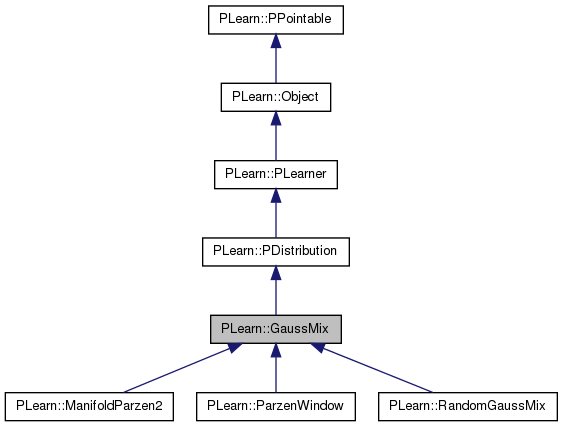
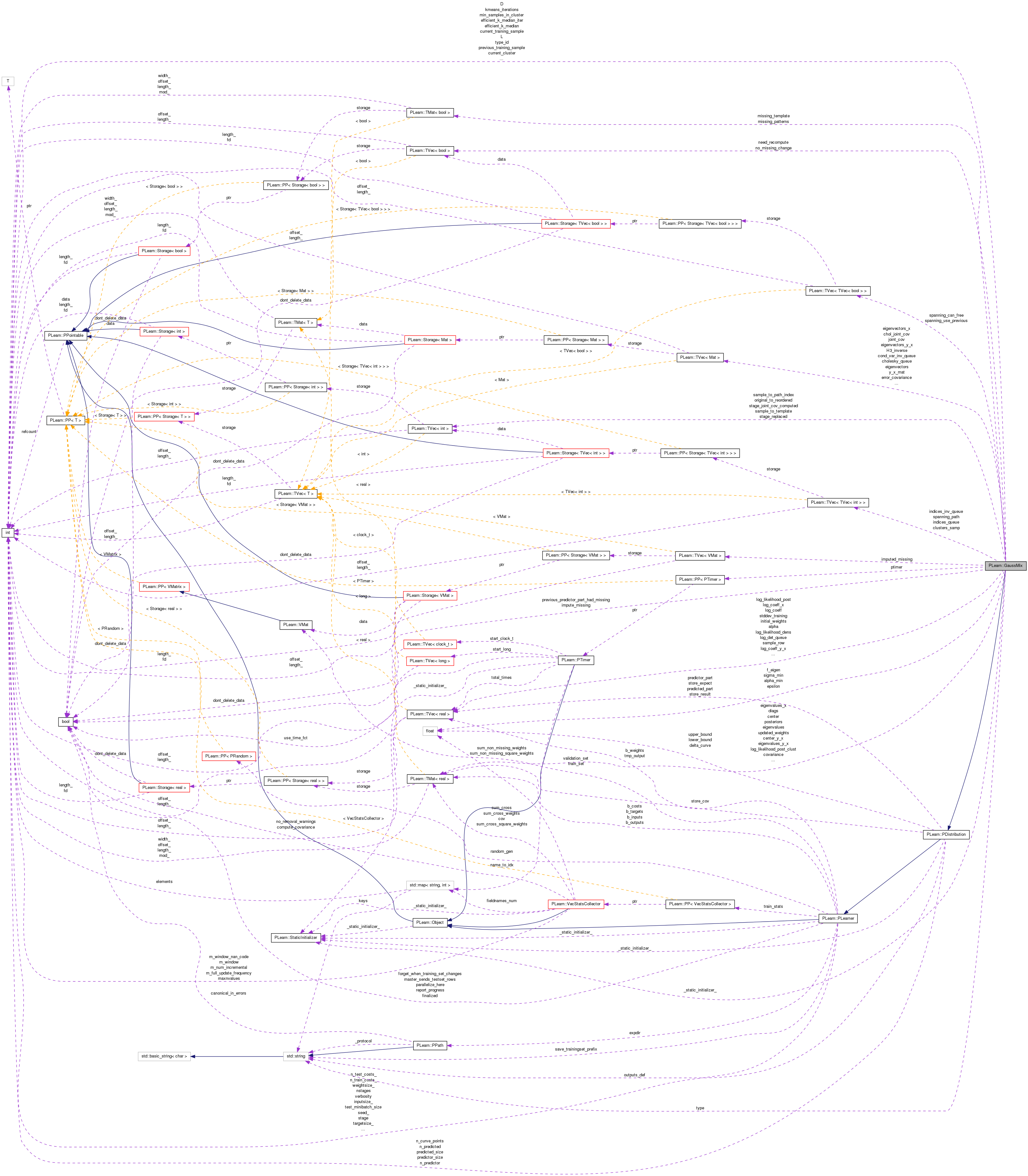
Public Member Functions | |
| GaussMix () | |
| Default constructor. | |
| virtual void | changeOptions (const map< string, string > &name_value) |
| Overridden in order to detect changes that require a call to forget(). | |
| virtual void | forget () |
| Reset the learner. | |
| virtual void | build () |
| Simply calls inherited::build() then build_(). | |
| virtual void | makeDeepCopyFromShallowCopy (CopiesMap &copies) |
| Transform a shallow copy into a deep copy. | |
| virtual string | classname () const |
| virtual OptionList & | getOptionList () const |
| virtual OptionMap & | getOptionMap () const |
| virtual RemoteMethodMap & | getRemoteMethodMap () const |
| virtual GaussMix * | deepCopy (CopiesMap &copies) const |
| virtual void | train () |
| Trains the model. | |
| virtual int | outputsize () const |
| Overridden to take into account new outputs computed. | |
| virtual TVec< string > | getTrainCostNames () const |
| Overridden to compute the training time. | |
| virtual void | setTrainingSet (VMat training_set, bool call_forget=true) |
| Overridden to reorder the dataset when efficient_missing == 2. | |
| virtual void | setPredictor (const Vec &predictor, bool call_parent=true) const |
| Set the value for the predictor part of the conditional probability. | |
| virtual real | log_density (const Vec &y) const |
| Return density p(y | x). | |
| virtual real | survival_fn (const Vec &y) const |
| Return survival fn = P(Y>y | x). | |
| virtual real | cdf (const Vec &y) const |
| Return cumulative density fn = P(Y<y | x). | |
| virtual void | expectation (Vec &mu) const |
| Compute E[Y | x]. | |
| virtual void | missingExpectation (const Vec &input, Vec &mu) |
| Return E[Y | x] where Y is the missing part in the 'input' vector, and x in the observed part. | |
| virtual void | variance (Mat &cov) const |
| Compute Var[Y | x] (currently not implemented). | |
| virtual void | generate (Vec &s) const |
| Generate a sample from this distribution. | |
Static Public Member Functions | |
| static string | _classname_ () |
| Declares name and deepCopy methods. | |
| static OptionList & | _getOptionList_ () |
| static RemoteMethodMap & | _getRemoteMethodMap_ () |
| static Object * | _new_instance_for_typemap_ () |
| static bool | _isa_ (const Object *o) |
| static void | _static_initialize_ () |
| static const PPath & | declaringFile () |
Public Attributes | |
| real | alpha_min |
| int | efficient_k_median |
| int | efficient_k_median_iter |
| int | efficient_missing |
| real | epsilon |
| real | f_eigen |
| bool | impute_missing |
| int | kmeans_iterations |
| int | L |
| int | max_samples_in_cluster |
| int | min_samples_in_cluster |
| int | n_eigen |
| real | sigma_min |
| string | type |
| Vec | alpha |
| Mat | center |
| Vec | sigma |
Static Public Attributes | |
| static StaticInitializer | _static_initializer_ |
Protected Member Functions | |
| void | generateFromGaussian (Vec &s, int given_gaussian) const |
| Generate a sample 's' from the given Gaussian. | |
| virtual bool | setPredictorPredictedSizes (int the_predictor_size, int the_predicted_size, bool call_parent=true) |
| In the 'general' conditional type, will precompute the covariance matrix of Y|x. | |
| void | setPredictorPredictedSizes_const () const |
| Main implementation of 'setPredictorPredictedSizes', that needs to be 'const' as it currently needs to be called in setPredictor(..). | |
| void | getInitialWeightsFrom (const VMat &vmat) |
| Fill the 'initial_weights' vector with the weights from the given VMatrix (which must have a weights column). | |
| virtual void | computeMeansAndCovariances () |
| Given the posteriors, fill the centers and covariance of each Gaussian. | |
| virtual void | computePosteriors () |
| Compute posteriors P(j | s_i) for each sample point and each Gaussian. | |
| void | computeAllLogLikelihoods (const Vec &sample, const Vec &log_like) |
| Fill the 'log_like' vector with the log-likelihood of each Gaussian for the given sample. | |
| real | computeLogLikelihood (const Vec &y, int j, bool is_predictor=false) const |
| Compute log p(y | x,j), with j < L the index of a mixture's component, and 'x' the current predictor part. | |
| real | precomputeGaussianLogCoefficient (const Vec &eigenvals, int dimension) const |
| Return log( 1 / sqrt( 2 Pi^dimension |C| ) ), i.e. | |
| void | precomputeAllGaussianLogCoefficients () |
| When type is 'general', fill the 'log_coeff' vector with the result of precomputeGaussianLogCoefficient(..) applied to each component of the mixture. | |
| void | resizeDataBeforeTraining () |
| Make sure everything has the right size when training starts. | |
| void | resizeDataBeforeUsing () |
| Make sure everything has the right size when the object is about to be used (e.g. | |
| bool | computeMixtureWeights (bool allow_replace=true) |
| Compute the weight of each Gaussian (the coefficient 'alpha'). | |
| void | replaceGaussian (int j) |
| Replace the j-th Gaussian with another one (probably because that one is not appropriate). | |
| void | updateSampleWeights () |
| Update the sample weights according to their initial weights and the current posterior probabilities (see documentation of 'updated_weights' for the exact formula). | |
| void | kmeans (const VMat &samples, int nclust, TVec< int > &clust_idx, Mat &clust, int maxit=9999) |
| Perform K-means. | |
| void | updateCholeskyFromPrevious (const Mat &chol_previous, Mat &chol_updated, const Mat &full_matrix, const TVec< int > &indices_previous, const TVec< int > &indices_updated) const |
| Fill 'chol_updated' with the Cholesky decomposition of the submatrix of 'full_matrix' corresponding to the selection of dimensions given by 'indices_updated'. | |
| void | updateInverseVarianceFromPrevious (const Mat &src, Mat &dst, const Mat &full, const TVec< int > &ind_src, const TVec< int > &ind_dst, real *src_log_det=0, real *dst_log_det=0) const |
| void | addToCovariance (const Vec &y, int j, const Mat &cov, real post) |
| virtual void | unknownOutput (char def, const Vec &input, Vec &output, int &k) const |
| Overridden so as to compute specific GaussMix outputs. | |
Static Protected Member Functions | |
| static void | declareOptions (OptionList &ol) |
| Declares this class' options. | |
| static void | traverse_tree (TVec< int > &path, TVec< bool > &span_can_free, TVec< bool > &span_use_previous, bool free_previous, bool use_previous, int index_node, int previous_node, const TVec< int > &parent, const TVec< TVec< int > > &children, const TVec< int > &message_up, const TVec< int > &message_down) |
| Recursive function to compute a spanning path from previously computed cost values (given by 'message_up' and 'message_down'). | |
Protected Attributes | |
| TVec< Mat > | H3_inverse |
| PP< PTimer > | ptimer |
| Used to measure the total training time. | |
| TMat< bool > | missing_patterns |
| All missing patterns found in the training set (stored in rows). | |
| TMat< bool > | missing_template |
| Missing patterns used as templates (obtained by k-median). | |
| int | current_cluster |
| Index of the current cluster whose spanning path is being walked on during training. | |
| TVec< int > | sample_to_path_index |
| The i-th element is the index of the i-th training sample in the spanning path that contains it (i.e. | |
| TVec< TVec< int > > | spanning_path |
| The k-th element is the list of ordered samples in the spanning path for the k-th cluster. | |
| TVec< TVec< bool > > | spanning_use_previous |
| The k-th element is a vector that indicates whether at each step in the spanning path of the k-th cluster, a sample should use the previous covariance matrix computed in the path (true), or the one stored one step before it (false). | |
| TVec< TVec< bool > > | spanning_can_free |
| The k-th element is a vector that indicates whether at each step in the spanning path of the k-th cluster, we should free the memory used by the previous covariance matrix (true), or we should instead keep this matrix for further use (false). | |
| Mat | log_likelihood_post_clust |
| Used to store the likelihood given by all Gaussians for each sample in the current cluster. | |
| TVec< TVec< int > > | clusters_samp |
| The k-th element is the list of samples in the k-th cluster. | |
| TVec< Mat > | cholesky_queue |
| The list of all cholesky decompositions (of covariance matrices) that need to be kept in memory during training. | |
| Vec | log_det_queue |
| TODO Document (list of determinants of covariance matrices of the. | |
| TVec< VMat > | imputed_missing |
| TODO Document (the VMats with the imputed missing values). | |
| TVec< Mat > | clust_imputed_missing |
| TODO Document (the mats with the imputed missing values by each. | |
| Vec | sum_of_posteriors |
| TODO Document (sum of all posteriors in computePosteriors()). | |
| TVec< bool > | no_missing_change |
| TODO Document. | |
| TVec< Mat > | cond_var_inv_queue |
| TVec< TVec< int > > | indices_queue |
| The list of all lists of dimension indices (of covariance matrices) that need to be kept in memory during training. | |
| TVec< TVec< int > > | indices_inv_queue |
| int | type_id |
| Set at build time, this integer value depends uniquely on the 'type' option. | |
| Vec | mean_training |
| Mean and standard deviation of the training set. | |
| Vec | stddev_training |
| TVec< Mat > | error_covariance |
| Mat | posteriors |
| The posterior probabilities P(j | s_i), where j is the index of a Gaussian and i is the index of a sample. | |
| Vec | initial_weights |
| The initial weights of the samples s_i in the training set, copied for efficiency concerns. | |
| Mat | updated_weights |
| A matrix whose j-th line is a Vec with the weights of each sample s_i for Gaussian j, i.e. | |
| TVec< Mat > | eigenvectors_x |
| The eigenvectors of the covariance of X. | |
| Mat | eigenvalues_x |
| The eigenvalues of the covariance of X. | |
| TVec< Mat > | y_x_mat |
| The product K2 * K1^-1 to compute E[Y|x]. | |
| TVec< Mat > | eigenvectors_y_x |
| The eigenvectors of the covariance of Y|x. | |
| Mat | eigenvalues_y_x |
| The eigenvalues of the covariance of Y|x. | |
| Mat | center_y_x |
| Used to store the conditional expectation E[Y | X = x]. | |
| Vec | log_p_j_x |
| The logarithm of P(j|x), where x is the predictor part. | |
| Vec | p_j_x |
| The probability P(j|x), where x is the predictor part (it is computed by exp(log_p_j_x)). | |
| Vec | log_coeff |
| The logarithm of the constant part in the joint Gaussian density: log(1/sqrt(2*pi^D * Det(C))). | |
| Vec | log_coeff_x |
| The logarithm of the constant part in P(X) and P(Y | X = x), similar to what 'log_coeff' is for the joint distribution P(X,Y). | |
| Vec | log_coeff_y_x |
| TVec< Mat > | joint_cov |
| The j-th element is the full covariance matrix for Gaussian j. | |
| TVec< Mat > | joint_inv_cov |
| TVec< Mat > | chol_joint_cov |
| The j-th element is the matrix L in the Cholesky decomposition S = L L' of the covariance matrix S of Gaussian j. | |
| TVec< int > | stage_joint_cov_computed |
| The (i,j)-th element is the matrix L in the Cholesky decomposition of the covariance for the pattern of missing values of the i-th template for the j-th Gaussian. | |
| TVec< int > | stage_replaced |
| Indicates at which stage the j-th Gaussian has been replaced (due to having a too low coefficient alpha[j] < alpha_min). | |
| TVec< int > | sample_to_template |
| The i-th element is the index of the missing template of sample i in the 'missing_template' matrix. | |
| int | current_training_sample |
| Hack to know that we are compute likelihood on a training sample. | |
| int | previous_training_sample |
| Index of the previous training sample whose likelihood (and associated covariance matrix) has been computed. | |
| bool | previous_predictor_part_had_missing |
| A boolean indicating whether or not the last predictor part set through setPredictor(..) had a missing value. | |
| Vec | y_centered |
| Storage vector to save some memory allocations. | |
| Mat | covariance |
| Storage for the (weighted) covariance matrix of the dataset. | |
| Vec | log_likelihood_dens |
| Temporary storage vector. | |
| TVec< bool > | need_recompute |
| TVec< int > | original_to_reordered |
| int | D |
| Mat | diags |
| Mat | eigenvalues |
| TVec< Mat > | eigenvectors |
| int | n_eigen_computed |
| int | nsamples |
Private Types | |
| typedef PDistribution | inherited |
Private Member Functions | |
| void | build_ () |
| This does the actual building. | |
Private Attributes | |
| Vec | log_likelihood_post |
| Temporary storage used when computing posteriors. | |
| Vec | sample_row |
Definition at line 49 of file GaussMix.h.
typedef PDistribution PLearn::GaussMix::inherited [private] |
Reimplemented from PLearn::PDistribution.
Reimplemented in PLearn::ManifoldParzen2, PLearn::ParzenWindow, and PLearn::RandomGaussMix.
Definition at line 54 of file GaussMix.h.
| PLearn::GaussMix::GaussMix | ( | ) |
Default constructor.
Definition at line 74 of file GaussMix.cc.
References current_training_sample, PLearn::PLearner::nstages, previous_training_sample, and ptimer.
:
ptimer(new PTimer()),
type_id(TYPE_UNKNOWN),
previous_predictor_part_had_missing(false),
D(-1),
n_eigen_computed(-1),
nsamples(-1),
alpha_min(1e-6),
efficient_k_median(1),
efficient_k_median_iter(100),
efficient_missing(0),
epsilon(1e-6),
f_eigen(0),
impute_missing(false),
kmeans_iterations(5),
L(1),
max_samples_in_cluster(-1),
min_samples_in_cluster(1),
n_eigen(-1),
sigma_min(1e-6),
type("spherical")
{
// Change the default value of 'nstages' to 10 to make the user aware that
// in general it should be higher than 1.
nstages = 10;
current_training_sample = -1;
previous_training_sample = -2; // Only use efficient_missing in training.
ptimer->newTimer("init_time");
ptimer->newTimer("training_time");
}
| string PLearn::GaussMix::_classname_ | ( | ) | [static] |
Declares name and deepCopy methods.
Reimplemented from PLearn::PDistribution.
Reimplemented in PLearn::ManifoldParzen2, PLearn::ParzenWindow, and PLearn::RandomGaussMix.
Definition at line 133 of file GaussMix.cc.
| OptionList & PLearn::GaussMix::_getOptionList_ | ( | ) | [static] |
Reimplemented from PLearn::PDistribution.
Reimplemented in PLearn::ManifoldParzen2, PLearn::ParzenWindow, and PLearn::RandomGaussMix.
Definition at line 133 of file GaussMix.cc.
| RemoteMethodMap & PLearn::GaussMix::_getRemoteMethodMap_ | ( | ) | [static] |
Reimplemented from PLearn::PDistribution.
Reimplemented in PLearn::ManifoldParzen2, PLearn::ParzenWindow, and PLearn::RandomGaussMix.
Definition at line 133 of file GaussMix.cc.
Reimplemented from PLearn::PDistribution.
Reimplemented in PLearn::ManifoldParzen2, PLearn::ParzenWindow, and PLearn::RandomGaussMix.
Definition at line 133 of file GaussMix.cc.
| Object * PLearn::GaussMix::_new_instance_for_typemap_ | ( | ) | [static] |
Reimplemented from PLearn::PDistribution.
Reimplemented in PLearn::ManifoldParzen2, PLearn::ParzenWindow, and PLearn::RandomGaussMix.
Definition at line 133 of file GaussMix.cc.
| StaticInitializer GaussMix::_static_initializer_ & PLearn::GaussMix::_static_initialize_ | ( | ) | [static] |
Reimplemented from PLearn::PDistribution.
Reimplemented in PLearn::ManifoldParzen2, PLearn::ParzenWindow, and PLearn::RandomGaussMix.
Definition at line 133 of file GaussMix.cc.
| void PLearn::GaussMix::addToCovariance | ( | const Vec & | y, |
| int | j, | ||
| const Mat & | cov, | ||
| real | post | ||
| ) | [protected] |
Definition at line 810 of file GaussMix.cc.
References PLearn::TVec< T >::append(), cond_var_inv_queue, current_cluster, current_training_sample, PLearn::fillItSymmetric(), i, impute_missing, indices_inv_queue, PLearn::is_missing(), PLearn::TMat< T >::isSymmetric(), j, joint_inv_cov, PLearn::TMat< T >::length(), PLearn::TVec< T >::length(), PLearn::matInvert(), PLearn::PDistribution::n_predictor, no_missing_change, PLASSERT, previous_training_sample, PLearn::TMat< T >::resize(), PLearn::TVec< T >::resize(), sample_to_path_index, PLearn::TMat< T >::setMod(), spanning_can_free, spanning_use_previous, updateInverseVarianceFromPrevious(), and PLearn::TMat< T >::width().
Referenced by computePosteriors().
{
//Profiler::start("addToCovariance");
PLASSERT( y.length() == cov.length() && y.length() == cov.width() );
PLASSERT( n_predictor == 0 );
PLASSERT( impute_missing );
static TVec<int> coord_missing;
static Mat inv_cov_y_missing;
static Mat H_inv_tpl;
static TVec<int> ind_inv_tpl;
static Mat H_inv_tot;
static TVec<int> ind_inv_tot;
coord_missing.resize(0);
for (int k = 0; k < y.length(); k++)
if (is_missing(y[k]))
coord_missing.append(k);
Mat& inv_cov_y = joint_inv_cov[j];
if (previous_training_sample == -1) {
int n_missing = coord_missing.length();
inv_cov_y_missing.setMod(n_missing);
inv_cov_y_missing.resize(n_missing, n_missing);
for (int k = 0; k < n_missing; k++)
for (int q = 0; q < n_missing; q++)
inv_cov_y_missing(k,q) =
inv_cov_y(coord_missing[k], coord_missing[q]);
cond_var_inv_queue.resize(1);
Mat& cond_inv = cond_var_inv_queue[0];
cond_inv.resize(inv_cov_y_missing.length(), inv_cov_y_missing.width());
matInvert(inv_cov_y_missing, cond_inv);
// Take care of numerical imprecisions that may cause the inverse not
// to be exactly symmetric.
PLASSERT( cond_inv.isSymmetric(false, true) );
fillItSymmetric(cond_inv);
indices_inv_queue.resize(1);
TVec<int>& ind = indices_inv_queue[0];
ind.resize(n_missing);
ind << coord_missing;
}
int path_index =
sample_to_path_index[current_training_sample];
int queue_index;
if (spanning_use_previous[current_cluster][path_index])
queue_index = cond_var_inv_queue.length() - 1;
else
queue_index = cond_var_inv_queue.length() - 2;
H_inv_tpl = cond_var_inv_queue[queue_index];
ind_inv_tpl = indices_inv_queue[queue_index];
int n_inv_tpl = H_inv_tpl.length();
H_inv_tot.resize(n_inv_tpl, n_inv_tpl);
ind_inv_tot = coord_missing;
bool same_covariance = no_missing_change[current_training_sample];
if (!same_covariance)
updateInverseVarianceFromPrevious(H_inv_tpl, H_inv_tot,
joint_inv_cov[j], ind_inv_tpl, ind_inv_tot);
Mat* the_H_inv = same_covariance ? &H_inv_tpl : &H_inv_tot;
TVec<int>* the_ind_inv = same_covariance? &ind_inv_tpl : &ind_inv_tot;
// Add this matrix (weighted by the coefficient 'post') to the given 'cov'
// full matrix.
for (int i = 0; i < the_ind_inv->length(); i++) {
int the_ind_inv_i = (*the_ind_inv)[i];
for (int k = 0; k < the_ind_inv->length(); k++)
cov(the_ind_inv_i, (*the_ind_inv)[k]) += post * (*the_H_inv)(i, k);
}
bool cannot_free =
!spanning_can_free[current_cluster][path_index];
if (cannot_free)
queue_index++;
cond_var_inv_queue.resize(queue_index + 1);
indices_inv_queue.resize(queue_index + 1);
static Mat dummy_mat;
H_inv_tpl = dummy_mat;
if (!same_covariance || cannot_free) {
Mat& M = cond_var_inv_queue[queue_index];
M.resize(H_inv_tot.length(), H_inv_tot.width());
M << H_inv_tot;
TVec<int>& ind = indices_inv_queue[queue_index];
ind.resize(the_ind_inv->length());
ind << *the_ind_inv;
}
//Profiler::end("addToCovariance");
}
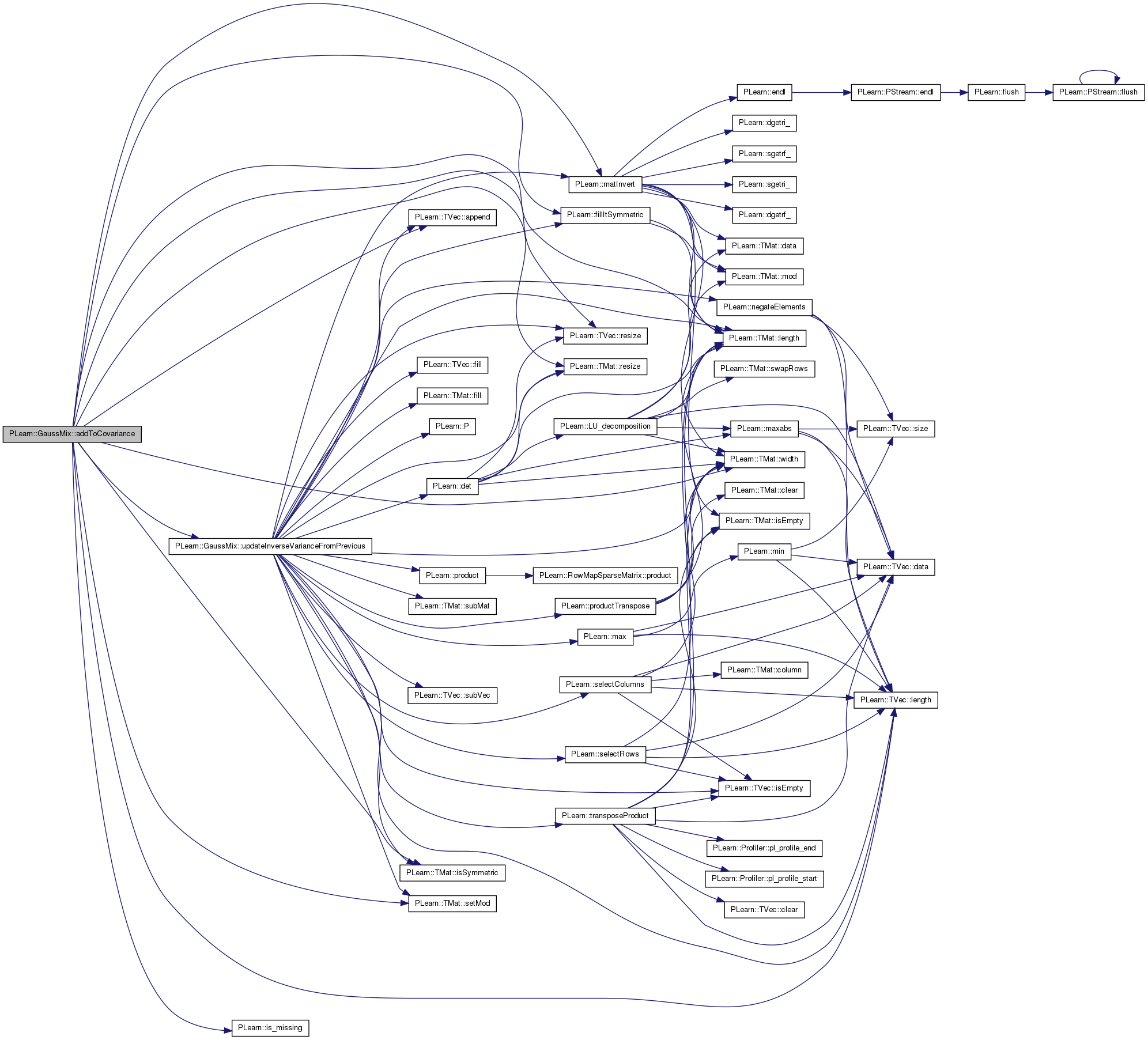

| void PLearn::GaussMix::build | ( | ) | [virtual] |
Simply calls inherited::build() then build_().
Reimplemented from PLearn::PDistribution.
Reimplemented in PLearn::ManifoldParzen2, PLearn::ParzenWindow, and PLearn::RandomGaussMix.
Definition at line 312 of file GaussMix.cc.
References PLearn::PDistribution::build(), and build_().
Referenced by PLearn::ParzenWindow::build(), and PLearn::ManifoldParzen2::build().
{
inherited::build();
build_();
}
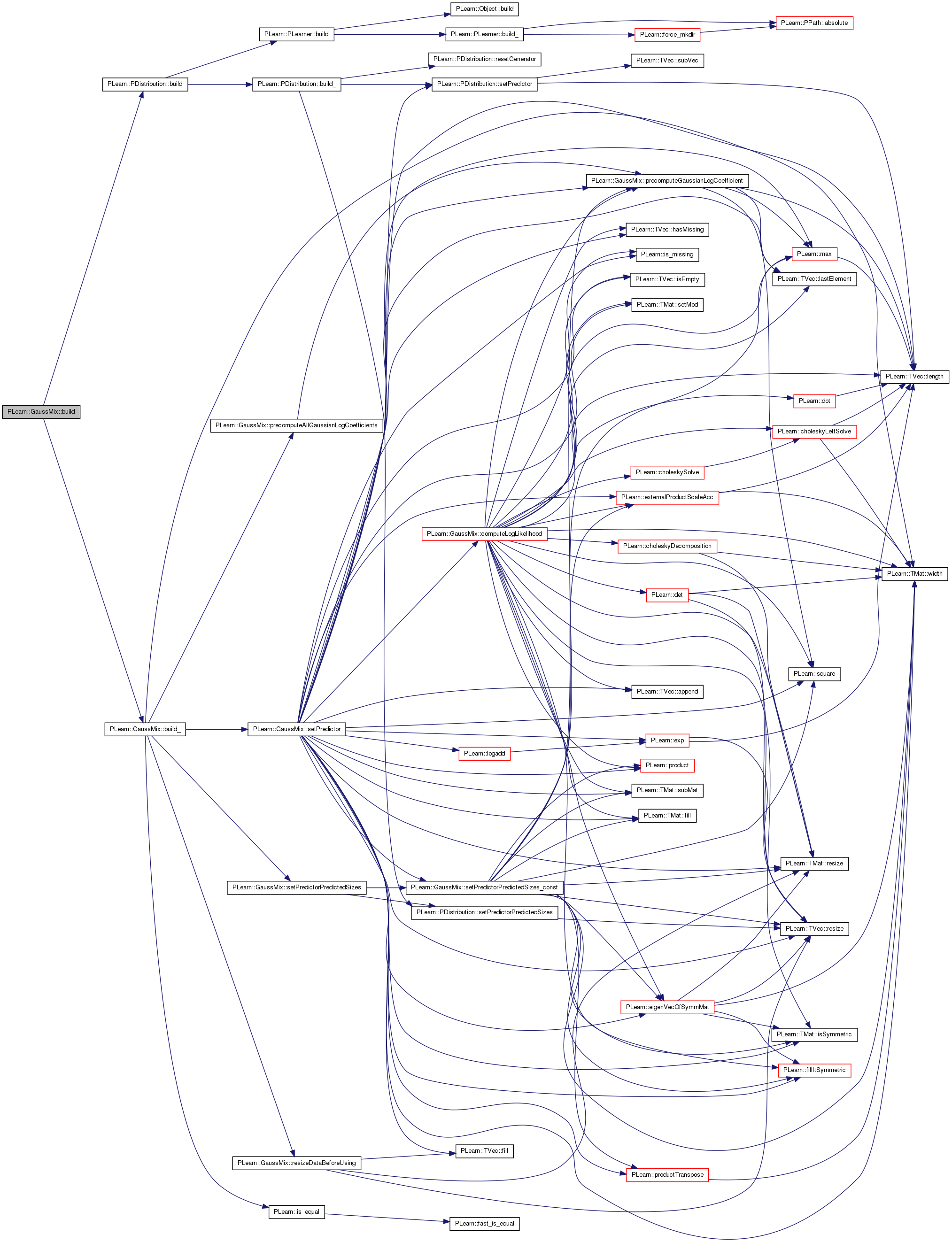

| void PLearn::GaussMix::build_ | ( | ) | [private] |
This does the actual building.
Reimplemented from PLearn::PDistribution.
Reimplemented in PLearn::ManifoldParzen2, PLearn::ParzenWindow, and PLearn::RandomGaussMix.
Definition at line 321 of file GaussMix.cc.
References center, D, eigenvalues, f_eigen, PLearn::is_equal(), n_eigen, n_eigen_computed, PLASSERT, PLERROR, precomputeAllGaussianLogCoefficients(), PLearn::PDistribution::predicted_size, PLearn::PDistribution::predictor_part, PLearn::PDistribution::predictor_size, resizeDataBeforeUsing(), setPredictor(), setPredictorPredictedSizes(), PLearn::PLearner::stage, type, TYPE_DIAGONAL, TYPE_GENERAL, type_id, TYPE_SPHERICAL, and PLearn::TMat< T >::width().
Referenced by build().
{
// Check type value.
if (type == "spherical") {
type_id = TYPE_SPHERICAL;
} else if (type == "diagonal") {
type_id = TYPE_DIAGONAL;
} else if (type == "general") {
type_id = TYPE_GENERAL;
} else
PLERROR("In GaussMix::build_ - Type '%s' is unknown", type.c_str());
// Special case for the 'f_eigen' option: 1 means we keep everything.
PLASSERT( f_eigen >= 0 && f_eigen <= 1 );
if (is_equal(f_eigen, 1))
n_eigen = -1;
// Guess values for 'D' and 'n_eigen_computed' if they are not provided
// (this could be the case for instance when specifying 'by hand' the
// parameters of the mixture of Gaussians).
// Make also a few checks to ensure all values are coherent.
if (stage > 0) {
PLASSERT( D == -1 || D == center.width() );
if (D == -1)
D = center.width();
PLASSERT( n_eigen_computed == -1 ||
n_eigen_computed == eigenvalues.width() );
if (n_eigen_computed == -1)
n_eigen_computed = eigenvalues.width();
PLASSERT( n_eigen == -1 || n_eigen_computed <= n_eigen + 1 );
PLASSERT( n_eigen_computed <= D );
}
// Make sure everything is correctly resized before using the object.
resizeDataBeforeUsing();
// If the learner is ready to be used, we need to precompute the logarithm
// of the constant coefficient of each Gaussian.
if (stage > 0)
precomputeAllGaussianLogCoefficients();
// Make GaussMix-specific operations for conditional distributions.
GaussMix::setPredictorPredictedSizes(predictor_size, predicted_size, false);
GaussMix::setPredictor(predictor_part, false);
}
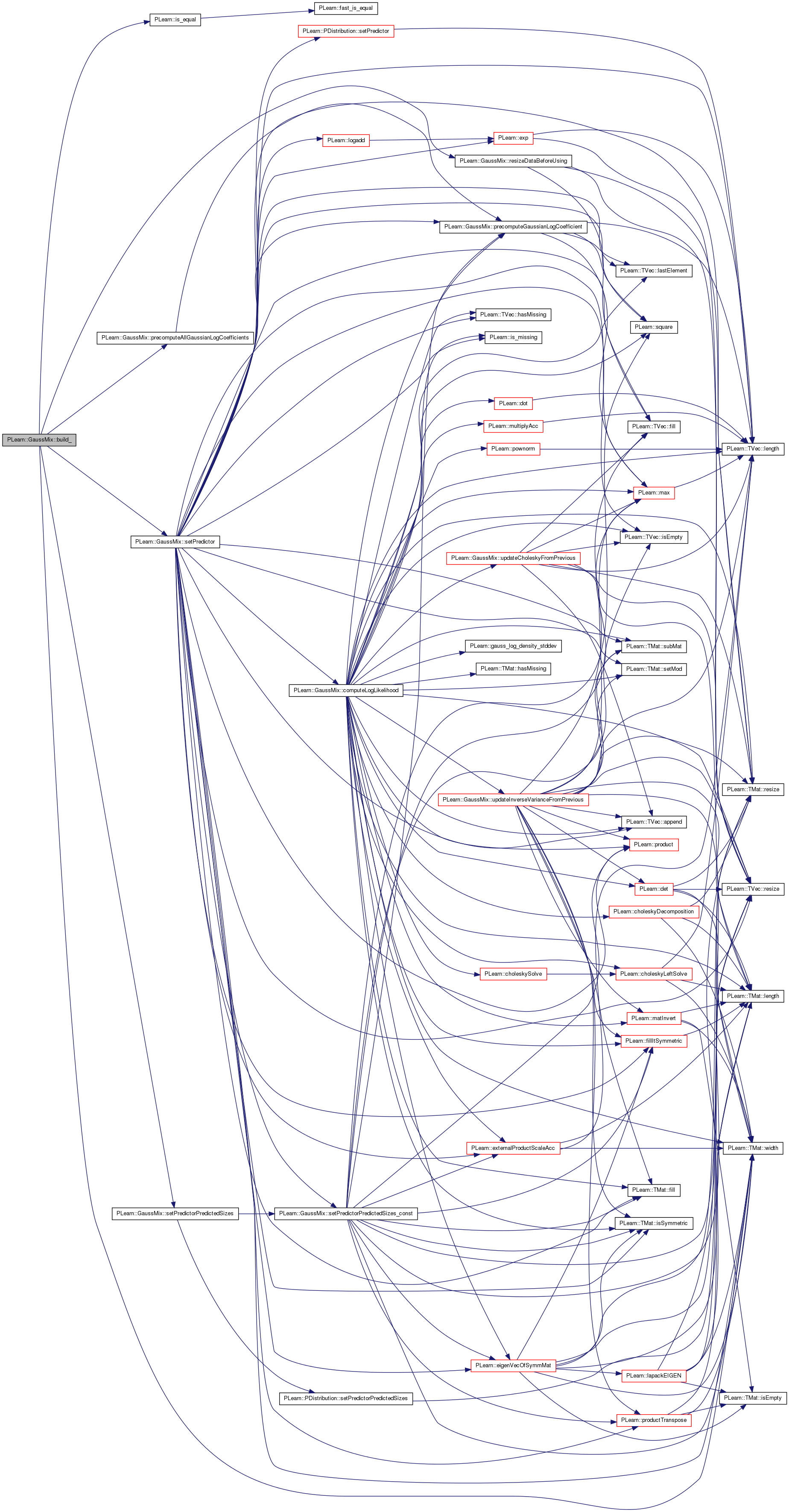

Return cumulative density fn = P(Y<y | x).
Reimplemented from PLearn::PDistribution.
Definition at line 4400 of file GaussMix.cc.
References MISSING_VALUE.
{
//PLERROR("cdf not implemented for GaussMix"); return 0.0;
return MISSING_VALUE;
}
| void PLearn::GaussMix::changeOptions | ( | const map< string, string > & | name_value | ) | [virtual] |
Overridden in order to detect changes that require a call to forget().
Reimplemented from PLearn::Object.
Definition at line 370 of file GaussMix.cc.
References PLearn::Object::changeOptions(), forget(), and PLearn::PLearner::stage.
{
// When 'n_eigen' is changed for a learner that is already trained, we need
// to call forget(), otherwise some asserts may fail during a subsequent
// build.
if (stage > 0 && (name_value.find("n_eigen") != name_value.end() ||
name_value.find("L") != name_value.end() ||
name_value.find("seed") != name_value.end() ||
name_value.find("sigma_min")!=name_value.end() ||
name_value.find("type") != name_value.end() ))
forget();
inherited::changeOptions(name_value);
}

| string PLearn::GaussMix::classname | ( | ) | const [virtual] |
Reimplemented from PLearn::PDistribution.
Reimplemented in PLearn::ManifoldParzen2, PLearn::ParzenWindow, and PLearn::RandomGaussMix.
Definition at line 133 of file GaussMix.cc.
| void PLearn::GaussMix::computeAllLogLikelihoods | ( | const Vec & | sample, |
| const Vec & | log_like | ||
| ) | [protected] |
Fill the 'log_like' vector with the log-likelihood of each Gaussian for the given sample.
Definition at line 1907 of file GaussMix.cc.
References computeLogLikelihood(), D, j, L, PLearn::TVec< T >::length(), and PLASSERT.
Referenced by computePosteriors().
{
PLASSERT( sample.length() == D );
PLASSERT( log_like.length() == L );
for (int j = 0; j < L; j++)
log_like[j] = computeLogLikelihood(sample, j);
}
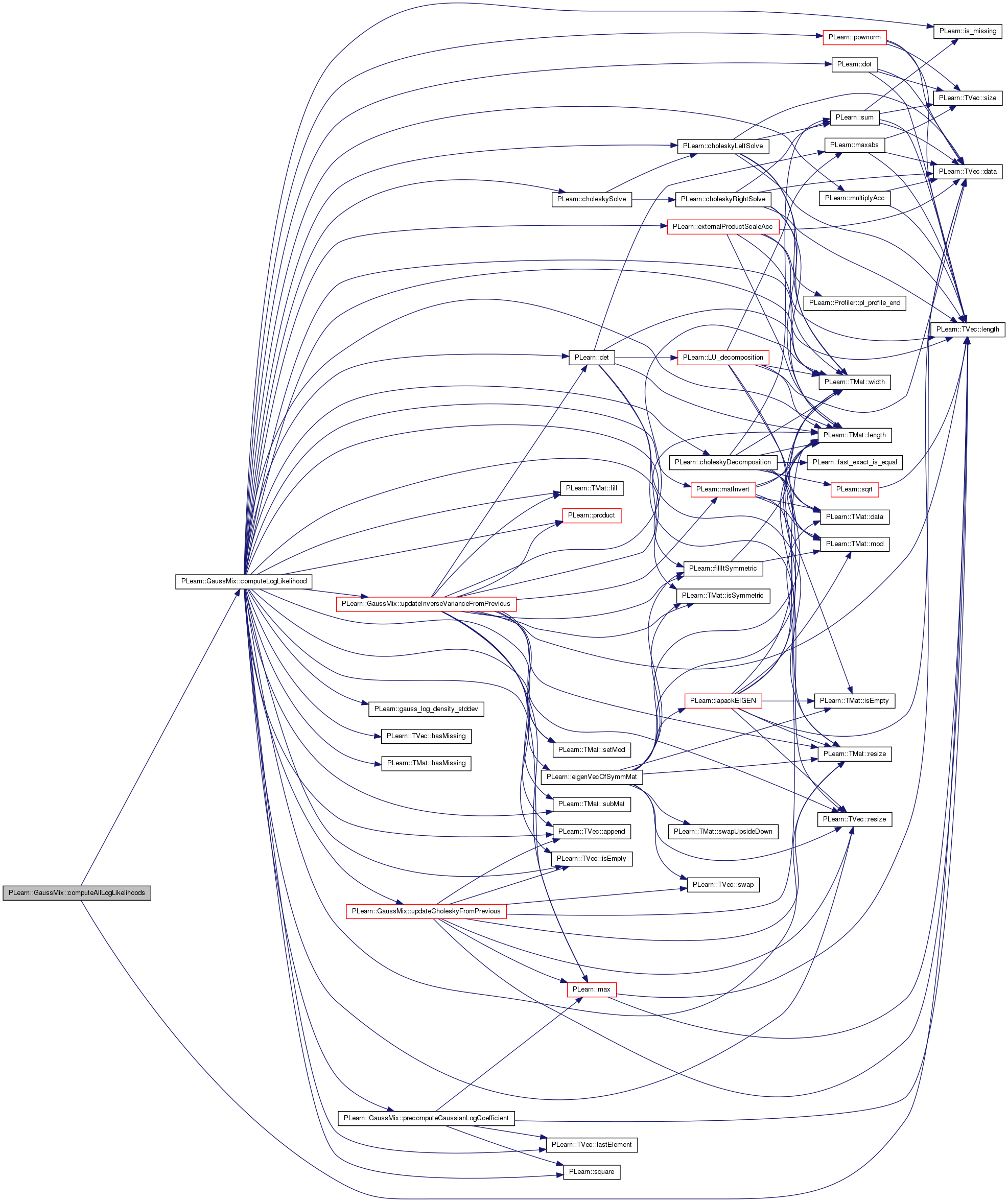

| real PLearn::GaussMix::computeLogLikelihood | ( | const Vec & | y, |
| int | j, | ||
| bool | is_predictor = false |
||
| ) | const [protected] |
Compute log p(y | x,j), with j < L the index of a mixture's component, and 'x' the current predictor part.
If 'is_predictor' is set to true, then it is the likelihood of the des that will be returned, i.e. log p(X = y | j).
Definition at line 908 of file GaussMix.cc.
References PLearn::TVec< T >::append(), center, center_y_x, cholesky_queue, PLearn::choleskyDecomposition(), PLearn::choleskyLeftSolve(), PLearn::choleskySolve(), clust_imputed_missing, current_cluster, current_training_sample, D, PLearn::det(), diags, PLearn::dot(), efficient_missing, eigenvalues, eigenvalues_x, eigenvalues_y_x, PLearn::eigenVecOfSymmMat(), eigenvectors, eigenvectors_x, eigenvectors_y_x, PLearn::externalProductScaleAcc(), PLearn::TMat< T >::fill(), PLearn::fillItSymmetric(), PLearn::gauss_log_density_stddev(), H3_inverse, PLearn::TVec< T >::hasMissing(), PLearn::TMat< T >::hasMissing(), i, impute_missing, imputed_missing, indices_queue, PLearn::is_missing(), PLearn::TVec< T >::isEmpty(), PLearn::TMat< T >::isSymmetric(), j, joint_cov, joint_inv_cov, L, PLearn::TVec< T >::lastElement(), PLearn::TMat< T >::length(), PLearn::TVec< T >::length(), Log2Pi, log_coeff, log_coeff_x, log_coeff_y_x, log_det_queue, PLearn::matInvert(), PLearn::max(), PLearn::multiplyAcc(), n, n_eigen, n_eigen_computed, PLearn::PDistribution::n_predicted, PLearn::PDistribution::n_predictor, need_recompute, no_missing_change, pl_log, PLASSERT, PLearn::pownorm(), precomputeGaussianLogCoefficient(), previous_training_sample, PLearn::product(), PLearn::TMat< T >::resize(), PLearn::TVec< T >::resize(), sample_to_path_index, PLearn::TMat< T >::setMod(), sigma, sigma_min, spanning_can_free, spanning_use_previous, PLearn::square(), PLearn::PLearner::stage, stage_joint_cov_computed, PLearn::TMat< T >::subMat(), TYPE_DIAGONAL, TYPE_GENERAL, type_id, TYPE_SPHERICAL, updateCholeskyFromPrevious(), updateInverseVarianceFromPrevious(), PLearn::TMat< T >::width(), and y_centered.
Referenced by computeAllLogLikelihoods(), computePosteriors(), PLearn::ManifoldParzen2::evaluate(), PLearn::ManifoldParzen2::evaluate_i_j(), log_density(), and setPredictor().
{
//Profiler::start("computeLogLikelihood");
static int size; // Size of the vector whose density is computed.
// Index where we start (usually 0 when 'is_predictor', and 'n_predictor'
// otherwise).
static int start;
// Storage of mean.
static Vec mu_y;
static Vec mu;
static Vec diag_j; // Points to the standard deviations of Gaussian j.
// Used to point to the correct eigenvalues / eigenvectors.
static Vec eigenvals;
static Mat eigenvecs;
// Stuff when there are missing values: we need to do a lot more
// computations (with the current rather dumb implementation).
static Vec mu_y_missing;
static Mat cov_y_missing;
static Mat dummy_storage;
static TVec<Mat> covs_y_missing;
static TVec<Vec> mus_y_missing;
static Vec y_missing;
static Vec eigenvals_missing;
static TVec<Vec> eigenvals_allj_missing;
static Mat* eigenvecs_missing;
static Mat eigenvecs_missing_storage;
static TVec<Mat> eigenvecs_allj_missing;
static TVec<int> non_missing;
static Mat work_mat1, work_mat2;
static Mat eigenvalues_x_miss;
static TVec<Mat> eigenvectors_x_miss;
static Mat full_cov;
static Mat cov_x_j;
static Vec y_non_missing;
static Vec center_non_missing;
static Mat cov_y_x;
// Dummy matrix and vector to release some storage pointers so that some
// matrices can be resized.
static Mat dummy_mat;
static Vec dummy_vec;
eigenvecs_missing = &eigenvecs_missing_storage;
Mat* the_cov_y_missing = &cov_y_missing;
Vec* the_mu_y_missing = &mu_y_missing;
// Will contain the final result (the desired log-likelihood).
real log_likelihood;
if (type_id == TYPE_SPHERICAL || type_id == TYPE_DIAGONAL) {
// Easy case: the covariance matrix is diagonal.
if (is_predictor) {
size = n_predictor;
start = 0;
} else {
size = n_predicted;
start = n_predictor;
}
mu_y = center(j).subVec(start, size);
if (type_id == TYPE_DIAGONAL) {
PLASSERT( diags.length() == L && diags.width() == n_predictor+n_predicted );
diag_j = diags(j).subVec(start, size);
}
log_likelihood = 0;
// x ~= N(mu_x, cov (diagonal))
// y|x ~= N(mu_y, cov (diagonal))
for (int k = 0; k < size; k++)
if (!is_missing(y[k])) {
real stddev =
type_id == TYPE_SPHERICAL ? sigma[j]
: diag_j[k];
stddev = max(sigma_min, stddev);
log_likelihood +=
gauss_log_density_stddev(y[k], mu_y[k], stddev);
}
} else {
PLASSERT( type_id == TYPE_GENERAL );
log_likelihood = 0; // Initialize resultresult to zero.
// TODO Put both cases (n_predictor == 0 and other) in same code (they are
// very close one to each other).
if (n_predictor == 0) {
// Simple case: there is no predictor part.
PLASSERT( !is_predictor );
PLASSERT( y.length() == n_predicted );
// When not in training mode, 'previous_training_sample' is set to
// -2, and 'current_training_sample' is set to -1.
// In such a case, it is not necessary to do all computations.
// TODO It would be good to have one single flag for both lines
// below. Maybe current_training_sample != -1 would be enough?
bool eff_missing = (efficient_missing == 1 ||
efficient_missing == 3 ) &&
(previous_training_sample != -2);
bool imp_missing = impute_missing &&
(current_training_sample != -1);
bool eff_naive_missing = (efficient_missing == 2) &&
(current_training_sample != -1);
if (y.hasMissing() || eff_missing || imp_missing) {
// TODO This will probably make the 'efficient_missing' method
// perform slower on data with no missing value. This should be
// optimized.
// We need to recompute almost everything.
// First the full covariance.
Mat& cov_y = joint_cov[j];
Mat* inv_cov_y = impute_missing ? &joint_inv_cov[j] : 0;
real var_min = square(sigma_min);
if (stage_joint_cov_computed[j] != this->stage) {
stage_joint_cov_computed[j] = this->stage;
cov_y.resize(D, D);
eigenvals = eigenvalues(j);
real lambda0 = max(var_min, eigenvals.lastElement());
cov_y.fill(0);
Mat& eigenvectors_j = eigenvectors[j];
PLASSERT( eigenvectors_j.width() == D );
for (int k = 0; k < n_eigen_computed - 1; k++)
externalProductScaleAcc(
cov_y, eigenvectors_j(k), eigenvectors_j(k),
max(var_min, eigenvals[k]) - lambda0);
for (int i = 0; i < D; i++)
cov_y(i,i) += lambda0;
// By construction, the resulting matrix is symmetric. However,
// it may happen that it is not exactly the case due to numerical
// approximations. Thus we ensure it is perfectly symmetric.
PLASSERT( cov_y.isSymmetric(false) );
fillItSymmetric(cov_y);
if (impute_missing) {
// We also need to compute the inverse covariance
// matrix.
PLASSERT( inv_cov_y );
inv_cov_y->resize(D, D);
inv_cov_y->fill(0);
real l0 = 1 / lambda0;
for (int k = 0; k < n_eigen_computed - 1; k++)
externalProductScaleAcc(
*inv_cov_y, eigenvectors_j(k),
eigenvectors_j(k),
1 / max(var_min, eigenvals[k]) - l0);
for (int i = 0; i < D; i++)
(*inv_cov_y)(i, i) += l0;
// For the same reason as above.
PLASSERT( inv_cov_y->isSymmetric(false) );
fillItSymmetric(*inv_cov_y);
}
/*
if (efficient_missing) {
// Now compute its Cholesky decomposition.
Mat& chol_cov_y = chol_joint_cov[j];
choleskyDecomposition(cov_y, chol_cov_y);
// And do the same for missing templates.
TVec<bool> miss_pattern;
for (int i = 0; i < efficient_k_median; i++) {
miss_pattern = missing_template(i);
int n_non_missing = miss_pattern.length();
non_missing.resize(0);
for (int k = 0; k < miss_pattern.length(); k++)
if (miss_pattern[k])
n_non_missing--;
else
non_missing.append(k);
cov_y_missing.resize(n_non_missing, n_non_missing);
for (int k = 0; k < n_non_missing; k++)
for (int q = 0; q < n_non_missing; q++)
cov_y_missing(k,q) =
cov_y(non_missing[k], non_missing[q]);
Mat& chol_cov_tpl = chol_cov_template(i, j);
choleskyDecomposition(cov_y_missing, chol_cov_tpl);
}
}
*/
}
/*
// Then extract what we want.
int tpl_idx;
TVec<bool> missing_tpl;
if (efficient_missing) {
PLASSERT( current_training_sample != -1 );
tpl_idx =
sample_to_template[current_training_sample];
missing_tpl = missing_template(tpl_idx);
}
*/
/*
static TVec<int> com_non_missing, add_non_missing, add_missing;
com_non_missing.resize(0);
add_non_missing.resize(0);
// 'add_missing' will contain those coordinate in the template
// covariance matrix that need to be deleted (because they are
// missing in the current template).
add_missing.resize(0);
*/
non_missing.resize(0);
static TVec<int> coord_missing;
coord_missing.resize(0);
// int count_tpl_dim = 0;
for (int k = 0; k < n_predicted; k++)
if (!is_missing(y[k]))
non_missing.append(k);
else
coord_missing.append(k);
int n_non_missing = non_missing.length();
if (eff_missing && previous_training_sample == -1) {
// No previous training sample: we need to compute from
// scratch the Cholesky decomposition.
the_cov_y_missing->setMod(n_non_missing);
the_cov_y_missing->resize(n_non_missing, n_non_missing);
for (int k = 0; k < n_non_missing; k++)
for (int q = 0; q < n_non_missing; q++)
(*the_cov_y_missing)(k,q) =
cov_y(non_missing[k], non_missing[q]);
cholesky_queue.resize(1);
// pout << "length = " << cholesky_queue.length() << endl;
Mat& chol = cholesky_queue[0];
if (efficient_missing == 1)
choleskyDecomposition(*the_cov_y_missing, chol);
else {
PLASSERT( efficient_missing == 3 );
log_det_queue.resize(1);
log_det_queue[0] = det(*the_cov_y_missing, true);
chol.resize(the_cov_y_missing->length(),
the_cov_y_missing->length());
PLASSERT( the_cov_y_missing->isSymmetric() );
matInvert(*the_cov_y_missing, chol);
// Commenting-out this assert: it can actually fail due
// to some numerical imprecisions during matrix
// inversion, which is a bit annoying.
// PLASSERT( chol.isSymmetric(false, true) );
fillItSymmetric(chol);
}
indices_queue.resize(1);
TVec<int>& ind = indices_queue[0];
ind.resize(n_non_missing);
ind << non_missing;
}
mu_y = center(j).subVec(0, n_predicted);
the_mu_y_missing->resize(n_non_missing);
y_missing.resize(n_non_missing);
// Fill in first the coordinates which are in the template,
// then the coordinates specific to this data point.
/*
static TVec<int> tot_non_missing;
if (efficient_missing) {
tot_non_missing.resize(com_non_missing.length() +
add_non_missing.length());
tot_non_missing.subVec(0, com_non_missing.length())
<< com_non_missing;
tot_non_missing.subVec(com_non_missing.length(),
add_non_missing.length())
<< add_non_missing;
for (int k = 0; k < tot_non_missing.length(); k++) {
mu_y_missing[k] = mu_y[tot_non_missing[k]];
y_missing[k] = y[tot_non_missing[k]];
}
}
*/
if (!eff_missing) {
if (!eff_naive_missing) {
dummy_storage.setMod(n_non_missing);
dummy_storage.resize(n_non_missing, n_non_missing);
the_cov_y_missing = &dummy_storage;
} else {
PLASSERT( efficient_missing == 2 );
covs_y_missing.resize(L);
Mat& cov_y_missing_j = covs_y_missing[j];
cov_y_missing_j.resize(n_non_missing, n_non_missing);
the_cov_y_missing = &cov_y_missing_j;
mus_y_missing.resize(L);
Vec& mu_y_missing_j = mus_y_missing[j];
mu_y_missing_j.resize(n_non_missing);
the_mu_y_missing = &mu_y_missing_j;
}
for (int k = 0; k < n_non_missing; k++)
y_missing[k] = y[non_missing[k]];
if (!eff_naive_missing ||
need_recompute[current_training_sample]) {
for (int k = 0; k < n_non_missing; k++) {
(*the_mu_y_missing)[k] = mu_y[non_missing[k]];
for (int q = 0; q < n_non_missing; q++) {
(*the_cov_y_missing)(k,q) =
cov_y(non_missing[k], non_missing[q]);
}
}
}
}
/*
if (n_non_missing == 0) {
log_likelihood = 0;
} else {*/
// Perform SVD of cov_y_missing.
if (!eff_missing) {
if (!eff_naive_missing ||
need_recompute[current_training_sample]) {
eigenvals_allj_missing.resize(L);
eigenvecs_allj_missing.resize(L);
// TODO We probably do not need this 'cov_backup', since
// the matrix 'the_cov_y_missing' should not be re-used.
// Once this is tested and verified, it could be removed
// for efficiency reasons.
static Mat cov_backup;
cov_backup.setMod(the_cov_y_missing->width());
cov_backup.resize(the_cov_y_missing->length(),
the_cov_y_missing->width());
cov_backup << *the_cov_y_missing;
eigenVecOfSymmMat(cov_backup, n_non_missing,
eigenvals_allj_missing[j],
eigenvecs_allj_missing[j]);
PLASSERT( eigenvals_allj_missing[j].length()==n_non_missing);
PLASSERT( !cov_backup.hasMissing() );
}
eigenvals_missing = eigenvals_allj_missing[j];
eigenvecs_missing = &eigenvecs_allj_missing[j];
}
real log_det = 0;
static Mat L_tpl;
static TVec<int> ind_tpl;
static Mat L_tot;
static TVec<int> ind_tot;
int n_tpl = -1;
int queue_index = -1;
int path_index = -1;
bool same_covariance = false;
real log_det_tot, log_det_tpl;
if (eff_missing) {
path_index =
sample_to_path_index[current_training_sample];
// pout << "path index = " << path_index << endl;
L_tot.resize(n_non_missing, n_non_missing);
if (spanning_use_previous[current_cluster][path_index])
queue_index = cholesky_queue.length() - 1;
else
queue_index = cholesky_queue.length() - 2;
L_tpl = cholesky_queue[queue_index];
ind_tpl = indices_queue[queue_index];
if (efficient_missing == 3)
log_det_tpl = log_det_queue[queue_index];
n_tpl = L_tpl.length();
L_tot.resize(n_tpl, n_tpl);
/*
ind_tot.resize(n_non_missing);
ind_tot << non_missing;
*/
ind_tot = non_missing;
// Optimization: detect when the same covariance matrix
// can be re-used.
// TODO What about just the dimensions being reordered?
// Are we losing time in such cases?
same_covariance =
ind_tpl.length() == ind_tot.length() &&
previous_training_sample >= 0;
if (same_covariance)
for (int i = 0; i < ind_tpl.length(); i++)
if (ind_tpl[i] != ind_tot[i]) {
same_covariance = false;
break;
}
/*
Mat tmp;
if (add_missing.length() > 0) {
tmp.resize(L_tot.length(), L_tot.width());
productTranspose(tmp, L_tot, L_tot);
VMat tmp_vm(tmp);
tmp_vm->saveAMAT("/u/delallea/tmp/before.amat", false,
true);
}
*/
// Remove some rows / columns.
/*
int p = add_missing.length() - 1;
for (int k = p; k >= 0; k--) {
choleskyRemoveDimension(L_tot, add_missing[k]); //(-k+p);
*/
/*
tmp.resize(L_tot.length(), L_tot.width());
productTranspose(tmp, L_tot, L_tot);
VMat tmp_vm(tmp);
tmp_vm->saveAMAT("/u/delallea/tmp/before_" +
tostring(add_missing[k]) + ".amat", false,
true);
*/
/*
}
*/
}
if ((efficient_missing == 1 || efficient_missing == 3) &&
current_training_sample >= 0)
no_missing_change[current_training_sample] =
same_covariance;
// Now we must perform updates to compute the Cholesky
// decomposition of interest.
static Vec new_vec;
int n = -1;
Mat* the_L = 0;
if (eff_missing) {
//L_tot.resize(n_non_missing, n_non_missing);
/*
for (int k = 0; k < add_non_missing.length(); k++) {
new_vec.resize(L_tot.length() + 1);
for (int q = 0; q < new_vec.length(); q++)
new_vec[q] = cov_y(tot_non_missing[q],
add_non_missing[k]);
choleskyAppendDimension(L_tot, new_vec);
}
*/
if (!same_covariance) {
if (efficient_missing == 1) {
//Profiler::start("updateCholeskyFromPrevious, em1");
updateCholeskyFromPrevious(L_tpl, L_tot,
joint_cov[j], ind_tpl, ind_tot);
//Profiler::end("updateCholeskyFromPrevious, em1");
} else {
PLASSERT( efficient_missing == 3 );
//Profiler::start("updateInverseVarianceFromPrevious, em3");
updateInverseVarianceFromPrevious(L_tpl, L_tot,
joint_cov[j], ind_tpl, ind_tot,
&log_det_tpl, &log_det_tot);
//Profiler::end("updateInverseVarianceFromPrevious, em3");
#if 0
// Check that the inverse is correctly computed.
VMat L_tpl_vm(L_tpl);
VMat L_tot_vm(L_tot);
VMat joint_cov_vm(joint_cov[j]);
Mat data_tpl(1, ind_tpl.length());
for (int q = 0; q < ind_tpl.length(); q++)
data_tpl(0, q) = ind_tpl[q];
Mat data_tot(1, ind_tot.length());
for (int q = 0; q < ind_tot.length(); q++)
data_tot(0, q) = ind_tot[q];
VMat ind_tpl_vm(data_tpl);
VMat ind_tot_vm(data_tot);
L_tpl_vm->saveAMAT("/u/delallea/tmp/L_tpl_vm.amat",
false, true);
L_tot_vm->saveAMAT("/u/delallea/tmp/L_tot_vm.amat",
false, true);
joint_cov_vm->saveAMAT("/u/delallea/tmp/joint_cov_vm.amat",
false, true);
ind_tpl_vm->saveAMAT("/u/delallea/tmp/ind_tpl_vm.amat",
false, true);
ind_tot_vm->saveAMAT("/u/delallea/tmp/ind_tot_vm.amat",
false, true);
#endif
}
}
// Note to myself: indices in ind_tot will be changed.
// Debug check.
/*
static Mat tmp_mat;
tmp_mat.resize(L_tot.length(), L_tot.length());
productTranspose(tmp_mat, L_tot, L_tot);
// pout << "max = " << max(tmp_mat) << endl;
// pout << "min = " << min(tmp_mat) << endl;
*/
the_L = same_covariance ? &L_tpl : &L_tot;
real* the_log_det = same_covariance ? &log_det_tpl
: &log_det_tot;
n = the_L->length();
if (efficient_missing == 1) {
for (int i = 0; i < n; i++)
log_det += pl_log((*the_L)(i, i));
} else {
PLASSERT( efficient_missing == 3 );
#if 0
VMat the_L_vm(*the_L);
the_L_vm->saveAMAT("/u/delallea/tmp/L.amat", false,
true);
#endif
if (is_missing(*the_log_det)) {
// That can happen due to numerical imprecisions.
// In such a case we have to recompute the
// determinant and the inverse.
PLASSERT( !same_covariance );
the_cov_y_missing->setMod(n_non_missing);
the_cov_y_missing->resize(n_non_missing, n_non_missing);
for (int k = 0; k < n_non_missing; k++)
for (int q = 0; q < n_non_missing; q++)
(*the_cov_y_missing)(k,q) =
cov_y(non_missing[k], non_missing[q]);
*the_log_det = det((*the_cov_y_missing), true);
matInvert(*the_cov_y_missing, *the_L);
fillItSymmetric(*the_L);
}
// Note: we need to multiply the log-determinant by 0.5
// compared to 'efficient_missing == 1' because the
// determinant computed from Cholesky is the one for L,
// which is the squared root of the one of the full
// matrix.
log_det += 0.5 * *the_log_det;
}
PLASSERT( !(isnan(log_det) || isinf(log_det)) );
log_likelihood = -0.5 * (n * Log2Pi) - log_det;
}
y_centered.resize(n_non_missing);
if (!eff_missing) {
mu_y = *the_mu_y_missing;
eigenvals = eigenvals_missing;
eigenvecs = *eigenvecs_missing;
y_centered << y_missing;
y_centered -= mu_y;
}
real* center_j = center[j];
if (eff_missing) {
for (int k = 0; k < n_non_missing; k++) {
int ind_tot_k = ind_tot[k];
y_centered[k] =
y[ind_tot_k] - center_j[ind_tot_k];
}
static Vec tmp_vec1;
if (impute_missing && current_training_sample >= 0) {
// We need to store the conditional expectation of the
// sample missing values.
static Vec tmp_vec2;
tmp_vec1.resize(the_L->length());
tmp_vec2.resize(the_L->length());
if (efficient_missing == 1)
choleskySolve(*the_L, y_centered, tmp_vec1, tmp_vec2);
else {
PLASSERT( efficient_missing == 3 );
product(tmp_vec1, *the_L, y_centered);
}
static Mat K2;
int ind_tot_length = ind_tot.length();
K2.resize(cov_y.length() - ind_tot_length,
ind_tot.length());
for (int i = 0; i < K2.length(); i++)
for (int k = 0; k < K2.width(); k++)
K2(i,k) = cov_y(coord_missing[i],
non_missing[k]);
static Vec cond_mean;
cond_mean.resize(coord_missing.length());
product(cond_mean, K2, tmp_vec1);
static Vec full_vec;
// TODO Right now, we store the full data vector. It
// may be more efficient to only store the missing
// values.
full_vec.resize(D);
full_vec << y;
for (int i = 0; i < coord_missing.length(); i++)
full_vec[coord_missing[i]] =
cond_mean[i] + center_j[coord_missing[i]];
clust_imputed_missing[j](path_index) << full_vec;
}
if (n > 0) {
if (efficient_missing == 1) {
tmp_vec1.resize(y_centered.length());
choleskyLeftSolve(*the_L, y_centered, tmp_vec1);
log_likelihood -= 0.5 * pownorm(tmp_vec1);
} else {
PLASSERT( efficient_missing == 3 );
log_likelihood -= 0.5 * dot(y_centered, tmp_vec1);
}
}
// Now remember L_tot for the generations to come.
// TODO This could probably be optimized to avoid useless
// copies of the covariance matrix.
bool cannot_free =
!spanning_can_free[current_cluster][path_index];
if (cannot_free)
queue_index++;
cholesky_queue.resize(queue_index + 1);
indices_queue.resize(queue_index + 1);
if (efficient_missing == 3)
log_det_queue.resize(queue_index + 1);
// pout << "length = " << cholesky_queue.length() << endl;
// Free a reference to element in cholesky_queue. This
// is needed because this matrix is going to be resized.
L_tpl = dummy_mat;
if (!same_covariance || cannot_free) {
Mat& chol = cholesky_queue[queue_index];
chol.resize(L_tot.length(), L_tot.width());
chol << L_tot;
TVec<int>& ind = indices_queue[queue_index];
ind.resize(ind_tot.length());
ind << ind_tot;
if (efficient_missing == 3)
log_det_queue[queue_index] = log_det_tot;
}
// pout << "queue_index = " << queue_index << endl;
}
if (!eff_missing) {
// real squared_norm_y_centered = pownorm(y_centered);
int n_eig = n_non_missing;
real lambda0 = var_min;
if (!eigenvals.isEmpty() && eigenvals.lastElement() > lambda0)
lambda0 = eigenvals.lastElement();
PLASSERT( lambda0 > 0 );
real one_over_lambda0 = 1.0 / lambda0;
log_likelihood = precomputeGaussianLogCoefficient(
eigenvals, n_non_missing);
static Vec y_centered_copy;
y_centered_copy.resize(y_centered.length());
y_centered_copy << y_centered; // Backup vector.
for (int k = 0; k < n_eig - 1; k++) {
real lambda = max(var_min, eigenvals[k]);
PLASSERT( lambda > 0 );
Vec eigen_k = eigenvecs(k);
real dot_k = dot(eigen_k, y_centered);
log_likelihood -= 0.5 * square(dot_k) / lambda;
multiplyAcc(y_centered, eigen_k, -dot_k);
}
log_likelihood -=
0.5 * pownorm(y_centered) * one_over_lambda0;
y_centered << y_centered_copy; // Restore original vector.
#if 0
// Old code, that had stability issues when dealing with
// large numbers.
// log_likelihood -= 0.5 * 1/lambda_0 * ||y - mu||^2
log_likelihood -=
0.5 * one_over_lambda0 * squared_norm_y_centered;
for (int k = 0; k < n_eig - 1; k++) {
// log_likelihood -= 0.5 * (1/lambda_k - 1/lambda_0)
// * ((y - mu)'.v_k)^2
real lambda = max(var_min, eigenvals[k]);
PLASSERT( lambda > 0 );
if (lambda > lambda0)
log_likelihood -=
0.5 * (1.0 / lambda - one_over_lambda0)
* square(dot(eigenvecs(k), y_centered));
}
#endif
// Release pointer to 'eigenvecs_missing'.
eigenvecs = dummy_mat;
eigenvecs_missing = &eigenvecs_missing_storage;
if (impute_missing && current_training_sample >= 0) {
// We need to store the conditional expectation of the
// sample missing values.
// For this we compute H3^-1, since this expectation is
// equal to mu_y - H3^-1 H2 (x - mu_x).
static Mat H3;
static Mat H2;
Mat& H3_inv = H3_inverse[j];
int n_missing = coord_missing.length();
if (!eff_naive_missing ||
need_recompute[current_training_sample]) {
H3.setMod(n_missing);
H3.resize(n_missing, n_missing);
H3_inv.resize(n_missing, n_missing);
for (int i = 0; i < n_missing; i++)
for (int k = 0; k < n_missing; k++)
H3(i,k) = (*inv_cov_y)(coord_missing[i],
coord_missing[k]);
PLASSERT( H3.isSymmetric(true, true) );
matInvert(H3, H3_inv);
// PLASSERT( H3_inv.isSymmetric(false, true) );
fillItSymmetric(H3_inv);
}
H2.resize(n_missing, n_non_missing);
for (int i = 0; i < n_missing; i++)
for (int k = 0; k < n_non_missing; k++)
H2(i,k) = (*inv_cov_y)(coord_missing[i],
non_missing[k]);
static Vec H2_y_centered;
H2_y_centered.resize(n_missing);
product(H2_y_centered, H2, y_centered);
static Vec cond_mean;
cond_mean.resize(n_missing);
product(cond_mean, H3_inv, H2_y_centered);
static Vec full_vec;
// TODO Right now, we store the full data vector. It
// may be more efficient to only store the missing
// values.
full_vec.resize(D);
full_vec << y;
for (int i = 0; i < n_missing; i++)
full_vec[coord_missing[i]] =
center_j[coord_missing[i]] - cond_mean[i];
PLASSERT( !full_vec.hasMissing() );
imputed_missing[j]->putRow(current_training_sample,
full_vec);
}
}
//}
} else {
log_likelihood = log_coeff[j];
mu_y = center(j).subVec(0, n_predicted);
eigenvals = eigenvalues(j);
eigenvecs = eigenvectors[j];
y_centered.resize(n_predicted);
y_centered << y;
y_centered -= mu_y;
real squared_norm_y_centered = pownorm(y_centered);
real var_min = square(sigma_min);
int n_eig = n_eigen_computed;
real lambda0 = max(var_min, eigenvals[n_eig - 1]);
PLASSERT( lambda0 > 0 );
real one_over_lambda0 = 1.0 / lambda0;
// log_likelihood -= 0.5 * 1/lambda_0 * ||y - mu||^2
log_likelihood -= 0.5 * one_over_lambda0 * squared_norm_y_centered;
for (int k = 0; k < n_eig - 1; k++) {
// log_likelihood -= 0.5 * (1/lambda_k - 1/lambda_0)
// * ((y - mu)'.v_k)^2
real lambda = max(var_min, eigenvals[k]);
PLASSERT( lambda > 0 );
if (lambda > lambda0)
log_likelihood -= 0.5 * (1.0 / lambda - one_over_lambda0)
* square(dot(eigenvecs(k), y_centered));
}
}
} else {
if (y.hasMissing()) {
// TODO Code duplication is ugly!
if (is_predictor) {
non_missing.resize(0);
for (int k = 0; k < y.length(); k++)
if (!is_missing(y[k]))
non_missing.append(k);
int n_non_missing = non_missing.length();
int n_predicted_ext = n_predicted + (n_predictor - n_non_missing);
work_mat1.resize(n_predicted_ext, n_non_missing);
work_mat2.resize(n_predicted_ext, n_predicted_ext);
real var_min = square(sigma_min);
eigenvalues_x_miss.resize(L, n_non_missing);
eigenvectors_x_miss.resize(L);
// Compute the mean and covariance of x and y|x for the j-th
// Gaussian (we will need them to compute the likelihood).
// TODO Do we really compute the mean of y|x here?
// TODO This is pretty ugly but it seems to work: replace by
// better-looking code.
// First we compute the joint covariance matrix from the
// eigenvectors and eigenvalues:
// full_cov = sum_k (lambda_k - lambda0) v_k v_k' + lambda0.I
PLASSERT( n_predictor + n_predicted == D );
Mat& full_cov_j = full_cov;
full_cov_j.resize(D, D);
eigenvals = eigenvalues(j);
real lambda0 = max(var_min, eigenvals[n_eigen_computed - 1]);
full_cov_j.fill(0);
Mat& eigenvectors_j = eigenvectors[j];
PLASSERT( eigenvectors_j.width() == D );
for (int k = 0; k < n_eigen_computed - 1; k++)
externalProductScaleAcc(
full_cov_j, eigenvectors_j(k),
eigenvectors_j(k),
max(var_min, eigenvals[k]) - lambda0);
for (int i = 0; i < D; i++)
full_cov_j(i,i) += lambda0;
// By construction, the resulting matrix is symmetric. However,
// it may happen that it is not exactly the case due to numerical
// approximations. Thus we ensure it is perfectly symmetric.
PLASSERT( full_cov_j.isSymmetric(false) );
fillItSymmetric(full_cov_j);
// Extract the covariance of the predictor x.
Mat cov_x_j_miss = full_cov.subMat(0, 0, n_predictor, n_predictor);
cov_x_j.resize(n_non_missing, n_non_missing);
for (int k = 0; k < n_non_missing; k++)
for (int p = k; p < n_non_missing; p++)
cov_x_j(k,p) = cov_x_j(p,k) =
cov_x_j_miss(non_missing[k], non_missing[p]);
// Compute its SVD.
eigenvectors_x_miss[j].resize(n_non_missing, n_non_missing);
eigenvals = eigenvalues_x_miss(j);
eigenVecOfSymmMat(cov_x_j, n_non_missing, eigenvals,
eigenvectors_x_miss[j]);
y_non_missing.resize(n_non_missing);
center_non_missing.resize(n_non_missing);
for (int k = 0; k < n_non_missing; k++) {
center_non_missing[k] = center(j, non_missing[k]);
y_non_missing[k] = y[non_missing[k]];
}
log_likelihood =
precomputeGaussianLogCoefficient(eigenvals, n_non_missing);
eigenvecs = eigenvectors_x_miss[j];
y_centered.resize(n_non_missing);
y_centered << y_non_missing;
mu = center_non_missing;
} else {
// We need to re-do everything again, now this sucks!
// First the full covariance (of y|x).
Mat& cov_y = cov_y_x;
real var_min = square(sigma_min);
cov_y.resize(n_predicted, n_predicted);
eigenvals = eigenvalues_y_x(j);
real lambda0 = max(var_min, eigenvals.lastElement());
cov_y.fill(0);
Mat& eigenvectors_j = eigenvectors_y_x[j];
int n_eig = eigenvectors_j.length();
PLASSERT( eigenvectors_j.width() == n_predicted );
for (int k = 0; k < n_eig - 1; k++)
externalProductScaleAcc(
cov_y, eigenvectors_j(k), eigenvectors_j(k),
max(var_min, eigenvals[k]) - lambda0);
for (int i = 0; i < n_predicted; i++)
cov_y(i,i) += lambda0;
// By construction, the resulting matrix is symmetric. However,
// it may happen that it is not exactly the case due to numerical
// approximations. Thus we ensure it is perfectly symmetric.
PLASSERT( cov_y.isSymmetric(false) );
fillItSymmetric(cov_y);
// Then extract what we want.
non_missing.resize(0);
for (int k = 0; k < n_predicted; k++)
if (!is_missing(y[k]))
non_missing.append(k);
mu_y = center_y_x(j);
int n_non_missing = non_missing.length();
the_mu_y_missing->resize(n_non_missing);
y_missing.resize(n_non_missing);
the_cov_y_missing->resize(n_non_missing, n_non_missing);
for (int k = 0; k < n_non_missing; k++) {
(*the_mu_y_missing)[k] = mu_y[non_missing[k]];
y_missing[k] = y[non_missing[k]];
for (int q = 0; q < n_non_missing; q++) {
(*the_cov_y_missing)(k,q) =
cov_y(non_missing[k], non_missing[q]);
}
}
if (n_non_missing == 0) {
log_likelihood = 0;
} else {
// Perform SVD of cov_y_missing.
eigenVecOfSymmMat(*the_cov_y_missing, n_non_missing,
eigenvals_missing, *eigenvecs_missing);
mu_y = *the_mu_y_missing;
eigenvals = eigenvals_missing;
eigenvecs = *eigenvecs_missing;
y_centered.resize(n_non_missing);
y_centered << y_missing;
y_centered -= mu_y;
real squared_norm_y_centered = pownorm(y_centered);
int n_eigen = n_non_missing;
lambda0 = max(var_min, eigenvals.lastElement());
PLASSERT( lambda0 > 0 );
real one_over_lambda0 = 1.0 / lambda0;
log_likelihood = precomputeGaussianLogCoefficient(
eigenvals, n_non_missing);
// log_likelihood -= 0.5 * 1/lambda_0 * ||y - mu||^2
log_likelihood -=
0.5 * one_over_lambda0 * squared_norm_y_centered;
for (int k = 0; k < n_eigen - 1; k++) {
// log_likelihood -= 0.5 * (1/lambda_k - 1/lambda_0)
// * ((y - mu)'.v_k)^2
real lambda = max(var_min, eigenvals[k]);
PLASSERT( lambda > 0 );
if (lambda > lambda0)
log_likelihood -=
0.5 * (1.0 / lambda - one_over_lambda0)
* square(dot(eigenvecs(k), y_centered));
}
// Allow future resize of 'eigenvecs_missing'.
eigenvecs = dummy_mat;
}
//Profiler::end("computeLogLikelihood");
return log_likelihood;
}
if (y_centered.length() > 0) {
y_centered -= mu;
real squared_norm_y_centered = pownorm(y_centered);
real var_min = square(sigma_min);
int n_eig = eigenvals.length();
real lambda0 = max(var_min, eigenvals.lastElement());
PLASSERT( lambda0 > 0 );
real one_over_lambda0 = 1.0 / lambda0;
// log_likelihood -= 0.5 * 1/lambda_0 * ||y - mu||^2
log_likelihood -= 0.5 * one_over_lambda0 * squared_norm_y_centered;
for (int k = 0; k < n_eig - 1; k++) {
// log_likelihood -= 0.5 * (1/lambda_k - 1/lambda_0)
// * ((y - mu)'.v_k)^2
real lambda = max(var_min, eigenvals[k]);
PLASSERT( lambda > 0 );
PLASSERT( lambda >= lambda0 );
if (lambda > lambda0)
log_likelihood -= 0.5 * (1.0 / lambda - one_over_lambda0)
* square(dot(eigenvecs(k), y_centered));
}
}
} else {
if (is_predictor) {
log_likelihood = log_coeff_x[j];
mu = center(j).subVec(0, n_predictor);
eigenvals = eigenvalues_x(j);
eigenvecs = eigenvectors_x[j];
y_centered.resize(n_predictor);
} else {
log_likelihood = log_coeff_y_x[j];
mu = center_y_x(j);
eigenvals = eigenvalues_y_x(j);
eigenvecs = eigenvectors_y_x[j];
y_centered.resize(n_predicted);
}
y_centered << y;
y_centered -= mu;
real squared_norm_y_centered = pownorm(y_centered);
real var_min = square(sigma_min);
int n_eig = eigenvals.length();
real lambda0 = max(var_min, eigenvals[n_eig - 1]);
PLASSERT( lambda0 > 0 );
real one_over_lambda0 = 1.0 / lambda0;
// log_likelihood -= 0.5 * 1/lambda_0 * ||y - mu||^2
log_likelihood -= 0.5 * one_over_lambda0 * squared_norm_y_centered;
for (int k = 0; k < n_eig - 1; k++) {
// log_likelihood -= 0.5 * (1/lambda_k - 1/lambda_0)
// * ((y - mu)'.v_k)^2
real lambda = max(var_min, eigenvals[k]);
PLASSERT( lambda > 0 );
PLASSERT( lambda >= lambda0 );
if (lambda > lambda0)
log_likelihood -= 0.5 * (1.0 / lambda - one_over_lambda0)
* square(dot(eigenvecs(k), y_centered));
}
}
// Free a potential reference to 'eigenvalues_x_miss' and
// 'eigenvectors_x_miss'.
eigenvals = dummy_vec;
eigenvecs = dummy_mat;
}
}
PLASSERT( !isnan(log_likelihood) );
//Profiler::end("computeLogLikelihood");
return log_likelihood;
}
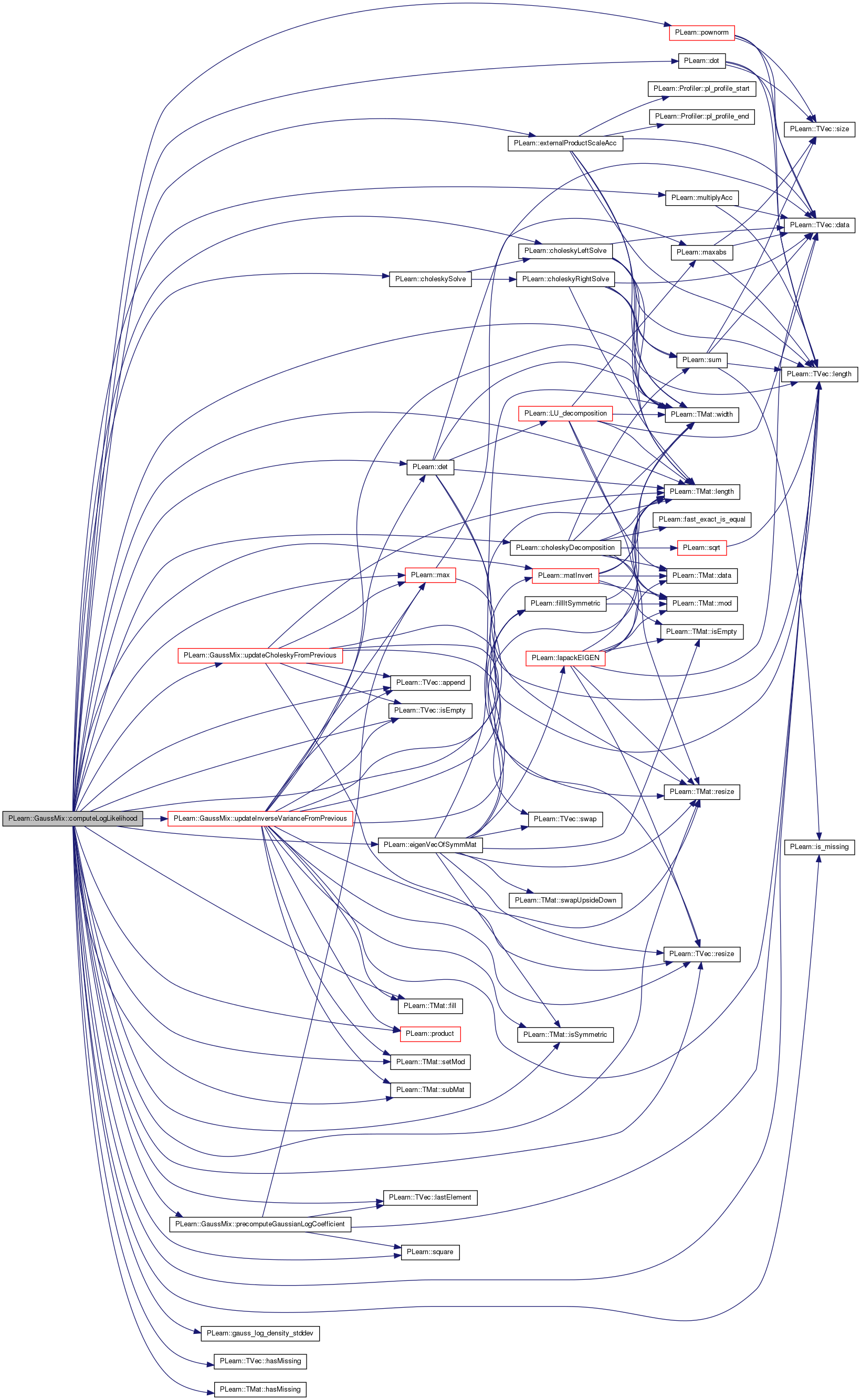

| void PLearn::GaussMix::computeMeansAndCovariances | ( | ) | [protected, virtual] |
Given the posteriors, fill the centers and covariance of each Gaussian.
Definition at line 387 of file GaussMix.cc.
References center, PLearn::columnmatrix(), PLearn::columnSum(), PLearn::computeInputMeanAndCovar(), PLearn::computeInputMeanAndStddev(), PLearn::computeInputMeanAndVariance(), covariance, D, diags, eigenvalues, PLearn::eigenVecOfSymmMat(), eigenvectors, epsilon, error_covariance, PLearn::TVec< T >::hasMissing(), PLearn::TMat< T >::hasMissing(), i, impute_missing, imputed_missing, PLearn::is_missing(), PLearn::TMat< T >::isSymmetric(), j, L, PLearn::TVec< T >::length(), PLearn::mean(), mean_training, n_eigen_computed, nsamples, PLASSERT, PLERROR, PLWARNING, posteriors, PLearn::PLearner::random_gen, sigma, PLearn::sqrt(), PLearn::PLearner::stage, stddev_training, sum_of_posteriors, PLearn::PLearner::train_set, TYPE_DIAGONAL, TYPE_GENERAL, type_id, TYPE_SPHERICAL, and updated_weights.
Referenced by train().
{
//Profiler::start("computeMeansAndCovariances");
VMat weighted_train_set;
Vec sum_columns(L);
Vec storage_D(D);
columnSum(posteriors, sum_columns);
for (int j = 0; j < L; j++) {
// Build the weighted dataset.
if (sum_columns[j] < epsilon)
PLWARNING("In GaussMix::computeMeansAndCovariances - A posterior "
"is almost zero");
PLASSERT( !updated_weights(j).hasMissing() );
VMat weights(columnmatrix(updated_weights(j)));
bool use_impute_missing = impute_missing && stage > 0;
VMat input_data = use_impute_missing ? imputed_missing[j]
: train_set;
/*
input_data->saveAMAT("/u/delallea/tmp/input_data_" +
tostring(this->stage) + ".amat", false, true);
*/
weighted_train_set = new ConcatColumnsVMatrix(
new SubVMatrix(input_data, 0, 0, nsamples, D), weights);
weighted_train_set->defineSizes(D, 0, 1);
Vec center_j = center(j);
if (type_id == TYPE_SPHERICAL) {
computeInputMeanAndVariance(weighted_train_set, center_j,
storage_D);
// TODO Would it be better to use an harmonic mean?
sigma[j] = sqrt(mean(storage_D));
if (isnan(sigma[j]))
PLERROR("In GaussMix::computeMeansAndCovariances - A "
"standard deviation is 'nan'");
} else if (type_id == TYPE_DIAGONAL ) {
computeInputMeanAndStddev(weighted_train_set, center_j,
storage_D);
diags(j) << storage_D;
if (storage_D.hasMissing())
PLERROR("In GaussMix::computeMeansAndCovariances - A "
"standard deviation is 'nan'");
} else {
PLASSERT( type_id == TYPE_GENERAL );
//Profiler::start("computeInputMeanAndCovar");
computeInputMeanAndCovar(weighted_train_set, center_j, covariance);
//Profiler::end("computeInputMeanAndCovar");
if (use_impute_missing) {
// Need to add the extra contributions.
if (sum_of_posteriors[j] > 0) {
error_covariance[j] /= sum_of_posteriors[j];
PLASSERT( covariance.isSymmetric() );
PLASSERT( error_covariance[j].isSymmetric() );
covariance += error_covariance[j];
PLASSERT( covariance.isSymmetric() );
}
}
if (center_j.hasMissing()) {
// There are features missing in all points assigned to this
// Gaussian. We sample a new random value for these features.
for (int i = 0; i < D; i++)
if (is_missing(center_j[i])) {
center_j[i] =
random_gen->gaussian_mu_sigma(mean_training [i],
stddev_training[i]);
#ifdef BOUNDCHECK
// Sanity check: the corresponding row and column in
// the covariance matrix should be missing.
for (int k = 0; k < D; k++) {
if (!is_missing(covariance(i,k)) ||
!is_missing(covariance(k,i)))
PLERROR(
"In GaussMix::computeMeansAndCovariances -"
" Expected a missing value in covariance");
}
#endif
}
}
if (covariance.hasMissing())
// The covariance matrix may have some missing values when not
// enough samples were seen to get simultaneous observations of
// some pairs of features.
// Those missing values are replaced with zero.
for (int i = 0; i < D; i++)
for (int k = i; k < D; k++)
if (is_missing(covariance(i,k))) {
covariance(i,k) = 0;
PLASSERT( is_missing(covariance(k,i)) ||
covariance(k,i) == 0 );
covariance(k,i) = 0;
}
#ifdef BOUNDCHECK
// At this point there should be no more missing values.
if (covariance.hasMissing() || center.hasMissing())
PLERROR("In GaussMix::computeMeansAndCovariances - Found "
"missing values when computing weighted mean and "
"covariance");
#endif
// 'eigenvals' points to the eigenvalues of the j-th Gaussian.
Vec eigenvals = eigenvalues(j);
eigenVecOfSymmMat(covariance, n_eigen_computed, eigenvals,
eigenvectors[j]);
PLASSERT( eigenvals.length() == n_eigen_computed );
// Currently, the returned covariance matrix returned is not
// guaranteed to be semi-definite positive. Thus we need to ensure
// it is the case, by thresholding the negative eigenvalues to the
// smallest positive one.
for (int i = n_eigen_computed - 1; i >= 0; i--)
if (eigenvals[i] > 0) {
for (int k = i + 1; k < n_eigen_computed; k++)
eigenvals[k] = eigenvals[i];
break;
}
}
}
//Profiler::end("computeMeansAndCovariances");
}
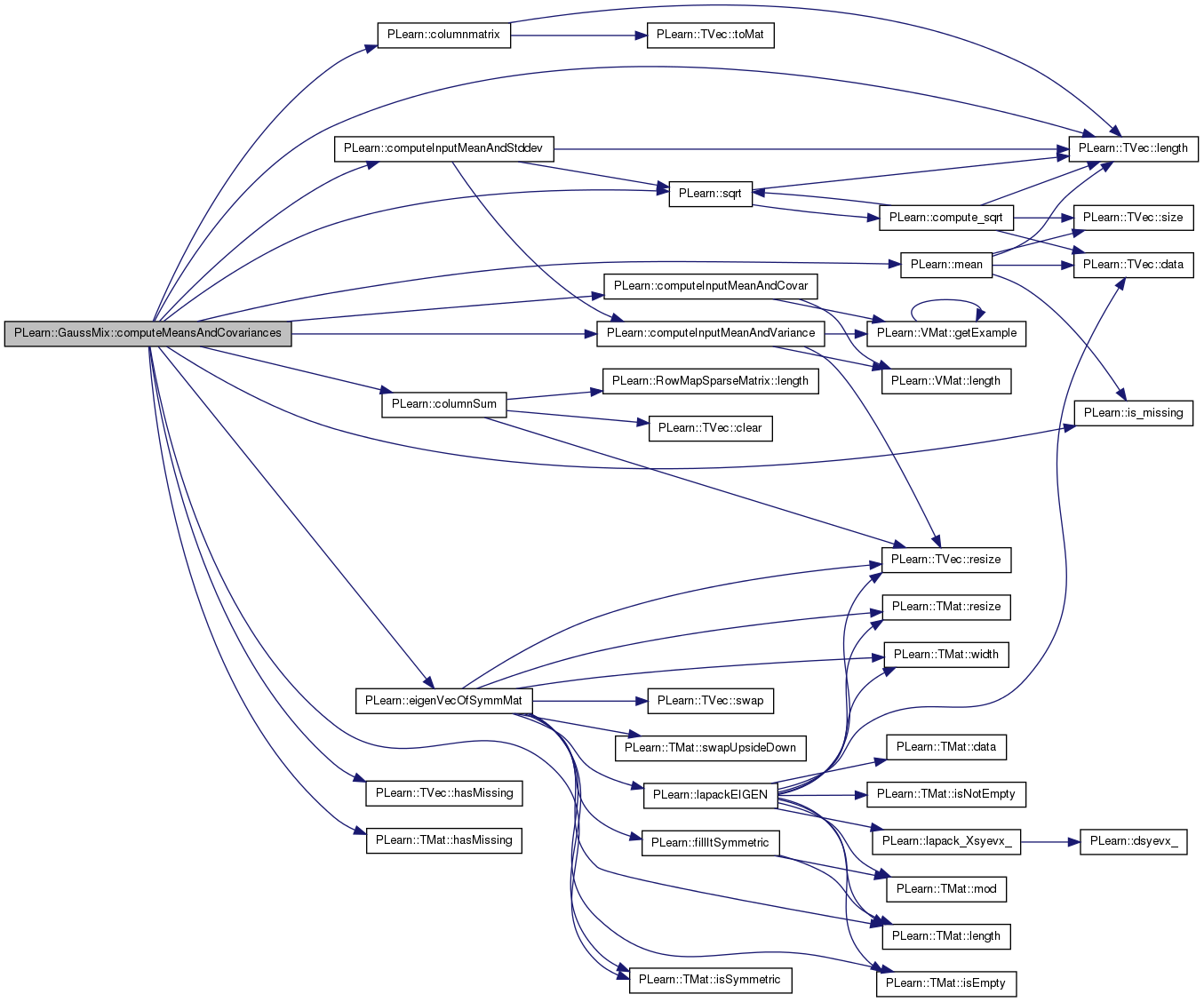

Compute the weight of each Gaussian (the coefficient 'alpha').
If a Gaussian's coefficient is too low (i.e. less than 'alpha_min') and 'allow_replace' is set to true, this Gaussian will be removed and replaced by a new one, while this method will return 'true' (otherwise it will return 'false').
Definition at line 2045 of file GaussMix.cc.
References alpha, alpha_min, PLearn::TVec< T >::fill(), i, j, L, nsamples, posteriors, replaceGaussian(), PLearn::PLearner::stage, and stage_replaced.
Referenced by train().
{
bool replaced_gaussian = false;
if (L==1)
alpha[0] = 1;
else {
alpha.fill(0);
for (int i = 0; i < nsamples; i++)
for (int j = 0; j < L; j++)
alpha[j] += posteriors(i,j);
alpha /= real(nsamples);
for (int j = 0; j < L && !replaced_gaussian; j++)
if (alpha[j] < alpha_min && allow_replace
&& stage_replaced[j] != this->stage) {
// alpha[j] is too small! We need to remove this Gaussian from
// the mixture, and find a new (better) one.
replaceGaussian(j);
replaced_gaussian = true;
stage_replaced[j] = this->stage;
}
}
return replaced_gaussian;
}


| void PLearn::GaussMix::computePosteriors | ( | ) | [protected, virtual] |
Compute posteriors P(j | s_i) for each sample point and each Gaussian.
Note that actual weights (stored in 'updated_weights') will not be until you explicitely call 'updateSampleWeights'.
Definition at line 1918 of file GaussMix.cc.
References addToCovariance(), alpha, clust_imputed_missing, computeAllLogLikelihoods(), computeLogLikelihood(), current_cluster, current_training_sample, D, efficient_missing, error_covariance, PLearn::exp(), PLearn::TVec< T >::fill(), PLearn::VMat::getSubRow(), H3_inverse, PLearn::TVec< T >::hasMissing(), i, impute_missing, imputed_missing, PLearn::is_missing(), j, L, PLearn::TMat< T >::length(), PLearn::TVec< T >::length(), log_likelihood_post, log_likelihood_post_clust, PLearn::logadd(), missing_template, nsamples, pl_log, PLASSERT, posteriors, previous_training_sample, PLearn::TMat< T >::resize(), PLearn::TVec< T >::resize(), sample_row, spanning_path, sum_of_posteriors, and PLearn::PLearner::train_set.
Referenced by train().
{
//Profiler::start("computePosteriors");
sample_row.resize(D);
if (impute_missing) {
sum_of_posteriors.resize(L); // TODO Do that in resize method.
sum_of_posteriors.fill(0);
}
log_likelihood_post.resize(L);
if (impute_missing)
// Clear the additional 'error_covariance' matrix.
for (int j = 0; j < L; j++)
error_covariance[j].fill(0);
if (efficient_missing == 1 || efficient_missing == 3) {
// Loop over all clusters.
for (int k = 0; k < missing_template.length(); k++) {
const TVec<int>& samples_clust = spanning_path[k];
int n_samp = samples_clust.length();
log_likelihood_post_clust.resize(n_samp, L);
current_cluster = k;
if (impute_missing)
for (int j = 0; j < L; j++)
clust_imputed_missing[j].resize(n_samp, D);
for (int j = 0; j < L; j++) {
// For each Gaussian, go through all samples in the cluster.
previous_training_sample = -1;
for (int i = 0; i < samples_clust.length(); i++) {
int s = samples_clust[i];
current_training_sample = s;
train_set->getSubRow(s, 0, sample_row);
log_likelihood_post_clust(i, j) =
computeLogLikelihood(sample_row, j) + pl_log(alpha[j]);
previous_training_sample = current_training_sample;
current_training_sample = -1;
}
}
previous_training_sample = -2;
// Get the posteriors for all samples in the cluster.
for (int i = 0; i < samples_clust.length(); i++) {
real log_sum_likelihood = logadd(log_likelihood_post_clust(i));
int s = samples_clust[i];
for (int j = 0; j < L; j++) {
real post = exp(log_likelihood_post_clust(i, j) -
log_sum_likelihood);
posteriors(s, j) = post;
if (impute_missing)
sum_of_posteriors[j] += post;
}
}
if (!impute_missing)
continue;
// We should now be ready to impute missing values.
for (int i = 0; i < samples_clust.length(); i++) {
int s = samples_clust[i];
for (int j = 0; j < L; j++) {
PLASSERT( !clust_imputed_missing[j](i).hasMissing() );
// TODO We are most likely wasting memory here.
imputed_missing[j]->putRow(s, clust_imputed_missing[j](i));
}
}
// If the 'impute_missing' method is used, we now need to compute
// the extra contribution to the covariance matrix.
for (int j = 0; j < L; j++) {
// For each Gaussian, go through all samples in the cluster.
previous_training_sample = -1;
for (int i = 0; i < samples_clust.length(); i++) {
int s = samples_clust[i];
current_training_sample = s;
train_set->getSubRow(s, 0, sample_row);
addToCovariance(sample_row, j, error_covariance[j],
posteriors(s, j));
previous_training_sample = current_training_sample;
current_training_sample = -1;
}
}
previous_training_sample = -2;
}
} else {
previous_training_sample = -1;
for (int i = 0; i < nsamples; i++) {
train_set->getSubRow(i, 0, sample_row);
// First we need to compute the likelihood P(s_i | j).
current_training_sample = i;
computeAllLogLikelihoods(sample_row, log_likelihood_post);
PLASSERT( !log_likelihood_post.hasMissing() );
for (int j = 0; j < L; j++)
log_likelihood_post[j] += pl_log(alpha[j]);
real log_sum_likelihood = logadd(log_likelihood_post);
for (int j = 0; j < L; j++) {
// Compute the posterior
// P(j | s_i) = P(s_i | j) * alpha_i / (sum_i ")
real post = exp(log_likelihood_post[j] - log_sum_likelihood);
posteriors(i,j) = post;
if (impute_missing)
sum_of_posteriors[j] += post;
}
// Add contribution to the covariance matrix if needed.
if (impute_missing) {
for (int j = 0; j < L; j++) {
real post = posteriors(i,j);
int k_count = 0;
for (int k = 0; k < sample_row.length(); k++)
if (is_missing(sample_row[k])) {
int l_count = 0;
for (int l = 0; l < sample_row.length(); l++)
if (is_missing(sample_row[l])) {
error_covariance[j](k, l) +=
post * H3_inverse[j](k_count, l_count);
l_count++;
}
k_count++;
}
}
int dummy_test = 0;
dummy_test++;
}
previous_training_sample = current_training_sample;
current_training_sample = -1;
}
previous_training_sample = -2;
}
//Profiler::end("computePosteriors");
}
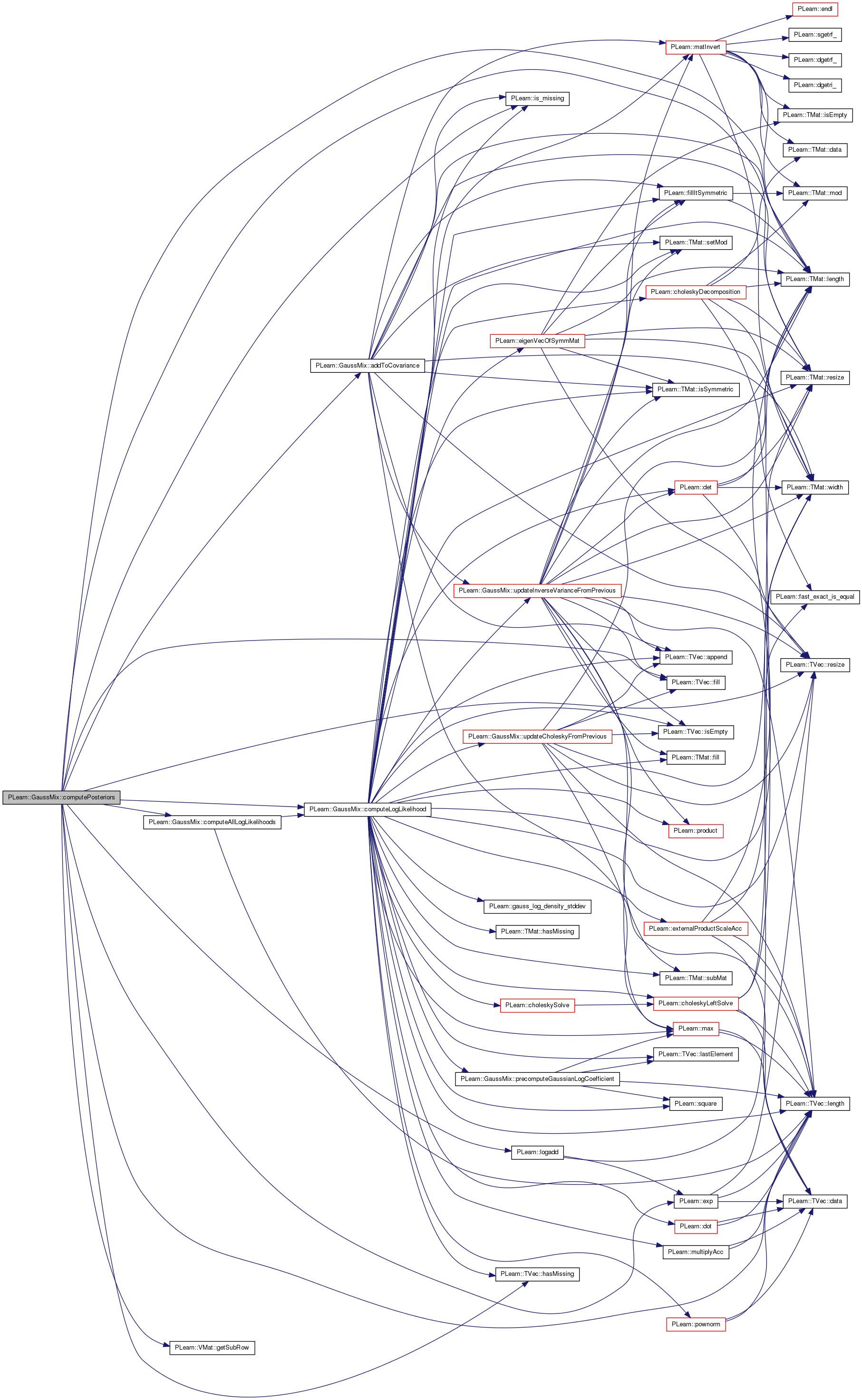

| void PLearn::GaussMix::declareOptions | ( | OptionList & | ol | ) | [static, protected] |
Declares this class' options.
Reimplemented from PLearn::PDistribution.
Reimplemented in PLearn::ManifoldParzen2, PLearn::ParzenWindow, and PLearn::RandomGaussMix.
Definition at line 138 of file GaussMix.cc.
References alpha, alpha_min, PLearn::OptionBase::buildoption, center, D, PLearn::declareOption(), PLearn::PDistribution::declareOptions(), diags, efficient_k_median, efficient_k_median_iter, efficient_missing, eigenvalues, eigenvectors, epsilon, f_eigen, impute_missing, kmeans_iterations, L, PLearn::OptionBase::learntoption, max_samples_in_cluster, min_samples_in_cluster, n_eigen, n_eigen_computed, sigma, sigma_min, and type.
Referenced by PLearn::ParzenWindow::declareOptions(), and PLearn::ManifoldParzen2::declareOptions().
{
// Build options.
declareOption(ol, "L", &GaussMix::L, OptionBase::buildoption,
"Number of Gaussians in the mixture.");
declareOption(ol, "type", &GaussMix::type, OptionBase::buildoption,
"This is the type of covariance matrix for each Gaussian:\n"
" - spherical : spherical covariance matrix sigma^2 * I\n"
" - diagonal : diagonal covariance matrix, given by standard\n"
" deviations 'diags'\n"
" - general : unconstrained covariance matrix (defined by its\n"
" eigenvectors)\n");
declareOption(ol, "n_eigen", &GaussMix::n_eigen, OptionBase::buildoption,
"If type is 'general', the number of eigenvectors used to compute\n"
"the covariance matrix. The remaining eigenvectors will be given an\n"
"eigenvalue equal to the next highest eigenvalue. If set to -1, all\n"
"eigenvectors will be kept.");
declareOption(ol, "f_eigen", &GaussMix::f_eigen, OptionBase::buildoption,
"If == 0, is ignored. Otherwise, it must be a fraction representing\n"
"the fraction of eigenvectors that are kept (this value overrides\n"
"any setting of the 'n_eigen' option).");
declareOption(ol, "efficient_missing", &GaussMix::efficient_missing,
OptionBase::buildoption,
"If not 0, computations with missing values will be more efficient:\n"
"- 1: most efficient method\n"
"- 2: less naive method than 0, where we compute the matrices\n"
" only once per missing pattern (not as good as 1)\n"
"- 3: same as 1, but using inverse variance lemma instead of\n"
" Cholesky (could be more efficient after all)");
declareOption(ol, "efficient_k_median", &GaussMix::efficient_k_median,
OptionBase::buildoption,
"Starting number of clusters used.");
declareOption(ol, "max_samples_in_cluster",
&GaussMix::max_samples_in_cluster,
OptionBase::buildoption,
"Maximum number of samples allowed in each cluster (ignored if -1).\n"
"More than 'efficient_k_median' clusters may be used in order to\n"
"comply with this constraint.");
declareOption(ol, "min_samples_in_cluster",
&GaussMix::min_samples_in_cluster,
OptionBase::buildoption,
"Minimum number of samples allowed in each cluster.\n"
"Less than 'efficient_k_median' clusters may be used in order to\n"
"comply with this constraint.");
declareOption(ol, "efficient_k_median_iter",
&GaussMix::efficient_k_median_iter,
OptionBase::buildoption,
"Maximum number of iterations in k-median.");
declareOption(ol, "impute_missing", &GaussMix::impute_missing,
OptionBase::buildoption,
"If true, missing values will be imputed their conditional mean when\n"
"computing the covariance matrix. Note that even if the current\n"
"default value of this option is false, the 'true' EM algorithm\n"
"requires it to be set to true.");
declareOption(ol, "kmeans_iterations", &GaussMix::kmeans_iterations,
OptionBase::buildoption,
"Maximum number of iterations performed in initial K-means.");
declareOption(ol, "alpha_min", &GaussMix::alpha_min,
OptionBase::buildoption,
"The minimum weight for each Gaussian. Whenever a Gaussian falls\n"
"below 'alpha_min', it is replaced by a new Gaussian. Note that a\n"
"Gaussian may be replaced only once per stage (to avoid cycles).");
declareOption(ol,"sigma_min", &GaussMix::sigma_min,
OptionBase::buildoption,
"The minimum standard deviation allowed. In all computations, any\n"
"standard deviation below 'sigma_min' (or variance below its square)\n"
"will be replaced by 'sigma_min' (or its square). This regularizes\n"
"the Gaussians (and should not be too high nor too small).");
declareOption(ol, "epsilon", &GaussMix::epsilon, OptionBase::buildoption,
"A small number to check for near-zero probabilities.");
// Learnt options.
declareOption(ol, "alpha", &GaussMix::alpha, OptionBase::learntoption,
"Coefficients of the Gaussians. They sum to 1 and are positive:\n"
"they can be interpreted as priors P(Gaussian j).");
declareOption(ol, "center", &GaussMix::center, OptionBase::learntoption,
"Mean of each Gaussian, stored in rows.");
declareOption(ol, "sigma", &GaussMix::sigma, OptionBase::learntoption,
"The standard deviation in all directions, for 'spherical' type.\n");
declareOption(ol,"diags", &GaussMix::diags, OptionBase::learntoption,
"Element (j,k) is the standard deviation of Gaussian j on the k-th\n"
"dimension, for 'diagonal' type.");
declareOption(ol, "eigenvalues", &GaussMix::eigenvalues,
OptionBase::learntoption,
"The eigenvalues associated with the principal eigenvectors:\n"
"element (j,k) is the k-th eigenvalue of the j-th Gaussian.");
declareOption(ol, "eigenvectors", &GaussMix::eigenvectors,
OptionBase::learntoption,
"Principal eigenvectors of each Gaussian (for the 'general' type).\n"
"Element j is a matrix whose row k is the k-th eigenvector of the\n"
"j-th Gaussian.");
/*
declareOption(ol, "log_coeff", &GaussMix::log_coeff,
OptionBase::nosave,
"The logarithm of the constant part in the joint Gaussian density:\n"
"log(1/sqrt(2*pi^D * Det(C))).");
declareOption(ol, "log_p_j_x", &GaussMix::log_p_j_x,
OptionBase::nosave,
"The logarithm of p(j|x), where x is the input part.");
declareOption(ol, "p_j_x", &GaussMix::p_j_x, OptionBase::nosave,
"The probability p(j|x), where x is the input part (it is computed\n"
"by exp(log_p_j_x).");
*/
declareOption(ol, "n_eigen_computed", &GaussMix::n_eigen_computed,
OptionBase::learntoption,
"Actual number of principal components computed with 'general' type.\n"
"It is either equal to the dimension (when all components are\n"
"computed), or to n_eig+1.");
declareOption(ol, "D", &GaussMix::D, OptionBase::learntoption,
"Number of dimensions of the joint distribution.");
/*
// We should not have to save this (it is computed in setPredictor).
declareOption(ol, "center_y_x", &GaussMix::center_y_x, OptionBase::nosave,
"The expectation E[Y | x] for each Gaussian.");
*/
/*
declareOption(ol, "log_p_x_j_alphaj", &GaussMix::log_p_x_j_alphaj,
OptionBase::learntoption,
"The logarithm of p(x|j) * alpha_j, where x is the input part.");
declareOption(ol, "n_tries", &GaussMix::n_tries, OptionBase::learntoption,
"Element i is the number of iterations needed to complete\n"
"stage i (if > 1, some Gaussian has been replaced).");
declareOption(ol, "nsamples", &GaussMix::nsamples,
OptionBase::learntoption,
"Number of samples in the training set.");
declareOption(ol, "training_time", &GaussMix::training_time,
OptionBase::learntoption,
"Time spent in training the model. If initially set to a negative\n"
"value, it will not be updated during training.");
declareOption(ol, "conditional_updating_time",
&GaussMix::conditional_updating_time,
OptionBase::learntoption,
"Time spent in updating from conditional sorting. If initially set\n"
"to a negative value, it will not be updated during training.");
*/
// Now call the parent class' declareOptions
inherited::declareOptions(ol);
}


| static const PPath& PLearn::GaussMix::declaringFile | ( | ) | [inline, static] |
Reimplemented from PLearn::PDistribution.
Reimplemented in PLearn::ManifoldParzen2, PLearn::ParzenWindow, and PLearn::RandomGaussMix.
Definition at line 457 of file GaussMix.h.
:
Reimplemented from PLearn::PDistribution.
Reimplemented in PLearn::ManifoldParzen2, PLearn::ParzenWindow, and PLearn::RandomGaussMix.
Definition at line 133 of file GaussMix.cc.
| void PLearn::GaussMix::expectation | ( | Vec & | mu | ) | const [virtual] |
Compute E[Y | x].
Reimplemented from PLearn::PDistribution.
Definition at line 2071 of file GaussMix.cc.
References alpha, center, center_y_x, PLearn::TVec< T >::data(), PLearn::TVec< T >::fill(), j, L, PLearn::PDistribution::n_predicted, PLearn::PDistribution::n_predictor, p_j_x, PLASSERT, PLearn::TVec< T >::resize(), TYPE_DIAGONAL, TYPE_GENERAL, type_id, and TYPE_SPHERICAL.
Referenced by missingExpectation().
{
mu.resize(n_predicted);
if (type_id == TYPE_SPHERICAL || type_id == TYPE_DIAGONAL ||
(type_id == TYPE_GENERAL && n_predictor == 0)) {
// The expectation is the same in the 'spherical' and 'diagonal' cases.
mu.fill(0);
real* coeff = n_predictor == 0 ? alpha.data() : p_j_x.data();
for (int j = 0; j < L; j++)
mu += center(j).subVec(n_predictor, n_predicted) * coeff[j];
} else {
PLASSERT( type_id == TYPE_GENERAL );
// The case 'n_predictor == 0' is considered above.
PLASSERT( n_predictor > 0 );
mu.fill(0);
for (int j = 0; j < L; j++)
mu += center_y_x(j) * p_j_x[j];
}
}
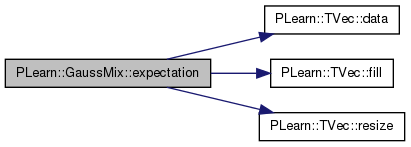

| void PLearn::GaussMix::forget | ( | ) | [virtual] |
Reset the learner.
Reimplemented from PLearn::PDistribution.
Definition at line 2168 of file GaussMix.cc.
References D, PLearn::TVec< T >::fill(), PLearn::PDistribution::forget(), log_p_j_x, n_eigen_computed, p_j_x, ptimer, PLearn::TVec< T >::resize(), and stage_replaced.
Referenced by changeOptions(), and kmeans().
{
inherited::forget();
log_p_j_x.resize(0);
p_j_x.resize(0);
D = -1;
n_eigen_computed = -1;
ptimer->resetAllTimers();
stage_replaced.fill(-1);
/*
if (training_time >= 0)
training_time = 0;
if (conditional_updating_time >= 0)
conditional_updating_time = 0;
n_tries.resize(0);
*/
}


| void PLearn::GaussMix::generate | ( | Vec & | s | ) | const [virtual] |
Generate a sample from this distribution.
Reimplemented from PLearn::PDistribution.
Definition at line 2189 of file GaussMix.cc.
References generateFromGaussian().
{
generateFromGaussian(x, -1);
}
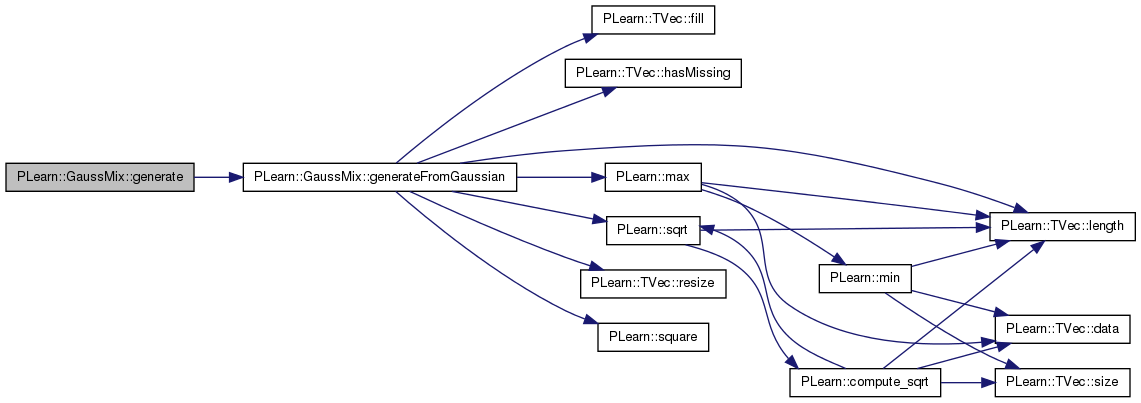
Generate a sample 's' from the given Gaussian.
If 'given_gaussian' is equal to -1, then a random Gaussian will be chosen according to the prior weights alpha.
Definition at line 2197 of file GaussMix.cc.
References alpha, center, center_y_x, diags, eigenvalues, eigenvalues_y_x, eigenvectors, eigenvectors_y_x, PLearn::TVec< T >::fill(), PLearn::TVec< T >::hasMissing(), j, L, PLearn::TVec< T >::length(), PLearn::max(), n_eigen_computed, PLearn::PDistribution::n_predicted, PLearn::PDistribution::n_predictor, p_j_x, PLASSERT, PLearn::PLearner::random_gen, PLearn::TVec< T >::resize(), sigma, sigma_min, PLearn::sqrt(), PLearn::square(), TYPE_DIAGONAL, TYPE_GENERAL, type_id, and TYPE_SPHERICAL.
Referenced by generate(), and replaceGaussian().
{
// TODO Why not having p_j_x point to alpha when n_predictor == 0 ? This may
// make the code cleaner (but check what happens with serialization...).
int j; // The index of the Gaussian to use.
// The assert below may fail if one forgets to provide a predictor part
// through the 'setPredictor' method.
PLASSERT( n_predictor == 0 || p_j_x.length() == L );
if (given_gaussian < 0)
j = random_gen->multinomial_sample(n_predictor == 0 ? alpha : p_j_x);
else
j = given_gaussian % alpha.length();
sample.resize(n_predicted);
if (type_id == TYPE_SPHERICAL || type_id == TYPE_DIAGONAL) {
Vec mu_y = center(j).subVec(n_predictor, n_predicted);
for (int k = 0; k < n_predicted; k++) {
real stddev = type_id == TYPE_SPHERICAL ? sigma[j]
: diags(j, k + n_predictor);
stddev = max(sigma_min, stddev);
sample[k] = random_gen->gaussian_mu_sigma(mu_y[k], stddev);
}
} else {
PLASSERT( type_id == TYPE_GENERAL );
static Vec norm_vec;
if (n_predictor == 0) {
// Simple case.
PLASSERT( eigenvectors[j].width() == n_predicted );
PLASSERT( center(j).length() == n_predicted );
Vec eigenvals = eigenvalues(j);
Mat eigenvecs = eigenvectors[j].subMat(0, 0, n_eigen_computed,
n_predicted);
int n_eig = n_eigen_computed;
Vec mu_y = center(j);
norm_vec.resize(n_eig - 1);
random_gen->fill_random_normal(norm_vec);
real var_min = square(sigma_min);
real lambda0 = max(var_min, eigenvals[n_eig - 1]);
sample.fill(0);
for (int k = 0; k < n_eig - 1; k++)
// TODO See if can use more optimized function.
sample += sqrt(max(var_min, eigenvals[k]) - lambda0)
* norm_vec[k] * eigenvecs(k);
norm_vec.resize(n_predicted);
random_gen->fill_random_normal(norm_vec);
sample += norm_vec * sqrt(lambda0);
sample += mu_y;
} else {
// TODO Get rid of code duplication with above.
Vec eigenvals = eigenvalues_y_x(j);
Mat eigenvecs = eigenvectors_y_x[j];
int n_eig = n_predicted;
Vec mu_y = center_y_x(j);
norm_vec.resize(n_eig - 1);
random_gen->fill_random_normal(norm_vec);
real var_min = square(sigma_min);
real lambda0 = max(var_min, eigenvals[n_eig - 1]);
sample.fill(0);
for (int k = 0; k < n_eig - 1; k++)
// TODO See if can use more optimized function.
sample += sqrt(max(var_min, eigenvals[k]) - lambda0)
* norm_vec[k] * eigenvecs(k);
norm_vec.resize(n_predicted);
random_gen->fill_random_normal(norm_vec);
sample += norm_vec * sqrt(lambda0);
sample += mu_y;
}
}
PLASSERT( !sample.hasMissing() );
}
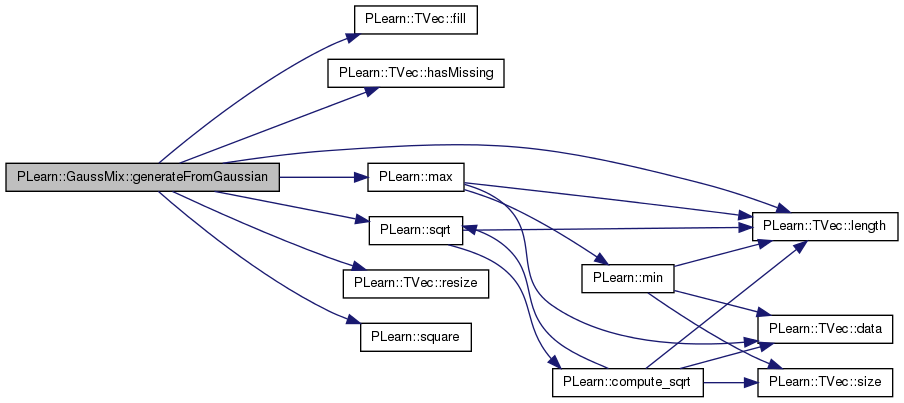

| void PLearn::GaussMix::getInitialWeightsFrom | ( | const VMat & | vmat | ) | [protected] |
Fill the 'initial_weights' vector with the weights from the given VMatrix (which must have a weights column).
Definition at line 3055 of file GaussMix.cc.
References PLearn::VMat::getExample(), i, initial_weights, PLearn::VMat::length(), PLASSERT, PLearn::PLearner::report_progress, and w.
Referenced by train().
{
PLASSERT( vmat->weightsize() == 1 );
Vec tmp1, tmp2;
real w;
PLASSERT( vmat );
PP<ProgressBar> pb;
if (report_progress)
pb = new ProgressBar("Getting sample weights from data set",
vmat->length());
for (int i = 0; i < vmat->length(); i++) {
vmat->getExample(i, tmp1, tmp2, w);
initial_weights[i] = w;
if (report_progress)
pb->update(i + 1);
}
}


| OptionList & PLearn::GaussMix::getOptionList | ( | ) | const [virtual] |
Reimplemented from PLearn::PDistribution.
Reimplemented in PLearn::ManifoldParzen2, PLearn::ParzenWindow, and PLearn::RandomGaussMix.
Definition at line 133 of file GaussMix.cc.
| OptionMap & PLearn::GaussMix::getOptionMap | ( | ) | const [virtual] |
Reimplemented from PLearn::PDistribution.
Reimplemented in PLearn::ManifoldParzen2, PLearn::ParzenWindow, and PLearn::RandomGaussMix.
Definition at line 133 of file GaussMix.cc.
| RemoteMethodMap & PLearn::GaussMix::getRemoteMethodMap | ( | ) | const [virtual] |
Reimplemented from PLearn::PDistribution.
Reimplemented in PLearn::ManifoldParzen2, PLearn::ParzenWindow, and PLearn::RandomGaussMix.
Definition at line 133 of file GaussMix.cc.
| TVec< string > PLearn::GaussMix::getTrainCostNames | ( | ) | const [virtual] |
Overridden to compute the training time.
Reimplemented from PLearn::PDistribution.
Definition at line 3076 of file GaussMix.cc.
References PLearn::TVec< T >::append(), and PLearn::TVec< T >::isEmpty().
{
static TVec<string> costs;
if (costs.isEmpty()) {
costs.append("init_time");
costs.append("training_time");
}
return costs;
}

| void PLearn::GaussMix::kmeans | ( | const VMat & | samples, |
| int | nclust, | ||
| TVec< int > & | clust_idx, | ||
| Mat & | clust, | ||
| int | maxit = 9999 |
||
| ) | [protected] |
Perform K-means.
Definition at line 2301 of file GaussMix.cc.
References PLearn::argmax(), PLearn::computeMeanAndStddev(), PLearn::dist(), PLearn::endl(), forget(), PLearn::VMat::getExample(), PLearn::TVec< T >::hasMissing(), i, PLearn::is_equal(), PLearn::is_missing(), PLearn::TVec< T >::isEmpty(), j, PLearn::TVec< T >::length(), PLearn::VMat::length(), maxit, mean_training, PLearn::min(), original_to_reordered, PLearn::pout, PLearn::powdistance(), PLearn::PLearner::random_gen, PLearn::PLearner::report_progress, PLearn::TMat< T >::resize(), PLearn::TVec< T >::resize(), stddev_training, and PLearn::PLearner::verbosity.
Referenced by train().
{
int vmat_length = samples.length();
clust.resize(nclust,samples->inputsize());
clust_idx.resize(vmat_length);
Vec input(samples->inputsize());
Vec target(samples->targetsize());
real weight;
TVec<int> old_clust_idx(vmat_length);
bool ok=false;
// Compute mean and standard deviation for all fields (will be used to
// generate some random values to replace missing values).
computeMeanAndStddev(samples, mean_training, stddev_training);
if (mean_training.hasMissing())
// Some features are completely missing: we assume mean is 0 and
// standard deviation is 1.
for (int i = 0; i < mean_training.length(); i++)
if (is_missing(mean_training[i])) {
mean_training[i] = 0;
stddev_training[i] = 1;
}
if (stddev_training.hasMissing())
// There may be only one sample with a non-missing value, we assume the
// standard deviation is 1 (probably not always a good idea, but it
// should not really matter in any real-life application).
for (int i = 0; i < stddev_training.length(); i++)
if (is_missing(stddev_training[i]))
stddev_training[i] = 1;
// Build a nclust-long vector of samples indexes to initialize cluster
// centers. In order to avoid some local minima, try to span as much of the
// space as possible by systematically choosing as initial cluster center
// the point 'farthest' from current centers.
TVec<int> start_idx(nclust, -1);
// Store the distance from each point to the 'nclust' cluster centers.
Mat distances(vmat_length, nclust);
Vec min_distances(vmat_length);
int farthest_sample = random_gen->uniform_multinomial_sample(vmat_length);
if (!original_to_reordered.isEmpty())
farthest_sample = original_to_reordered[farthest_sample];
Vec input_k;
for (int i=0; i<nclust; i++)
{
start_idx[i] = farthest_sample;
samples->getExample(farthest_sample,input,target,weight);
clust(i) << input;
// Ensure there are no missing values in the initial centers.
// To do so we generate random values based on 'mean' and 'stddev' if
// the center we picked turns out to have missing values.
Vec cl_center = clust(i);
for (int k = 0; k < cl_center.length(); k++)
if (is_missing(cl_center[k]))
cl_center[k] =
random_gen->gaussian_mu_sigma(mean_training[k],
stddev_training[k]);
if (i < nclust - 1) {
// Find next cluster center.
for (int k = 0; k < vmat_length; k++) {
samples->getExample(k, input_k, target, weight);
real dist = 0;
int count = 0;
for (int j = 0; j < input_k.length(); j++)
if (!is_missing(input_k[j])) {
dist += fabs(input_k[j] - cl_center[j]);
count++;
}
if (count > 0)
dist /= real(count);
distances(k, i) = dist;
min_distances[k] = min(distances(k).subVec(0, i + 1));
}
farthest_sample = argmax(min_distances);
}
}
PP<ProgressBar> pb;
if (report_progress)
pb = new ProgressBar("Performing K-Means to initialize centers", maxit);
int iteration = maxit;
TVec<VecStatsCollector> clust_stat(nclust);
Vec clust_i;
Vec nnonmissing(input.length());
while(!ok && iteration--)
{
for (int i = 0; i < clust_stat.length(); i++)
clust_stat[i].forget();
old_clust_idx << clust_idx;
for(int i=0;i<vmat_length;i++)
{
samples->getExample(i,input,target,weight);
real dist,bestdist = REAL_MAX;
int bestclust=0;
if (nclust>1) for(int j=0;j<nclust;j++)
if((dist = powdistance(input, clust(j), 2.0, true)) < bestdist)
{
bestdist=dist;
bestclust=j;
}
clust_idx[i] = bestclust;
clust_stat[bestclust].update(input, weight);
}
for (int i = 0; i < nclust; i++) {
clust_i = clust(i);
int j;
for (j = 0;
j < input.length()
&& clust_stat[i].stats.length() > 0
&& is_equal(clust_stat[i].getStats(j).nnonmissing(), 0);
j++) {}
if (j < input.length())
// There have been some samples assigned to this cluster.
clust_stat[i].getMean(clust_i);
else {
// Re-initialize randomly the cluster center.
int new_center =
random_gen->uniform_multinomial_sample(vmat_length);
if (!original_to_reordered.isEmpty())
new_center = original_to_reordered[new_center];
samples->getExample(new_center, input, target, weight);
clust_i << input;
}
// Replace missing values by randomly generated values.
for (int k = 0; k < clust_i.length(); k++)
if (is_missing(clust_i[k]))
clust_i[k] =
random_gen->gaussian_mu_sigma(mean_training [k],
stddev_training[k]);
}
ok=true;
if (nclust>1)
for(int i=0;i<vmat_length;i++)
if(old_clust_idx[i]!=clust_idx[i])
{
ok=false;
break;
}
if (report_progress)
pb->update(maxit - iteration + 1);
}
if (report_progress && verbosity >= 2 && iteration > 0)
pout << "K-Means performed in only " << maxit - iteration << " iterations."
<< endl;
}
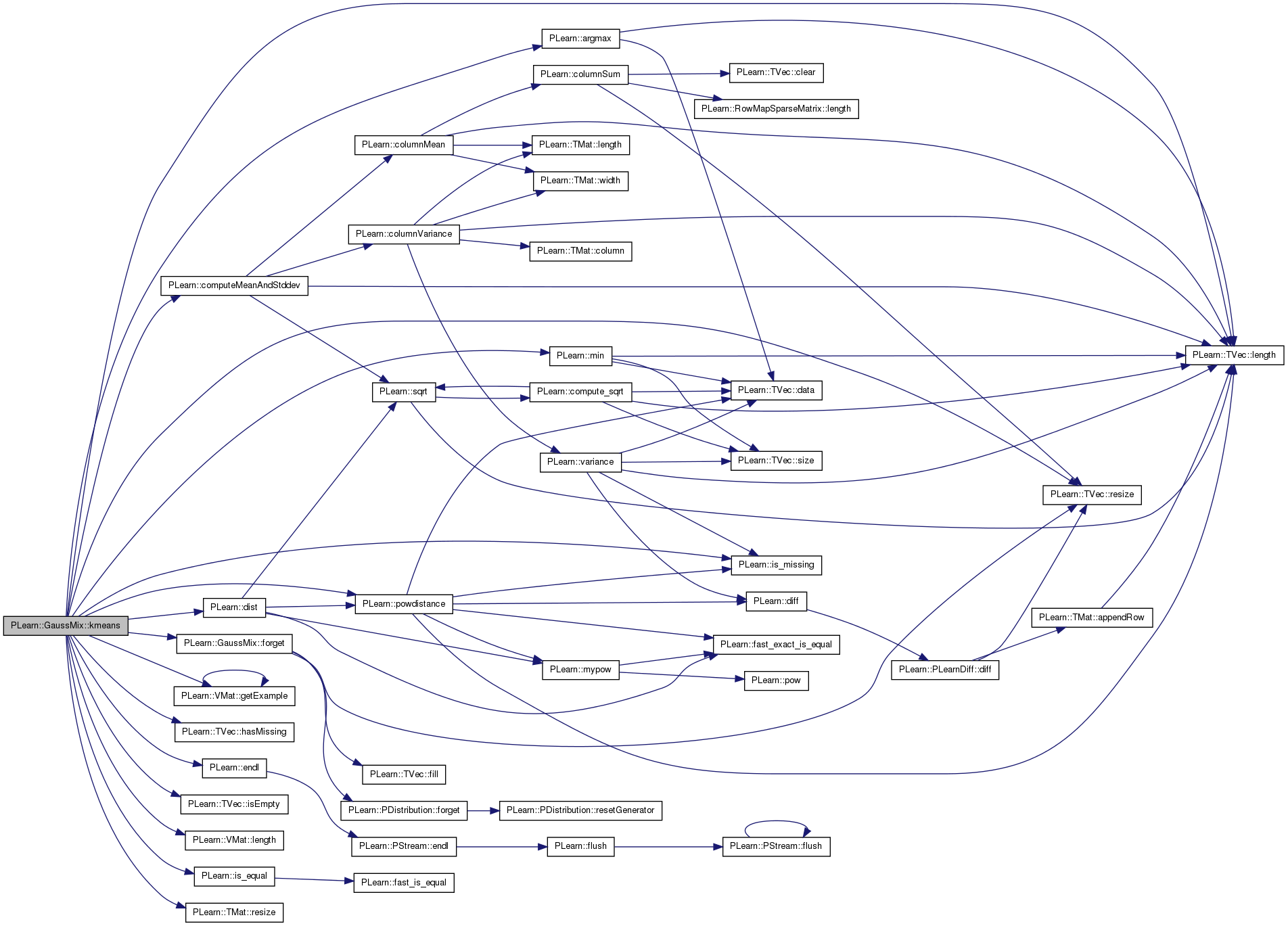

Return density p(y | x).
Reimplemented from PLearn::PDistribution.
Definition at line 2459 of file GaussMix.cc.
References alpha, computeLogLikelihood(), j, L, log_likelihood_dens, log_p_j_x, PLearn::logadd(), PLearn::PDistribution::n_predictor, pl_log, PLASSERT, and PLearn::TVec< T >::resize().
Referenced by unknownOutput().
{
log_likelihood_dens.resize(L);
// First we need to compute the likelihood
// p(y,j | x) = p(y | x,j) * p(j | x).
for (int j = 0; j < L; j++) {
real logp_j_x = n_predictor == 0 ? pl_log(alpha[j])
: log_p_j_x[j];
log_likelihood_dens[j] = computeLogLikelihood(y, j) + logp_j_x;
PLASSERT( !isnan(log_likelihood_dens[j]) );
}
return logadd(log_likelihood_dens);
}
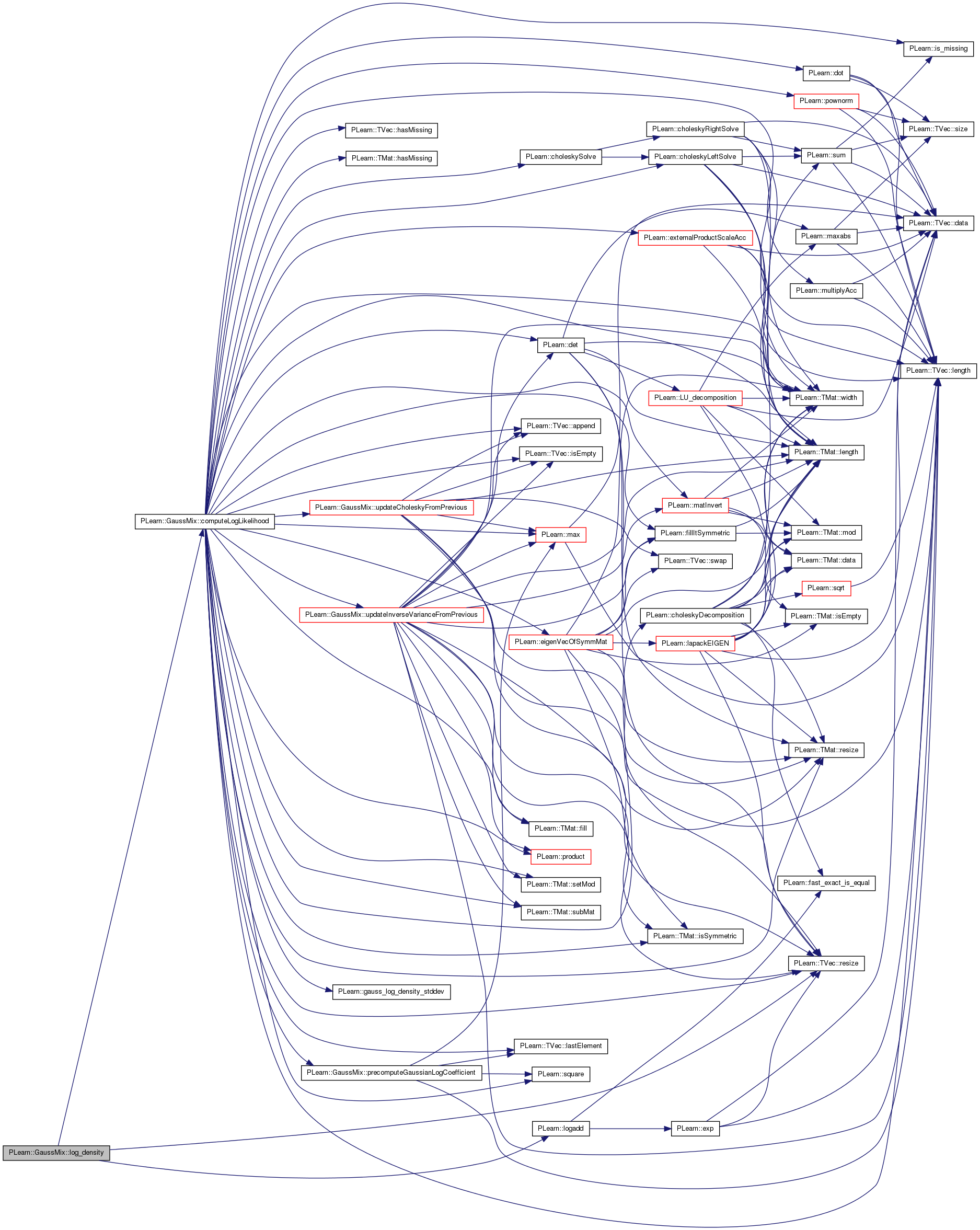

| void PLearn::GaussMix::makeDeepCopyFromShallowCopy | ( | CopiesMap & | copies | ) | [virtual] |
Transform a shallow copy into a deep copy.
Reimplemented from PLearn::PDistribution.
Reimplemented in PLearn::ManifoldParzen2, PLearn::ParzenWindow, and PLearn::RandomGaussMix.
Definition at line 2476 of file GaussMix.cc.
References alpha, center, center_y_x, chol_joint_cov, cholesky_queue, clust_imputed_missing, clusters_samp, cond_var_inv_queue, covariance, PLearn::deepCopyField(), diags, eigenvalues, eigenvalues_x, eigenvalues_y_x, eigenvectors, eigenvectors_x, eigenvectors_y_x, error_covariance, H3_inverse, imputed_missing, indices_inv_queue, indices_queue, initial_weights, joint_cov, joint_inv_cov, log_coeff, log_coeff_x, log_coeff_y_x, log_det_queue, log_likelihood_dens, log_likelihood_post, log_likelihood_post_clust, log_p_j_x, PLearn::PDistribution::makeDeepCopyFromShallowCopy(), mean_training, missing_patterns, missing_template, need_recompute, no_missing_change, original_to_reordered, p_j_x, posteriors, ptimer, sample_row, sample_to_path_index, sample_to_template, sigma, spanning_can_free, spanning_path, spanning_use_previous, stage_joint_cov_computed, stage_replaced, stddev_training, sum_of_posteriors, updated_weights, y_centered, and y_x_mat.
Referenced by PLearn::ParzenWindow::makeDeepCopyFromShallowCopy(), and PLearn::ManifoldParzen2::makeDeepCopyFromShallowCopy().
{
inherited::makeDeepCopyFromShallowCopy(copies);
deepCopyField(log_likelihood_post, copies);
deepCopyField(sample_row, copies);
deepCopyField(H3_inverse, copies);
deepCopyField(ptimer, copies);
deepCopyField(missing_patterns, copies);
deepCopyField(missing_template, copies);
deepCopyField(sample_to_path_index, copies);
deepCopyField(spanning_path, copies);
deepCopyField(spanning_use_previous, copies);
deepCopyField(spanning_can_free, copies);
deepCopyField(log_likelihood_post_clust,copies);
deepCopyField(clusters_samp, copies);
deepCopyField(cholesky_queue, copies);
deepCopyField(log_det_queue, copies);
deepCopyField(imputed_missing, copies);
deepCopyField(clust_imputed_missing, copies);
deepCopyField(sum_of_posteriors, copies);
deepCopyField(no_missing_change, copies);
deepCopyField(cond_var_inv_queue, copies);
deepCopyField(indices_queue, copies);
deepCopyField(indices_inv_queue, copies);
deepCopyField(mean_training, copies);
deepCopyField(stddev_training, copies);
deepCopyField(error_covariance, copies);
deepCopyField(posteriors, copies);
deepCopyField(initial_weights, copies);
deepCopyField(updated_weights, copies);
deepCopyField(eigenvectors_x, copies);
deepCopyField(eigenvalues_x, copies);
deepCopyField(y_x_mat, copies);
deepCopyField(eigenvectors_y_x, copies);
deepCopyField(eigenvalues_y_x, copies);
deepCopyField(center_y_x, copies);
deepCopyField(log_p_j_x, copies);
deepCopyField(p_j_x, copies);
deepCopyField(log_coeff, copies);
deepCopyField(log_coeff_x, copies);
deepCopyField(log_coeff_y_x, copies);
deepCopyField(joint_cov, copies);
deepCopyField(joint_inv_cov, copies);
deepCopyField(chol_joint_cov, copies);
// deepCopyField(chol_cov_template, copies);
deepCopyField(stage_joint_cov_computed, copies);
deepCopyField(stage_replaced, copies);
deepCopyField(sample_to_template, copies);
deepCopyField(y_centered, copies);
deepCopyField(covariance, copies);
deepCopyField(log_likelihood_dens, copies);
deepCopyField(need_recompute, copies);
deepCopyField(original_to_reordered, copies);
deepCopyField(diags, copies);
deepCopyField(eigenvalues, copies);
deepCopyField(eigenvectors, copies);
deepCopyField(alpha, copies);
deepCopyField(center, copies);
deepCopyField(sigma, copies);
// TODO Update!
}


Return E[Y | x] where Y is the missing part in the 'input' vector, and x in the observed part.
Reimplemented from PLearn::PDistribution.
Definition at line 2094 of file GaussMix.cc.
References PLearn::TVec< T >::append(), center, eigenvectors, expectation(), PLearn::TVec< T >::hasMissing(), i, PLearn::is_missing(), PLearn::TMat< T >::length(), PLearn::TVec< T >::length(), PLERROR, PLearn::PDistribution::predicted_size, PLearn::PDistribution::predictor_size, PLearn::TMat< T >::resize(), PLearn::TVec< T >::resize(), PLearn::selectColumns(), setPredictor(), setPredictorPredictedSizes(), PLearn::TVec< T >::subVec(), TYPE_GENERAL, type_id, and PLearn::TMat< T >::width().
{
static TVec<int> coord_missing;
static TVec<int> coord_non_missing;
static TVec<int> coord_reordered;
static Vec input_non_missing;
static Mat center_backup;
static Mat mat_storage;
static TVec<Mat> eigenvectors_backup;
if (!input.hasMissing()) {
mu.resize(0);
return;
}
if (type_id != TYPE_GENERAL)
PLERROR("In GaussMix::missingExpectation - Not implemented for this "
"type");
// Create coordinate indices lists.
coord_missing.resize(0);
coord_non_missing.resize(0);
input_non_missing.resize(0);
for (int i = 0; i < input.length(); i++)
if (is_missing(input[i]))
coord_missing.append(i);
else {
coord_non_missing.append(i);
input_non_missing.append(input[i]);
}
int n_missing = coord_missing.length();
int n_non_missing = coord_non_missing.length();
coord_reordered.resize(input.length());
coord_reordered.subVec(0, n_non_missing) << coord_non_missing;
coord_reordered.subVec(n_non_missing, n_missing) << coord_missing;
// Backup existing data.
center_backup.resize(center.length(), center.width());
center_backup << center;
eigenvectors_backup.resize(eigenvectors.length());
for (int i = 0; i < eigenvectors.length(); i++) {
Mat& eigenvecs_backup = eigenvectors_backup[i];
Mat& eigenvecs = eigenvectors[i];
eigenvecs_backup.resize(eigenvecs.length(), eigenvecs.width());
eigenvecs_backup << eigenvecs;
}
int predictor_size_backup = predictor_size;
int predicted_size_backup = predicted_size;
// Update components to match the new reordered coordinates.
selectColumns(center_backup, coord_reordered, center);
for (int i = 0; i < eigenvectors.length(); i++)
selectColumns(eigenvectors_backup[i], coord_reordered,
eigenvectors[i]);
// Set this distribution as conditional to compute the expectation of the
// missing (predicted) part given the observed (predictor) part.
setPredictorPredictedSizes(n_non_missing, n_missing);
setPredictor(input_non_missing);
// Compute the expectation.
expectation(mu);
// Restore everything.
setPredictorPredictedSizes(predictor_size_backup, predicted_size_backup);
center << center_backup;
for (int i = 0; i < eigenvectors.length(); i++) {
Mat& eigenvecs_backup = eigenvectors_backup[i];
Mat& eigenvecs = eigenvectors[i];
eigenvecs << eigenvecs_backup;
}
}
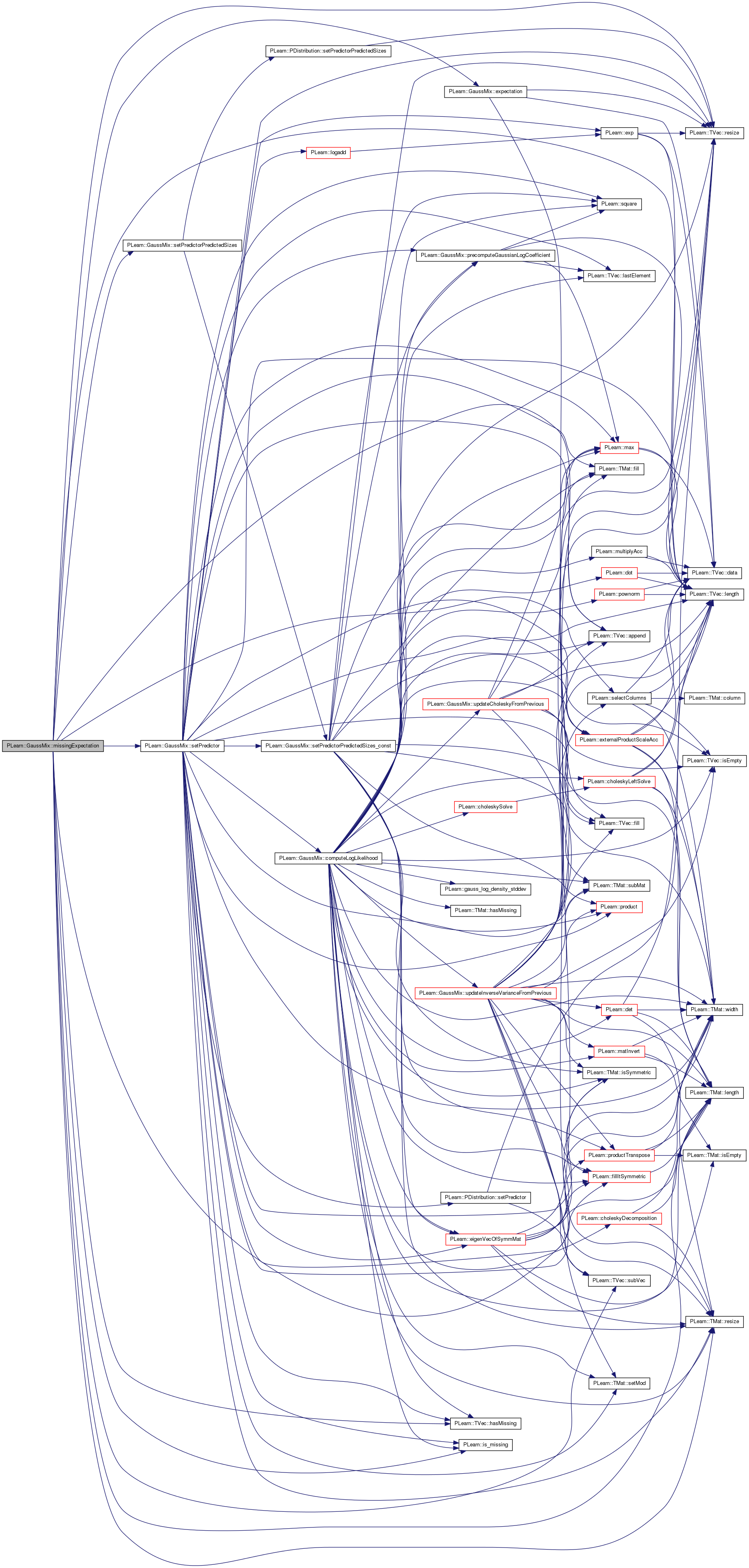
| int PLearn::GaussMix::outputsize | ( | ) | const [virtual] |
Overridden to take into account new outputs computed.
Reimplemented from PLearn::PDistribution.
Reimplemented in PLearn::ManifoldParzen2.
Definition at line 2545 of file GaussMix.cc.
References i, L, PLearn::PDistribution::outputs_def, and PLearn::PDistribution::outputsize().
Referenced by PLearn::ManifoldParzen2::outputsize().
{
int os = inherited::outputsize();
for (size_t i = 0; i < outputs_def.length(); i++)
if (outputs_def[i] == 'p')
// We add L-1 because in inherited::outpusize() this was already
// counted as 1.
os += L - 1;
return os;
}


| void PLearn::GaussMix::precomputeAllGaussianLogCoefficients | ( | ) | [protected] |
When type is 'general', fill the 'log_coeff' vector with the result of precomputeGaussianLogCoefficient(..) applied to each component of the mixture.
Definition at line 2558 of file GaussMix.cc.
References D, eigenvalues, j, L, log_coeff, PLASSERT, precomputeGaussianLogCoefficient(), TYPE_DIAGONAL, TYPE_GENERAL, type_id, and TYPE_SPHERICAL.
Referenced by build_(), and train().
{
if (type_id == TYPE_SPHERICAL || type_id == TYPE_DIAGONAL) {
// Nothing to do.
} else {
PLASSERT( type_id == TYPE_GENERAL );
// Precompute the log_coeff.
for (int j = 0; j < L; j++)
log_coeff[j] = precomputeGaussianLogCoefficient(eigenvalues(j), D);
}
}


| real PLearn::GaussMix::precomputeGaussianLogCoefficient | ( | const Vec & | eigenvals, |
| int | dimension | ||
| ) | const [protected] |
Return log( 1 / sqrt( 2 Pi^dimension |C| ) ), i.e.
the logarithm of the constant coefficient in the Gaussian whose covariance matrix has the given eigenvalues 'eigenvals' in dimension 'dimension'. If the length of 'eigenvals' is not equal to 'dimension', the missing eigenvalues are assumed to be equal to the last in 'eigenvals' (which must be sorted in decreasing order of eigenvalues).
Definition at line 2573 of file GaussMix.cc.
References epsilon, PLearn::TVec< T >::lastElement(), PLearn::TVec< T >::length(), Log2Pi, PLearn::max(), pl_log, PLASSERT, PLERROR, PLWARNING, sigma_min, and PLearn::square().
Referenced by computeLogLikelihood(), precomputeAllGaussianLogCoefficients(), setPredictor(), and setPredictorPredictedSizes_const().
{
#ifdef BOUNDCHECK
real last_eigenval = numeric_limits<double>::infinity();
#endif
int n_eig = eigenvals.length();
PLASSERT( dimension >= n_eig );
real log_det = 0;
real var_min = square(sigma_min);
for (int k = 0; k < n_eig; k++) {
#ifdef BOUNDCHECK
if (var_min < epsilon && eigenvals[k] < epsilon)
PLWARNING("In GaussMix::precomputeGaussianLogCoefficient - An "
"eigenvalue is near zero");
if (eigenvals[k] > last_eigenval)
PLERROR("In GaussMix::precomputeGaussianLogCoefficient - The "
"eigenvalues must be sorted in decreasing order");
last_eigenval = eigenvals[k];
#endif
log_det += pl_log(max(var_min, eigenvals[k]));
}
if (dimension > n_eig)
// Only the first 'n_eig' eigenvalues are given: we assume
// the other eigenvalues are equal to the last given one.
log_det += pl_log(max(var_min, eigenvals.lastElement()))
* (dimension - n_eig);
return -0.5 * (dimension * Log2Pi + log_det);
}


| void PLearn::GaussMix::replaceGaussian | ( | int | j | ) | [protected] |
Replace the j-th Gaussian with another one (probably because that one is not appropriate).
The new one is centered on a random point sampled from the Gaussian with highest weight alpha, and has the same covariance. The weight of the Gaussian with highest weight is divided by two, and the weight of the new Gaussian is equal to the result of this division (so that weights still sum to one).
Definition at line 2606 of file GaussMix.cc.
References alpha, PLearn::argmax(), center, diags, eigenvalues, eigenvectors, generateFromGaussian(), j, log_coeff, PLearn::PDistribution::n_predictor, PLASSERT, sigma, stage_joint_cov_computed, TYPE_DIAGONAL, TYPE_GENERAL, type_id, and TYPE_SPHERICAL.
Referenced by computeMixtureWeights().
{
// This is supposed to be called only during training, when there is no
// predictor part (we use the full joint distribution).
PLASSERT( n_predictor == 0 );
// Find the Gaussian with highest weight.
int high = argmax(alpha);
PLASSERT( high != j );
// Generate the new center from this Gaussian.
Vec new_center = center(j);
generateFromGaussian(new_center, high);
// Copy the covariance.
if (type_id == TYPE_SPHERICAL) {
sigma[j] = sigma[high];
} else if (type_id == TYPE_DIAGONAL) {
diags(j) << diags(high);
} else {
PLASSERT( type_id == TYPE_GENERAL );
eigenvalues(j) << eigenvalues(high);
eigenvectors[j] << eigenvectors[high];
log_coeff[j] = log_coeff[high];
stage_joint_cov_computed[j] = -1;
}
// Arbitrarily takes half of the weight of this Gaussian.
alpha[high] /= 2.0;
alpha[j] = alpha[high];
}


| void PLearn::GaussMix::resizeDataBeforeTraining | ( | ) | [protected] |
Make sure everything has the right size when training starts.
Definition at line 2692 of file GaussMix.cc.
References alpha, center, clust_imputed_missing, covariance, D, diags, efficient_missing, eigenvalues, eigenvectors, error_covariance, f_eigen, PLearn::TVec< T >::fill(), H3_inverse, i, impute_missing, imputed_missing, initial_weights, PLearn::is_equal(), j, L, PLearn::TVec< T >::length(), PLearn::VMat::length(), mean_training, n_eigen, n_eigen_computed, no_missing_change, nsamples, PLASSERT, PLERROR, PLearn::TMat< T >::resize(), PLearn::TVec< T >::resize(), sigma, stage_replaced, stddev_training, PLearn::PLearner::train_set, TYPE_DIAGONAL, TYPE_GENERAL, type_id, and TYPE_SPHERICAL.
Referenced by PLearn::ParzenWindow::train(), PLearn::ManifoldParzen2::train(), and train().
{
PLASSERT( train_set );
n_eigen_computed = -1;
nsamples = train_set->length();
D = train_set->inputsize();
if (f_eigen > 0){
if (is_equal(f_eigen, 1))
n_eigen = -1;
else {
n_eigen = int(round(f_eigen * D));
if (n_eigen == 0)
// We always want to keep at least one eigenvector.
n_eigen = 1;
}
}
alpha.resize(L);
clust_imputed_missing.resize(0);
eigenvectors.resize(0);
H3_inverse.resize(0);
imputed_missing.resize(0);
mean_training.resize(0);
no_missing_change.resize(0);
sigma.resize(0);
stddev_training.resize(0);
center.resize(L, D);
covariance.resize(0, 0);
diags.resize(0, 0);
eigenvalues.resize(0, 0);
error_covariance.resize(0);
initial_weights.resize(nsamples);
//posteriors.resize(nsamples, L);
//updated_weights.resize(L, nsamples);
stage_replaced.resize(L);
stage_replaced.fill(-1);
// Type-specific data.
switch(type_id)
{
case TYPE_SPHERICAL:
sigma.resize(L);
break;
case TYPE_DIAGONAL:
diags.resize(L, D);
break;
case TYPE_GENERAL:
eigenvectors.resize(L);
if (n_eigen == -1 || n_eigen == D)
// We need to compute all eigenvectors.
n_eigen_computed = D;
else
{
if (n_eigen > D || n_eigen < 1)
PLERROR("In GaussMix::resizeDataBeforeTraining - Invalid value"
" for 'n_eigen' (%d), should be between 1 and %d",
n_eigen, D);
n_eigen_computed = n_eigen + 1;
}
eigenvalues.resize(L, n_eigen_computed);
for (int i = 0; i < eigenvectors.length(); i++)
eigenvectors[i].resize(n_eigen_computed, D);
if (impute_missing)
{
H3_inverse.resize(L);
error_covariance.resize(L);
imputed_missing.resize(L);
for (int j = 0; j < L; j++)
{
error_covariance[j].resize(D, D);
imputed_missing[j] = new MemoryVMatrix(nsamples, D);
}
/*
PPath fname = "/u/delallea/tmp/imputed_missing.pmat";
imputed_missing = new FileVMatrix(fname, nsamples, D);
*/
// TODO May be useful to handle other types of VMats for large
// datasets.
// TODO Move outside of this method.
if (efficient_missing == 1 || efficient_missing == 3)
clust_imputed_missing.resize(L);
}
if (efficient_missing == 1 || efficient_missing == 3)
no_missing_change.resize(nsamples);
break;
default:
PLERROR("Invalid type_id");
}
}
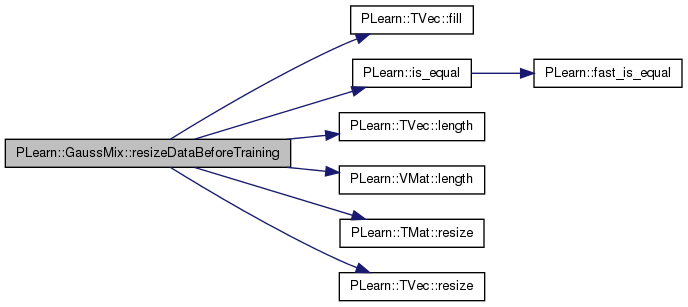

| void PLearn::GaussMix::resizeDataBeforeUsing | ( | ) | [protected] |
Make sure everything has the right size when the object is about to be used (e.g.
after loading a saved GaussMix object).
Definition at line 2636 of file GaussMix.cc.
References center_y_x, chol_joint_cov, eigenvalues_x, eigenvalues_y_x, eigenvectors_x, eigenvectors_y_x, PLearn::TVec< T >::fill(), joint_cov, joint_inv_cov, L, log_coeff, log_coeff_x, log_coeff_y_x, PLearn::PDistribution::n_predicted, PLearn::PDistribution::n_predictor, PLERROR, PLearn::TMat< T >::resize(), PLearn::TVec< T >::resize(), stage_joint_cov_computed, TYPE_DIAGONAL, TYPE_GENERAL, type_id, TYPE_SPHERICAL, and y_x_mat.
Referenced by build_(), and train().
{
eigenvectors_x.resize(0);
eigenvectors_y_x.resize(0);
joint_cov.resize(0);
joint_inv_cov.resize(0);
chol_joint_cov.resize(0);
log_coeff.resize(0);
log_coeff_x.resize(0);
log_coeff_y_x.resize(0);
stage_joint_cov_computed.resize(0);
y_x_mat.resize(0);
// chol_cov_template.resize(0, 0);
center_y_x.resize(0, 0);
eigenvalues_x.resize(0, 0);
eigenvalues_y_x.resize(0, 0);
// Type-specific data.
switch(type_id)
{
case TYPE_SPHERICAL:
case TYPE_DIAGONAL:
break;
case TYPE_GENERAL:
eigenvectors_x.resize(L);
eigenvectors_y_x.resize(L);
joint_cov.resize(L);
joint_inv_cov.resize(L);
chol_joint_cov.resize(L);
log_coeff_x.resize(L);
log_coeff_y_x.resize(L);
stage_joint_cov_computed.resize(L);
stage_joint_cov_computed.fill(-1);
y_x_mat.resize(L);
// if (efficient_missing)
// chol_cov_template.resize(efficient_k_median, L);
if (n_predictor >= 0)
eigenvalues_x.resize(L, n_predictor);
if (n_predicted >= 0)
{
center_y_x.resize(L, n_predicted);
eigenvalues_y_x.resize(L, n_predicted);
}
log_coeff.resize(L);
break;
default:
PLERROR("Invalid type_id");
}
}


| void PLearn::GaussMix::setPredictor | ( | const Vec & | predictor, |
| bool | call_parent = true |
||
| ) | const [virtual] |
Set the value for the predictor part of the conditional probability.
Reimplemented from PLearn::PDistribution.
Definition at line 2790 of file GaussMix.cc.
References alpha, PLearn::TVec< T >::append(), center, center_y_x, computeLogLikelihood(), D, eigenvalues, eigenvalues_y_x, PLearn::eigenVecOfSymmMat(), eigenvectors, eigenvectors_y_x, PLearn::exp(), PLearn::externalProductScaleAcc(), PLearn::TMat< T >::fill(), PLearn::TVec< T >::fill(), PLearn::fillItSymmetric(), PLearn::TVec< T >::hasMissing(), i, PLearn::is_missing(), PLearn::TVec< T >::isEmpty(), PLearn::TMat< T >::isSymmetric(), j, L, PLearn::TVec< T >::lastElement(), PLearn::TVec< T >::length(), log_coeff_y_x, log_p_j_x, PLearn::logadd(), PLearn::max(), n_eigen_computed, PLearn::PDistribution::n_predicted, PLearn::PDistribution::n_predictor, p_j_x, pl_log, PLASSERT, precomputeGaussianLogCoefficient(), PLearn::PDistribution::predictor_part, previous_predictor_part_had_missing, PLearn::product(), PLearn::productTranspose(), PLearn::TMat< T >::resize(), PLearn::TVec< T >::resize(), PLearn::TMat< T >::setMod(), PLearn::PDistribution::setPredictor(), setPredictorPredictedSizes_const(), sigma_min, PLearn::square(), PLearn::PLearner::stage, PLearn::TMat< T >::subMat(), TYPE_GENERAL, type_id, PLearn::TMat< T >::width(), and y_x_mat.
Referenced by build_(), and missingExpectation().
{
static Vec log_p_x_j_alphaj;
static Vec x_minus_mu_x; // Used to store 'x - mu_x'.
static TVec<int> missing, non_missing;
static Mat work_mat1, work_mat2;
static Mat full_cov;
static Mat cov_x_j;
static Mat inv_cov_x;
static Mat cov_y_x;
static Mat cross_cov;
static TVec<Mat> eigenvectors_x_miss;
static Mat eigenvalues_x_miss;
static TVec<Mat> y_x_mat_miss;
if (call_parent)
inherited::setPredictor(predictor);
if (n_predictor == 0) {
// There is no predictor part anyway: nothing to do.
PLASSERT( predictor_part.isEmpty() );
return;
}
if (stage == 0)
// The Gaussian mixture is not ready yet (it has not yet been
// trained): there is nothing more we can do.
// Note that this is also why one needs to set a stage > 0 if the
// Gaussian mixture parameters are set by hand (and not learnt).
return;
// We need to compute:
// p(j | x) = p(x | j) p(j) / p(x)
// = p(x | j) p(j) / sum_k p(x | k) p(k)
if (type_id == TYPE_GENERAL) {
// We need to compute E[Y|x,j].
if (!predictor_part.hasMissing()) {
// Simple case: the predictor part has no missing value, and we can
// re-use the quantities computed in setPredictorPredictedSizes(..).
// If the previous predictor part set had missing values, we will
// need to recompute some important variables (e.g. eigenvectors /
// values of y|x). This can be done by re-setting the sizes.
// TODO This is a bit hackish... we may want to actually store the
// appropriate data elsewhere so that there is no need to recompute
// it again.
if (previous_predictor_part_had_missing)
setPredictorPredictedSizes_const();
previous_predictor_part_had_missing = false;
x_minus_mu_x.resize(n_predictor);
Vec mu_target;
for (int j = 0; j < L; j++) {
x_minus_mu_x << predictor_part;
x_minus_mu_x -= center(j).subVec(0, n_predictor);
mu_target = center_y_x(j);
if (n_predictor > 0)
product(mu_target, y_x_mat[j], x_minus_mu_x);
else
mu_target.fill(0);
mu_target += center(j).subVec(n_predictor, n_predicted);
}
} else {
previous_predictor_part_had_missing = true;
// TODO Code duplication is ugly!
non_missing.resize(0);
missing.resize(0);
for (int k = 0; k < predictor_part.length(); k++)
if (!is_missing(predictor_part[k]))
non_missing.append(k);
else
missing.append(k);
int n_non_missing = non_missing.length();
int n_missing = missing.length();
int n_predicted_ext = n_predicted + n_missing;
PLASSERT( n_missing + n_non_missing == n_predictor );
work_mat1.resize(n_predicted_ext, n_non_missing);
work_mat2.resize(n_predicted_ext, n_predicted_ext);
Vec eigenvals;
real var_min = square(sigma_min);
eigenvalues_x_miss.resize(L, n_non_missing);
eigenvectors_x_miss.resize(L);
for (int j = 0; j < L; j++) {
// First we compute the joint covariance matrix from the
// eigenvectors and eigenvalues:
// full_cov = sum_k (lambda_k - lambda0) v_k v_k' + lambda0.I
// TODO Do we really need to compute the full matrix?
PLASSERT( n_predictor + n_predicted == D );
Mat& full_cov_j = full_cov;
full_cov_j.resize(D, D);
eigenvals = eigenvalues(j);
real lambda0 = max(var_min, eigenvals[n_eigen_computed - 1]);
full_cov_j.fill(0);
Mat& eigenvectors_j = eigenvectors[j];
PLASSERT( eigenvectors_j.width() == D );
for (int k = 0; k < n_eigen_computed - 1; k++)
externalProductScaleAcc(
full_cov_j, eigenvectors_j(k),
eigenvectors_j(k),
max(var_min, eigenvals[k]) - lambda0);
for (int i = 0; i < D; i++)
full_cov_j(i,i) += lambda0;
// By construction, the resulting matrix is symmetric. However,
// it may happen that it is not exactly the case due to numerical
// approximations. Thus we ensure it is perfectly symmetric.
PLASSERT( full_cov_j.isSymmetric(false) );
fillItSymmetric(full_cov_j);
// Extract the covariance of the predictor x.
Mat cov_x_j_miss = full_cov.subMat(0, 0, n_predictor, n_predictor);
cov_x_j.setMod(n_non_missing);
cov_x_j.resize(n_non_missing, n_non_missing);
for (int k = 0; k < n_non_missing; k++)
for (int p = k; p < n_non_missing; p++)
cov_x_j(k,p) = cov_x_j(p,k) =
cov_x_j_miss(non_missing[k], non_missing[p]);
// Compute its inverse.
/*
inv_cov_x.resize(n_non_missing, n_non_missing);
matInvert(cov_x_j, inv_cov_x);
//PLASSERT( inv_cov_x.isSymmetric(false) );
fillItSymmetric(inv_cov_x);
*/
#if 1
// Compute its SVD.
eigenvectors_x_miss[j].resize(n_non_missing, n_non_missing);
eigenvals = eigenvalues_x_miss(j);
eigenVecOfSymmMat(cov_x_j, n_non_missing, eigenvals,
eigenvectors_x_miss[j]);
// And its inverse (we'll need it for the covariance of y|x).
inv_cov_x.resize(n_non_missing, n_non_missing);
inv_cov_x.fill(0);
if (n_non_missing > 0) {
// I am not sure about this assert, but since we extract the
// covariance of x from a matrix whose eigenvalues are all more
// than 'var_min', it looks like the eigenvalues of the
// covariance of x should also be more than 'var_min'. If I am
// wrong, remove the assert and see if it is needed to
// potentially set lambda0 to var_min.
PLASSERT( eigenvals.lastElement() > var_min ||
eigenvals.lastElement() / var_min > 0.99 );
lambda0 = eigenvals.lastElement();
real one_over_lambda0 = 1 / lambda0;
Mat& eigenvectors_x_j = eigenvectors_x_miss[j];
for (int k = 0; k < n_non_missing - 1; k++)
externalProductScaleAcc(
inv_cov_x, eigenvectors_x_j(k), eigenvectors_x_j(k),
1 / max(var_min, eigenvals[k]) - one_over_lambda0);
for (int i = 0; i < n_non_missing; i++)
inv_cov_x(i,i) += one_over_lambda0;
}
#endif
// Compute the covariance of y|x.
// It is only needed when there is a predictor part, since
// otherwise we can simply use the full covariance.
// TODO See if we can use simpler formulas.
Mat& cov_y_x_j = cov_y_x; // TODO Can we get rid of cov_y_x_j?
cov_y_x_j.resize(n_predicted_ext, n_predicted_ext);
cov_y_x_j.subMat(0, 0, n_predicted, n_predicted) <<
full_cov_j.subMat(n_predictor, n_predictor, n_predicted, n_predicted);
for (int k = 0; k < n_missing; k++) {
int x_missing = missing[k];
for (int p = 0; p < n_predicted_ext; p++) {
if (p < n_predicted)
cov_y_x_j(n_predicted + k, p) =
cov_y_x_j(p, n_predicted + k) =
full_cov_j(x_missing, p + n_predictor);
else
cov_y_x_j(n_predicted + k, p) =
cov_y_x_j(p, n_predicted + k) =
full_cov_j(x_missing, missing[p - n_predicted]);
}
}
y_x_mat_miss.resize(L);
y_x_mat_miss[j].resize(n_predicted, n_non_missing);
if (n_non_missing > 0) {
cross_cov.resize(n_predicted_ext, n_non_missing);
for (int k = 0; k < n_non_missing; k++) {
for (int p = 0; p < n_predicted_ext; p++) {
if (p < n_predicted)
cross_cov(p, k) =
full_cov_j(non_missing[k],p + n_predictor);
else
cross_cov(p, k) =
full_cov_j(non_missing[k],
missing[p - n_predicted]);
}
}
/*
// Old (and BUGGED) code!
cross_cov =
full_cov_j.subMat(n_non_missing, 0,
n_predicted_ext, n_non_missing);
*/
product(work_mat1, cross_cov, inv_cov_x);
productTranspose(work_mat2, work_mat1, cross_cov);
cov_y_x_j -= work_mat2;
y_x_mat_miss[j] << work_mat1.subMat(0, 0,
n_predicted, n_non_missing);
}
// Compute SVD of the covariance of y|x.
eigenvectors_y_x[j].resize(n_predicted, n_predicted);
eigenvals = eigenvalues_y_x(j);
// Extract the covariance of the predicted part we are really
// interested in.
cov_y_x = cov_y_x_j.subMat(0, 0, n_predicted, n_predicted);
// Ensure covariance matrix is perfectly symmetric.
PLASSERT( cov_y_x.isSymmetric(false, true) );
fillItSymmetric(cov_y_x);
eigenVecOfSymmMat(cov_y_x, n_predicted,
eigenvals, eigenvectors_y_x[j]);
log_coeff_y_x[j] =
precomputeGaussianLogCoefficient(eigenvals, n_predicted);
}
x_minus_mu_x.resize(n_non_missing);
Vec mu_target;
for (int j = 0; j < L; j++) {
for (int k = 0; k < n_non_missing; k++)
x_minus_mu_x[k] =
predictor_part[non_missing[k]] - center(j, non_missing[k]);
mu_target = center_y_x(j);
if (n_non_missing > 0)
product(mu_target, y_x_mat_miss[j], x_minus_mu_x);
else
mu_target.fill(0);
mu_target += center(j).subVec(n_predictor, n_predicted);
}
}
}
log_p_x_j_alphaj.resize(L);
for (int j = 0; j < L; j++)
log_p_x_j_alphaj[j] = computeLogLikelihood(predictor_part, j, true)
+ pl_log(alpha[j]);
real log_p_x = logadd(log_p_x_j_alphaj);
log_p_j_x.resize(L);
p_j_x.resize(L);
for (int j = 0; j < L; j++) {
real t = log_p_x_j_alphaj[j] - log_p_x;
log_p_j_x[j] = t;
p_j_x[j] = exp(t);
}
}
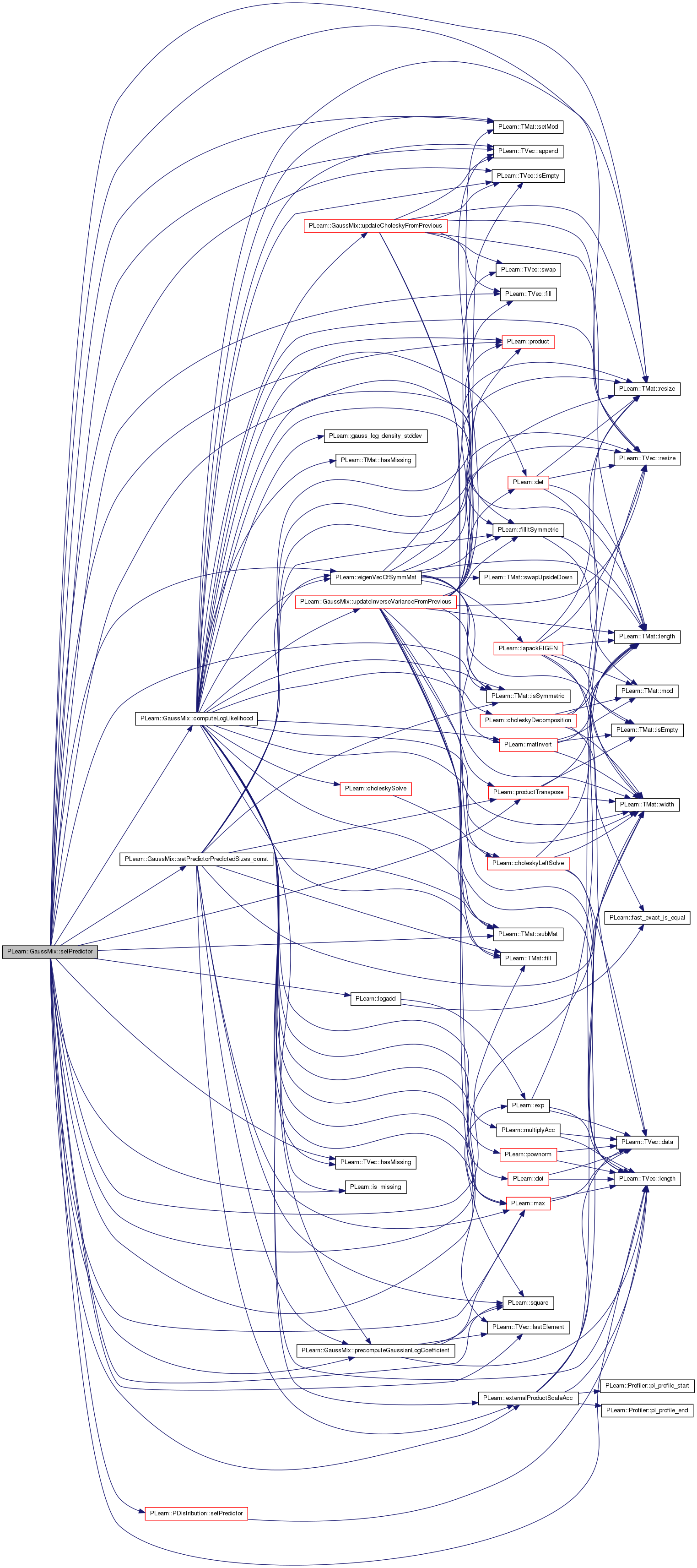

| bool PLearn::GaussMix::setPredictorPredictedSizes | ( | int | the_predictor_size, |
| int | the_predicted_size, | ||
| bool | call_parent = true |
||
| ) | [protected, virtual] |
In the 'general' conditional type, will precompute the covariance matrix of Y|x.
Reimplemented from PLearn::PDistribution.
Definition at line 3089 of file GaussMix.cc.
References PLearn::PDistribution::setPredictorPredictedSizes(), and setPredictorPredictedSizes_const().
Referenced by build_(), missingExpectation(), and train().
{
bool sizes_changed = false;
if (call_parent)
sizes_changed =
inherited::setPredictorPredictedSizes(n_i, n_t, call_parent);
setPredictorPredictedSizes_const();
return sizes_changed;
}
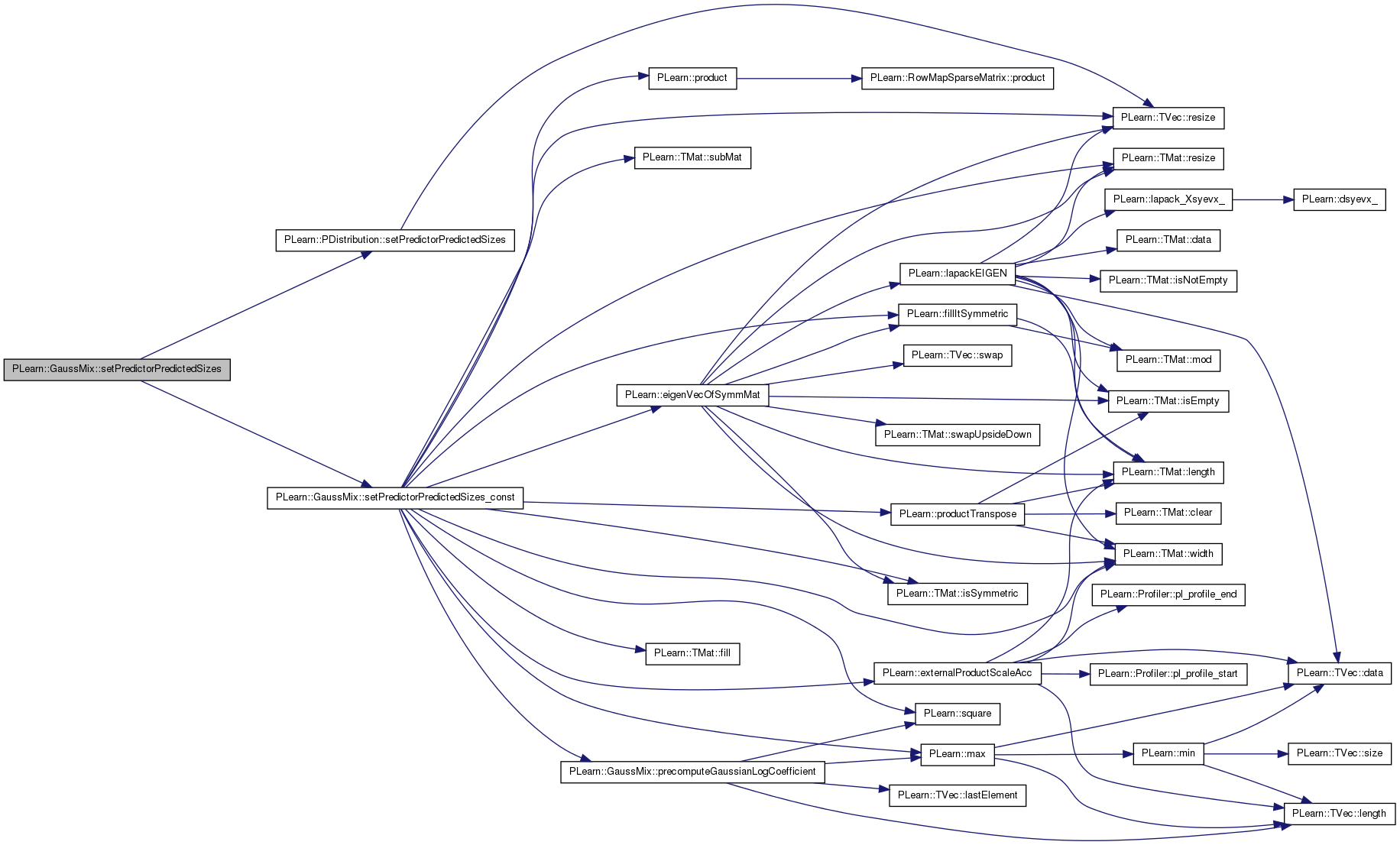

| void PLearn::GaussMix::setPredictorPredictedSizes_const | ( | ) | const [protected] |
Main implementation of 'setPredictorPredictedSizes', that needs to be 'const' as it currently needs to be called in setPredictor(..).
It does not take any parameter since it assumes the predictor and predicted sizes have been set already.
Definition at line 3103 of file GaussMix.cc.
References center_y_x, D, eigenvalues, eigenvalues_x, eigenvalues_y_x, PLearn::eigenVecOfSymmMat(), eigenvectors, eigenvectors_x, eigenvectors_y_x, PLearn::externalProductScaleAcc(), PLearn::TMat< T >::fill(), PLearn::fillItSymmetric(), i, PLearn::TMat< T >::isSymmetric(), j, L, log_coeff_x, log_coeff_y_x, PLearn::max(), n_eigen_computed, PLearn::PDistribution::n_predicted, PLearn::PDistribution::n_predictor, PLASSERT, precomputeGaussianLogCoefficient(), PLearn::product(), PLearn::productTranspose(), PLearn::TMat< T >::resize(), PLearn::TVec< T >::resize(), sigma_min, PLearn::square(), PLearn::TMat< T >::subMat(), TYPE_DIAGONAL, TYPE_GENERAL, type_id, TYPE_SPHERICAL, PLearn::TMat< T >::width(), and y_x_mat.
Referenced by setPredictor(), and setPredictorPredictedSizes().
{
static Mat inv_cov_x;
static Mat full_cov;
static Mat cov_y_x;
static Mat work_mat1, work_mat2;
static Mat cross_cov;
if (n_predictor == -1 || n_predicted == -1 || D == -1)
// Sizes are not defined yet, there is nothing we can do.
return;
if (type_id == TYPE_SPHERICAL || type_id == TYPE_DIAGONAL ) {
// Nothing to do.
} else {
PLASSERT( type_id == TYPE_GENERAL );
work_mat1.resize(n_predicted, n_predictor);
work_mat2.resize(n_predicted, n_predicted);
Vec eigenvals;
real var_min = square(sigma_min);
// Resize some data accordingly.
if (n_predictor >= 0)
eigenvalues_x.resize(L, n_predictor);
if (n_predicted >= 0)
{
center_y_x.resize(L, n_predicted);
eigenvalues_y_x.resize(L, n_predicted);
}
for (int j = 0; j < L; j++) {
// Compute the covariance of x and y|x for the j-th Gaussian (we
// will need them to compute the likelihood).
// First we compute the joint covariance matrix from the
// eigenvectors and eigenvalues:
// full_cov = sum_k (lambda_k - lambda0) v_k v_k' + lambda0.I
PLASSERT( n_predictor + n_predicted == D );
Mat& full_cov_j = full_cov;
full_cov_j.resize(D, D);
eigenvals = eigenvalues(j);
real lambda0 = max(var_min, eigenvals[n_eigen_computed - 1]);
full_cov_j.fill(0);
Mat& eigenvectors_j = eigenvectors[j];
PLASSERT( eigenvectors_j.width() == D );
for (int k = 0; k < n_eigen_computed - 1; k++)
externalProductScaleAcc(full_cov_j, eigenvectors_j(k),
eigenvectors_j(k),
max(var_min, eigenvals[k]) - lambda0);
for (int i = 0; i < D; i++)
full_cov_j(i,i) += lambda0;
// By construction, the resulting matrix is symmetric. However,
// it may happen that it is not exactly the case due to numerical
// approximations. Thus we ensure it is perfectly symmetric.
PLASSERT( full_cov_j.isSymmetric(false) );
fillItSymmetric(full_cov_j);
// Extract the covariance of the predictor x.
Mat cov_x_j = full_cov_j.subMat(0, 0, n_predictor, n_predictor);
// Compute its SVD.
eigenvectors_x[j].resize(n_predictor, n_predictor);
eigenvals = eigenvalues_x(j);
eigenVecOfSymmMat(cov_x_j, n_predictor, eigenvals, eigenvectors_x[j]);
// Note that the computation above will have destroyed 'cov_x_j',
// i.e. a part of the full covariance matrix.
log_coeff_x[j] =
precomputeGaussianLogCoefficient(eigenvals, n_predictor);
// And its inverse (we'll need it for the covariance of y|x).
inv_cov_x.resize(n_predictor, n_predictor);
inv_cov_x.fill(0);
if (n_predictor > 0) {
// I am not sure about this assert, but since we extract the
// covariance of x from a matrix whose eigenvalues are all more
// than 'var_min', it looks like the eigenvalues of the
// covariance of x should also be more than 'var_min'. If I am
// wrong, remove the assert and see if it is needed to
// potentially set lambda0 to var_min.
PLASSERT( eigenvals[n_predictor - 1] > var_min ||
eigenvals[n_predictor - 1] / var_min > 0.99 );
lambda0 = eigenvals[n_predictor - 1];
real one_over_lambda0 = 1 / lambda0;
Mat& eigenvectors_x_j = eigenvectors_x[j];
for (int k = 0; k < n_predictor - 1; k++)
externalProductScaleAcc(
inv_cov_x, eigenvectors_x_j(k), eigenvectors_x_j(k),
1 / max(var_min, eigenvals[k]) - one_over_lambda0);
for (int i = 0; i < n_predictor; i++)
inv_cov_x(i,i) += one_over_lambda0;
}
// Compute the covariance of y|x.
// It is only needed when there is a predictor part, since
// otherwise we can simply use the full covariance.
// TODO See if we can use simpler formulas.
Mat& cov_y_x_j = cov_y_x; // TODO Can we get rid of cov_y_x_j?
cov_y_x_j.resize(n_predicted, n_predicted);
cov_y_x_j <<
full_cov_j.subMat(n_predictor, n_predictor, n_predicted, n_predicted);
y_x_mat[j].resize(n_predicted, n_predictor);
if (n_predictor > 0) {
cross_cov = full_cov_j.subMat(n_predictor, 0,
n_predicted, n_predictor);
product(work_mat1, cross_cov, inv_cov_x);
productTranspose(work_mat2, work_mat1, cross_cov);
cov_y_x_j -= work_mat2;
y_x_mat[j] << work_mat1;
}
// Compute SVD of the covariance of y|x.
// TODO Note that if n_predictor == 0 (e.g. when using the Manifold
// Parzen algorithm), the covariance of y|x is also the full
// covariance, and thus we should instead re-use directly the
// (possibly few) eigenvectors of the full covariance matrix
// instead of wasting time and memory in the computations below.
eigenvectors_y_x[j].resize(n_predicted, n_predicted);
eigenvals = eigenvalues_y_x(j);
// Ensure covariance matrix is perfectly symmetric.
PLASSERT( cov_y_x_j.isSymmetric(false, true) );
fillItSymmetric(cov_y_x_j);
eigenVecOfSymmMat(cov_y_x_j, n_predicted, eigenvals, eigenvectors_y_x[j]);
log_coeff_y_x[j] =
precomputeGaussianLogCoefficient(eigenvals, n_predicted);
}
}
}
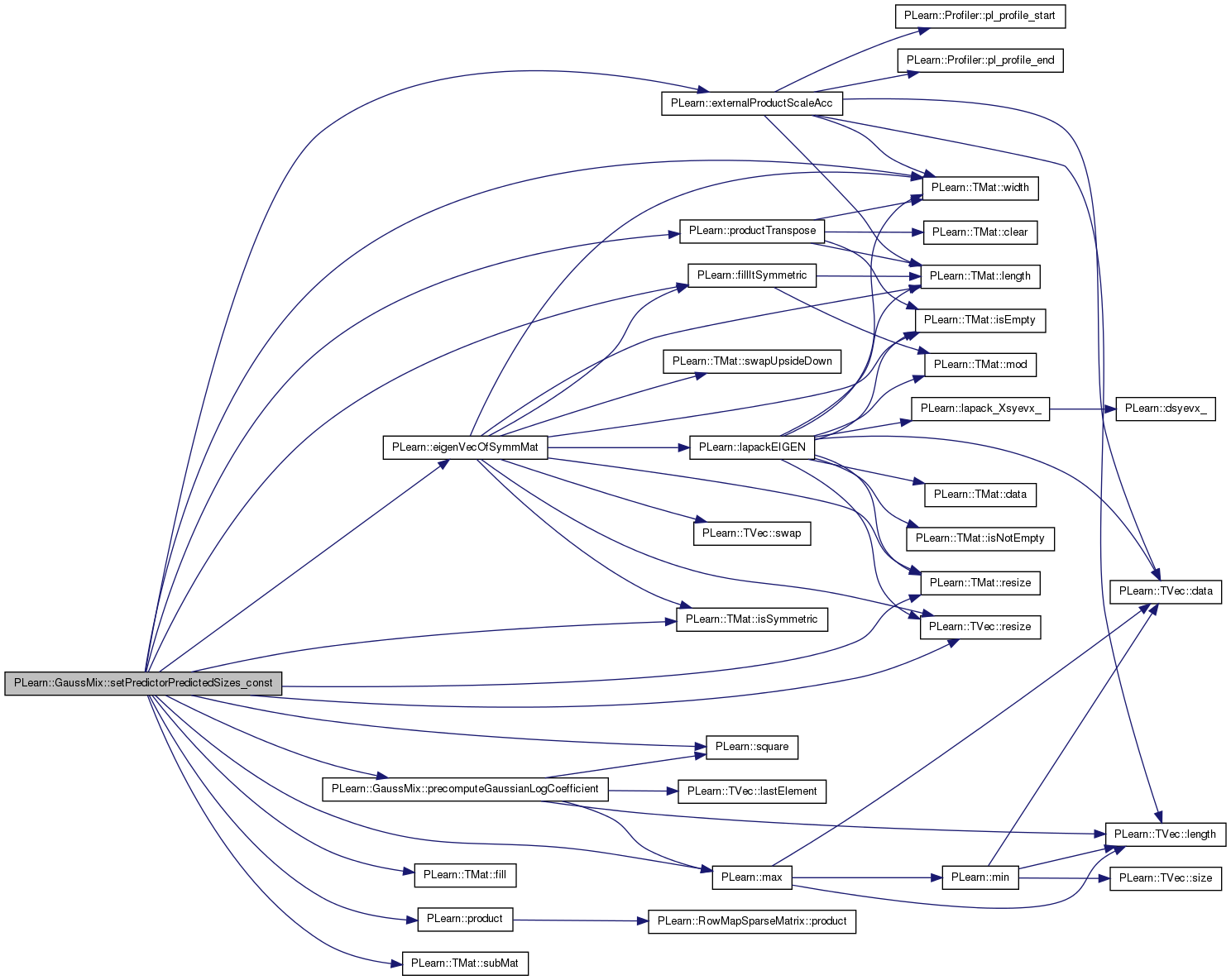

Overridden to reorder the dataset when efficient_missing == 2.
Reimplemented from PLearn::PLearner.
Definition at line 3237 of file GaussMix.cc.
References efficient_missing, i, PLearn::SelectRowsVMatrix::indices, PLearn::VMat::length(), PLearn::ReorderByMissingVMatrix::missing_pattern_change, need_recompute, original_to_reordered, PLearn::TVec< T >::resize(), and PLearn::PLearner::setTrainingSet().
{
if (efficient_missing != 2) {
inherited::setTrainingSet(training_set, call_forget);
return;
}
PP<ReorderByMissingVMatrix> reordered_training_set =
new ReorderByMissingVMatrix();
reordered_training_set->source = training_set;
reordered_training_set->build();
inherited::setTrainingSet((ReorderByMissingVMatrix*)reordered_training_set,
call_forget);
// Now fill in the vector that indicates when the matrices need to be
// recomputed.
need_recompute.resize(training_set->length());
need_recompute << reordered_training_set->missing_pattern_change;
original_to_reordered.resize(training_set->length());
for (int i = 0; i < training_set->length(); i++)
original_to_reordered[reordered_training_set->indices[i]] = i;
}
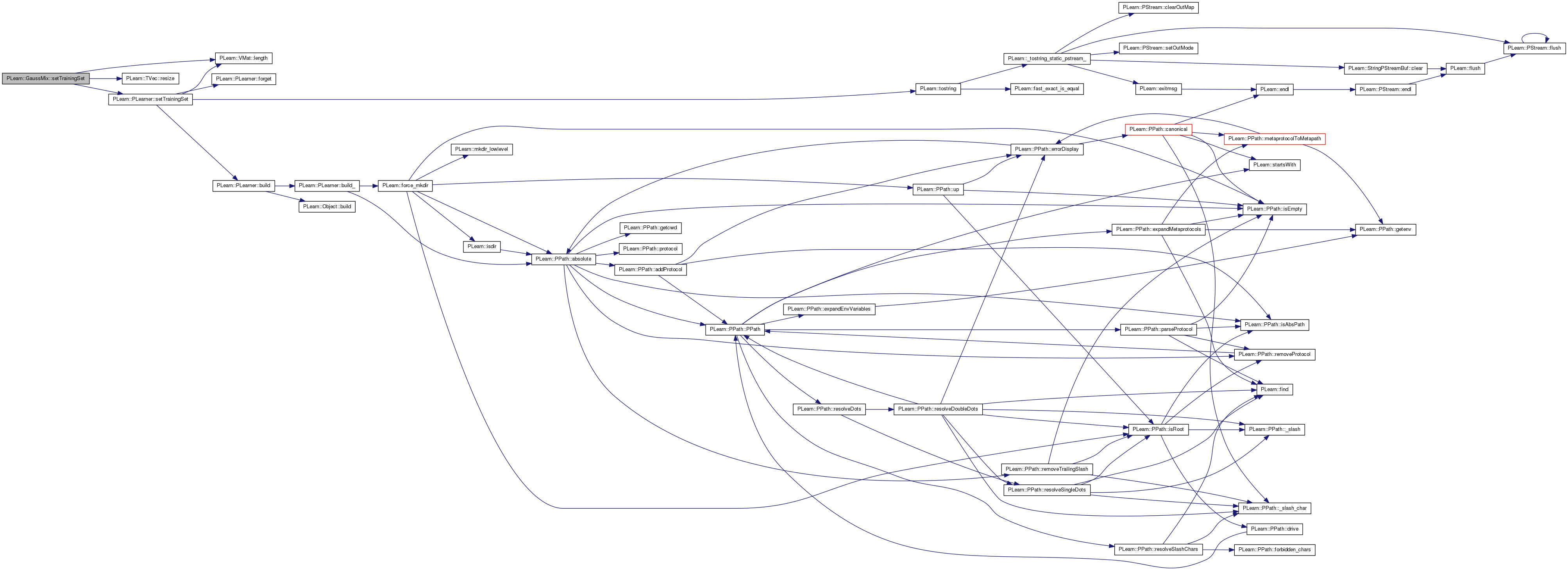
Return survival fn = P(Y>y | x).
Reimplemented from PLearn::PDistribution.
Definition at line 4391 of file GaussMix.cc.
References MISSING_VALUE.
{
//PLERROR("survival_fn not implemented for GaussMix"); return 0.0;
return MISSING_VALUE;
}
| void PLearn::GaussMix::train | ( | ) | [virtual] |
Trains the model.
Reimplemented from PLearn::PDistribution.
Reimplemented in PLearn::ManifoldParzen2, PLearn::ParzenWindow, and PLearn::RandomGaussMix.
Definition at line 3295 of file GaussMix.cc.
References PLearn::TVec< T >::append(), PLearn::TMat< T >::appendRow(), PLearn::argmin(), PLearn::TMat< T >::begin(), center, clusters_samp, PLearn::PRandom::common(), computeMeansAndCovariances(), computeMixtureWeights(), computePosteriors(), PLearn::create_list(), PLearn::TVec< T >::data(), PLearn::dist(), efficient_k_median, efficient_k_median_iter, efficient_missing, PLearn::endl(), PLearn::TVec< T >::fill(), PLearn::TMat< T >::fill(), PLearn::TVec< T >::find(), PLearn::flush(), PLearn::VMat::getExample(), getInitialWeightsFrom(), i, initial_weights, PLearn::PLearner::initTrain(), PLearn::is_missing(), PLearn::TVec< T >::isEmpty(), j, kmeans(), kmeans_iterations, L, PLearn::TMat< T >::length(), PLearn::TVec< T >::length(), PLearn::VMat::length(), PLearn::max(), max_samples_in_cluster, PLearn::min(), min_samples_in_cluster, missing_patterns, missing_template, n, nsamples, PLearn::PLearner::nstages, PLASSERT, PLERROR, posteriors, PLearn::pout, precomputeAllGaussianLogCoefficients(), PLearn::PDistribution::predicted_size, PLearn::PDistribution::predictor_size, ptimer, PLearn::PLearner::report_progress, PLearn::TVec< T >::resize(), PLearn::TMat< T >::resize(), resizeDataBeforeTraining(), resizeDataBeforeUsing(), sample_to_path_index, sample_to_template, setPredictorPredictedSizes(), spanning_can_free, spanning_path, spanning_use_previous, PLearn::PLearner::stage, PLearn::sum(), PLearn::TVec< T >::toMat(), PLearn::tostring(), PLearn::PLearner::train_set, PLearn::PLearner::train_stats, traverse_tree(), updateSampleWeights(), PLearn::PLearner::verbosity, w, and PLearn::TMat< T >::width().
{
ptimer->startTimer("training_time");
// Standard PLearner checks.
if (!initTrain())
return;
// When training, we want to learn the full joint distribution.
int backup_predicted_size = predicted_size;
int backup_predictor_size = predictor_size;
bool need_restore_sizes = setPredictorPredictedSizes(0, -1);
// Initialization before training.
if (stage == 0) {
ptimer->startTimer("init_time");
// Precompute nodes of the missing graph.
typedef boost::adjacency_list<boost::listS, boost::vecS,
boost::directedS, NoProperty, MissingFlag> BinaryBitsTree;
typedef boost::graph_traits<BinaryBitsTree>::vertex_iterator vertex_iter;
typedef boost::graph_traits<BinaryBitsTree>::vertex_descriptor vertex_descr;
typedef boost::graph_traits<BinaryBitsTree>::out_edge_iterator oedge_iter;
typedef boost::graph_traits<BinaryBitsTree>::edge_descriptor edge_descr;
typedef std::pair<oedge_iter, oedge_iter> oedge_iter_pair;
BinaryBitsTree tree(1);
const vertex_descr& root_vertex = *(boost::vertices(tree).first);
PP<ProgressBar> pb;
if ((efficient_missing == 1 || efficient_missing == 3)
&& report_progress)
pb = new ProgressBar("Finding unique missing patterns",
train_set->length());
Vec input, target;
real weight;
int n_unique = 0;
missing_patterns.resize(0, train_set->inputsize());
TVec<bool> pattern(train_set->inputsize());
sample_to_template.resize(train_set->length());
TVec< TVec<int> > pattern_to_samples;
for (int i = 0; (efficient_missing == 1 || efficient_missing == 3)
&& i < train_set->length(); i++) {
train_set->getExample(i, input, target, weight);
vertex_descr current_vertex = root_vertex;
for (int k = 0; k < input.length(); k++) {
bool bit = is_missing(input[k]);
pattern[k] = bit;
const oedge_iter_pair& oeiter_pair =
boost::out_edges(current_vertex, tree);
oedge_iter oeiter = oeiter_pair.first;
while (oeiter != oeiter_pair.second &&
tree[*oeiter].is_missing != bit) {
oeiter++;
}
if (oeiter == oeiter_pair.second) {
// Could not find this bit: need to create new vertex and
// edge.
const vertex_descr& new_vertex = boost::add_vertex(tree);
const edge_descr& new_edge =
boost::add_edge(current_vertex, new_vertex,tree).first;
tree[new_edge].is_missing = bit;
current_vertex = new_vertex;
if (k == input.length() - 1) {
// This is a leaf.
n_unique++;
missing_patterns.appendRow(pattern);
int index = missing_patterns.length() - 1;
tree[current_vertex].index = index;
pattern_to_samples.append(TVec<int>());
}
} else {
// We found an existing edge.
current_vertex = boost::target(*oeiter, tree);
}
if (k == input.length() - 1) {
// Leaf node.
// First step: each sample is assigned to its missing
// pattern.
int pattern_idx = tree[current_vertex].index;
sample_to_template[i] = pattern_idx;
pattern_to_samples[pattern_idx].append(i);
// pout << sample_to_template[i] << endl;
}
}
if (report_progress)
pb->update(i + 1);
}
//TVec<int> sample_to_pattern = sample_to_template.copy();
if ((efficient_missing == 1 || efficient_missing == 3)
&& verbosity >= 2)
pout << "Found " << n_unique << " unique missing patterns" << endl;
if (efficient_missing == 1 || efficient_missing == 3) {
// Perform some kind of k-median on missing patterns for initial
// clustering of missing patterns.
TVec<int> indices(0, missing_patterns.length() - 1, 1);
// TODO Use random_gen (but -> different k-means initialization)
PRandom::common(false)->shuffleElements(indices);
int n_clusters = min(efficient_k_median,
missing_patterns.length());
missing_template.resize(
n_clusters, missing_patterns.width());
TVec<int> missing_assign(missing_patterns.length(), -1);
for (int i = 0; i < n_clusters; i++) {
missing_template(i) << missing_patterns(indices[i]);
}
bool finished = false;
TVec<int> n_diffs(n_clusters);
int count_iter = 0;
if (report_progress)
pb = new ProgressBar("Performing k-median on " +
tostring(missing_patterns.length()) +
" missing patterns", efficient_k_median_iter);
TMat<int> majority(n_clusters, missing_patterns.width());
static TVec<int> n_assigned;
while (!finished && count_iter < efficient_k_median_iter) {
finished = true;
// Assign each missing pattern to closest template.
n_assigned.resize(n_clusters);
n_assigned.fill(0);
for (int i = 0; i < missing_patterns.length(); i++) {
n_diffs.fill(0);
for (int j = 0; j < n_clusters; j++)
for (int k = 0; k < missing_patterns.width(); k++)
if (missing_patterns(i, k) !=
missing_template(j, k))
n_diffs[j]++;
int new_assign = argmin(n_diffs);
if (new_assign != missing_assign[i])
finished = false;
missing_assign[i] = new_assign;
n_assigned[new_assign]++;
}
// Recompute missing templates.
majority.fill(0);
for (int i = 0; i < missing_patterns.length(); i++) {
int assign = missing_assign[i];
for (int k = 0; k < missing_patterns.width(); k++) {
if (missing_patterns(i, k))
majority(assign, k)++;
else
majority(assign, k)--;
}
}
for (int j = 0; j < n_clusters; j++) {
bool not_too_many_samples =
max_samples_in_cluster == -1 ||
n_assigned[j] <= max_samples_in_cluster;
bool not_too_few_samples =
n_assigned[j] >= min_samples_in_cluster ||
(n_clusters == 1) ||
n_assigned[j] == -1; // Newly created cluster.
bool is_valid_cluster = not_too_many_samples &&
not_too_few_samples &&
n_assigned[j] != -1;
if (is_valid_cluster) {
for (int k = 0; k < missing_template.width(); k++)
if (majority(j, k) > 0)
missing_template(j, k) = true;
else if (majority(j, k) < 0)
missing_template(j, k) = false;
else
// TODO Use random_gen (but be careful to effects,
// e.g. kmeans initialization).
missing_template(j, k) =
(PRandom::common(false)->uniform_sample() < 0.5);
} else if (!not_too_many_samples) {
// This cluster has too many points assigned to it
// (more than 'max_samples_in_cluster'). We split it in
// two, by picking two new centers, randomly chosen in
// this cluster.
static TVec<int> cluster_samples;
cluster_samples.resize(0);
for (int i = 0; i < missing_assign.length(); i++)
if (missing_assign[i] == j)
cluster_samples.append(i);
int center_1 =
PRandom::common(false)->uniform_multinomial_sample(cluster_samples.length());
missing_template(j) << missing_patterns(center_1);
bool found_valid_center_2 = false;
int center_2 = -1;
while (!found_valid_center_2) {
center_2 =
PRandom::common(false)->uniform_multinomial_sample(cluster_samples.length());
found_valid_center_2 = false;
for (int k = 0; k < missing_template.width(); k++)
if (missing_template(j, k) !=
missing_patterns(center_2, k)) {
found_valid_center_2 = true;
break;
}
}
n_clusters++;
majority.resize(n_clusters, majority.width());
n_diffs.resize(n_clusters);
n_assigned.resize(n_clusters);
n_assigned.last() = -1;
missing_template.resize(n_clusters,
missing_template.width());
missing_template(n_clusters - 1) <<
missing_patterns(center_2);
finished = false;
if (verbosity >= 10)
pout << "Cluster " << j << " split in two (" <<
n_assigned[j] << " > " <<
max_samples_in_cluster << "), there are now "
<< n_clusters << " clusters." << endl;
} else if (!not_too_few_samples) {
// This cluster has no point assigned to it.
// If we can merge it with an existing cluster, we do
// so, otherwise we assign its center to a new pattern
// chosen randomly in the patterns set.
int candidate = 0;
while (candidate < n_clusters) {
if (n_assigned[candidate] > 0 && candidate != j &&
(max_samples_in_cluster == -1 ||
n_assigned[candidate] + n_assigned[j] <=
max_samples_in_cluster)) {
// This candidate cluster can be added the
// points in the j-th cluster without violating
// the maximum number of samples constraint.
break;
}
candidate++;
}
if (candidate < n_clusters) {
// We have found a valid candidate: we can delete
// this cluster.
// Note that actually, we have no reason to believe
// that the samples in this cluster are going to be
// assigned to our candidate template.
n_assigned[candidate] += n_assigned[j];
n_clusters--;
for (int k = j; k < n_clusters; k++) {
n_assigned[k] = n_assigned[k + 1];
missing_template(k) << missing_template(k + 1);
}
n_assigned.resize(n_clusters);
missing_template.resize(n_clusters,
missing_template.width());
n_diffs.resize(n_clusters);
majority.resize(n_clusters, majority.width());
if (verbosity >= 10)
pout << "Cluster " << j << " deleted (" <<
n_assigned[j] << " < " <<
min_samples_in_cluster << "), there are now "
<< n_clusters << " clusters." << endl;
} else {
// No valid candidate: we reset this cluster
// randomly.
int random_pattern =
PRandom::common(false)->uniform_multinomial_sample(
missing_patterns.length());
missing_template(j) <<
missing_patterns(random_pattern);
missing_assign[random_pattern] = j;
if (verbosity >= 10)
pout << "Cluster " << j << " has been reset to"
<< " a random new center" << endl;
}
finished = false;
} else if (n_assigned[j] == -1) {
// Note: this case happens only for a newly created
// center (when we split a cluster in two).
finished = false;
}
}
count_iter++;
if (report_progress)
pb->update(count_iter);
}
if (finished && verbosity >= 2)
pout << "K-median stopped after only " << count_iter
<< " iterations" << endl;
if (finished && verbosity >= 5)
pout << "Number of points in each cluster: " << n_assigned
<< endl;
// Because right now we only want to perform updates, we need to
// make sure there will be no need for downdates.
/* Actually we can do downdates now!
for (int i = 0; i < missing_patterns.length(); i++) {
int assign = missing_assign[i];
for (int k = 0; k < missing_patterns.width(); k++)
if (missing_patterns(i, k))
missing_template(assign, k) = true;
}
*/
// Second step to fill 'sample_to_template'.
for (int i = 0; i < sample_to_template.length(); i++)
sample_to_template[i] = missing_assign[sample_to_template[i]];
// Fill in list for each cluster.
TVec< TVec<int> > clusters(missing_template.length());
for (int i = 0; i < missing_patterns.length(); i++)
clusters[missing_assign[i]].append(i);
TVec<int> parent;
// Fill in list for each sample.
// TODO Note: cluster_samp and sample_to_template may not really be
// useful.
clusters_samp.resize(missing_template.length());
for (int i = 0; i < clusters_samp.length(); i++)
clusters_samp[i].resize(0);
for (int i = 0; i < train_set->length(); i++)
// clusters_samp[missing_assign[sample_to_template[i]]].append(i);
clusters_samp[sample_to_template[i]].append(i);
if (efficient_missing == 1 || efficient_missing == 3) {
#ifdef DIRECTED_HACK
typedef boost::adjacency_list < boost::vecS, boost::vecS,
boost::directedS,
boost::property<boost::vertex_distance_t, int>,
boost::property<boost::edge_weight_t, int > > DistGraph;
#else
typedef boost::adjacency_list < boost::vecS, boost::vecS,
boost::undirectedS,
boost::property<boost::vertex_distance_t, int>,
boost::property<boost::edge_weight_t, int > > DistGraph;
#endif
// TODO According to
// http://boost-consulting.com/boost/libs/graph/doc/adjacency_matrix.html
// we should be using adjacency_matrix instead!
// TODO Do I really need all these properties? (in particular
// the vertex property?)
typedef std::pair<int, int> Edge;
spanning_path.resize(missing_template.length());
spanning_use_previous.resize(missing_template.length());
spanning_can_free.resize(missing_template.length());
for (int tpl = 0; tpl < missing_template.length(); tpl++) {
// Find minimum spanning tree of the missing patterns' graph.
TVec<int> cluster_tpl = clusters[tpl];
int n = cluster_tpl.length();
n = (n * (n - 1)) / 2;
if (report_progress && verbosity >= 2)
pb = new ProgressBar("Building graph of missing patterns",
n);
#ifdef DIRECTED_HACK
n *= 2;
#endif
TVec<int> weights(n);
TVec<Edge> edges(n);
weights.resize(0);
edges.resize(0);
int progress = 0;
/*
PStream out = openFile("/u/delallea/tmp/edges.amat",
PStream::raw_ascii, "w");
*/
for (int i = 0; i < cluster_tpl.length(); i++) {
for (int j = i + 1; j < cluster_tpl.length(); j++) {
edges.append( Edge(i, j) );
#ifdef DIRECTED_HACK
edges.append( Edge(j, i) );
#endif
int w = 0;
#ifdef DIRECTED_HACK
int w_minus = 0;
#endif
bool* missing_i = missing_patterns[cluster_tpl[i]];
bool* missing_j = missing_patterns[cluster_tpl[j]];
for (int k = 0; k < missing_patterns.width(); k++) {
if (*missing_i != *missing_j)
#ifdef DIRECTED_HACK
if (*missing_j)
w++;
else
w_minus++;
#else
w++;
#endif
missing_i++;
missing_j++;
}
#ifdef DIRECTED_HACK
weights.append(10 * w + w_minus);
weights.append(w + 10 * w_minus);
#else
weights.append(w);
#endif
/*
out << "E(" << i << ", " << j << "), ";
out << w << ", ";
*/
}
progress += cluster_tpl.length() - i - 1;
if (pb)
pb->update(progress);
}
// out.flush();
parent.resize(0);
if (edges.isEmpty()) {
parent.resize(1);
parent[0] = 0;
} else {
Edge* edges_ptr = edges.data();
DistGraph dist_graph(
edges_ptr,
edges_ptr + edges.length(),
weights.data(), cluster_tpl.length());
// boost::property_map<DistGraph, boost::edge_weight_t>::type
// weightmap = boost::get(boost::edge_weight, dist_graph);
typedef vector < boost::graph_traits <
DistGraph >::vertex_descriptor > Predec;
Predec pred(boost::num_vertices(dist_graph));
if (verbosity >= 2)
pout << "Computing minimum spanning tree... " << flush;
boost::prim_minimum_spanning_tree(dist_graph, &pred[0]);
if (verbosity >= 2)
pout << "Done" << endl;
// Convert 'pred' to a PLearn parent vector.
parent.resize(int(pred.size()));
for (std::size_t i = 0; i != pred.size(); i++)
parent[int(i)] = int(pred[i]);
/*
// Code to save the graph to display it in Matlab.
out = openFile("/u/delallea/tmp/tree.amat",
PStream::raw_ascii, "w");
for (int i = 0; i < parent.length(); i++)
if (parent[i] != i)
out << parent[i] + 1 << " ";
else
out << 0 << " ";
out = openFile("/u/delallea/tmp/weight.amat",
PStream::raw_ascii, "w");
for (int i = 0; i < parent.length(); i++) {
int j = parent[i];
// Looking for weight between nodes i and j.
int w = 0;
bool* missing_i = missing_patterns[cluster_tpl[i]];
bool* missing_j = missing_patterns[cluster_tpl[j]];
for (int k = 0; k < missing_patterns.width(); k++) {
if (*missing_i != *missing_j)
w++;
missing_i++;
missing_j++;
}
out << w << " ";
}
*/
// Free memory used by weights and edges.
weights = TVec<int>();
edges = TVec<Edge>();
}
#if 0
Mat parent_mat(1, parent.length());
for (int p = 0; p < parent.length(); p++)
parent_mat(0, p) = parent[p];
VMat parent_vm(parent_mat);
parent_vm->saveAMAT("/u/delallea/tmp/parent.amat", false,
true);
// Easy verification of cost.
int sum_add = 0;
int sum_min = 0;
for (int q = 0; q < parent.length(); q++) {
if (parent[q] == q)
continue;
TVec<bool> v1 = missing_patterns(q);
TVec<bool> v2 = missing_patterns(parent[q]);
for (int r = 0; r < v1.length(); r++) {
if (v1[r] && !v2[r])
sum_add++;
else if (!v1[r] && v2[r])
sum_min++;
}
}
pout << "Easy check: " << sum_add << " and " << sum_min <<
endl;
#endif
n = cluster_tpl.length();
#ifdef DIRECTED_HACK
#else
// Compute list of nodes, from top to bottom.
TVec<int> top_to_bottom;
TVec<int> status(n, 0);
PLASSERT( parent.length() == n );
// Status: 0 = still has a parent
// 1 = candidate with no parent
// 2 = done
TVec< TVec<int> > children(n);
for (int i = 0; i < parent.length(); i++)
if (parent[i] != i)
children[ parent[i] ].append(i);
else
status[int(i)] = 1;
// Ensure there is only a single one in the resulting tree.
PLASSERT( status.find(1, status.find(1) + 1) == -1 );
int count = 0;
// Now we're ready to loop over all elements.
while (true) {
int last_count = count;
bool loop = false;
// Find the next candidate with no parent.
while (status[count] != 1 &&
(!loop || count != last_count)) {
count++;
if (count >= n) {
count -= n;
loop = true;
}
}
if (count == last_count && loop) {
// We must have gone through all nodes.
PLASSERT( status.find(0) == -1 );
break;
}
status[count] = 2;
top_to_bottom.append(count);
TVec<int> child = children[count];
for (int i = 0; i < child.length(); i++) {
int j = child[i];
PLASSERT( status[j] == 0 );
status[j] = 1;
}
}
// Initialize messages.
TVec<int> message_up(n, 0);
TVec<int> message_down(n, 0);
// Upward pass of messages.
for (int i = n - 1; i >= 0; i--) {
int k = top_to_bottom[i];
TVec<int> child = children[k];
if (child.isEmpty())
// Leaf node.
continue;
int max = -1;
bool balanced = false;
for (int j = 0; j < child.length(); j++) {
int msg_up = message_up[child[j]];
if (msg_up > max) {
max = msg_up;
balanced = false;
} else if (msg_up == max)
balanced = true;
}
if (balanced)
max++;
PLASSERT( max >= 0 );
message_up[k] = max;
}
// Downward pass of messages.
for (int q = 0; q < n; q++) {
int j = top_to_bottom[q];
int i = parent[j];
TVec<int> brothers = children[i];
int max = -1;
bool balanced = false;
for (int k = 0; k < brothers.length(); k++) {
int brother_k = brothers[k];
if (brother_k == j)
// We do not consider this node.
continue;
int msg_up = message_up[brother_k];
if (msg_up > max) {
max = msg_up;
balanced = false;
} else if (msg_up == max)
balanced = true;
}
int msg_down = message_down[i];
if (msg_down > max) {
max = msg_down;
balanced = false;
} else if (msg_down == max)
balanced = true;
if (balanced)
max++;
// Note that 'max' can be zero when we have only one single
// point.
PLASSERT( max > 0 || n == 1);
message_down[j] = max;
}
// Compute the cost.
TVec<int> cost(n, -1);
for (int i = 0; i < n; i++) {
int msg_up = message_up[i];
int msg_down = message_down[i];
if (msg_up == msg_down)
cost[i] = msg_up + 1;
else
cost[i] = max(msg_up, msg_down);
}
int min_cost = min(cost);
if (verbosity >= 5)
pout << "Minimum cost: " << min_cost << endl;
// Find the node to start from.
int start_node = argmin(cost);
PLASSERT( cost[start_node] == min_cost );
#endif // DIRECTED_HACK
// Compute a node ordering giving rise to the mininum cost.
TVec<int>& span_path = spanning_path[tpl];
TVec<bool>& span_use_previous = spanning_use_previous[tpl];
TVec<bool>& span_can_free = spanning_can_free[tpl];
span_path.resize(0);
span_use_previous.resize(0);
span_can_free.resize(0);
// Note: 'free_previous' is set to 'false', meaning we might be
// using one more matrix than necessary. TODO Investigate
// exactly how this should be done.
#ifdef DIRECTED_HACK
// Compute list of nodes, in the order they will be visited in
// the optimization process. Note that this may not be optimal
// memory-wise.
TVec< TVec<int> > children(n);
// First find the root and fill the children lists.
int root = -1;
for (int i = 0; i < parent.length(); i++)
if (parent[i] == i)
root = i;
else
children[ parent[i] ].append(i);
PLASSERT( root >= 0 );
// Then deduce the ordered list of nodes.
create_list(parent, children, span_path, span_use_previous,
span_can_free, root, true, false);
#else
traverse_tree(span_path, span_can_free, span_use_previous,
false, true, start_node, -1, parent,
children, message_up, message_down);
#endif
PLASSERT( span_path.length() == n );
PLASSERT( span_can_free.length() == n );
PLASSERT( span_use_previous.length() == n );
// At this point the index in 'span_path' are the index within
// the cluster 'tpl': we replace them by the global sample
// index.
for (int i = 0; i < span_path.length(); i++)
span_path[i] = cluster_tpl[span_path[i]];
// Consistency check: compute the average distance from one
// node to the next in the path.
int sum = 0;
int counter = 0;
Vec stats_diff(missing_patterns.width() + 1);
stats_diff.fill(0);
for (int i = 0; i < span_path.length() - 1; i++) {
int first = span_path[i];
int next = span_path[i + 1];
int dist = 0;
for (int k = 0; k < missing_patterns.width(); k++)
if (missing_patterns(first, k) !=
missing_patterns(next, k))
dist++;
sum += dist;
counter ++;
stats_diff[dist]++;
}
real avg_dist = 0;
if (counter > 0)
avg_dist = sum / real(counter);
// TODO Note that the quantity below is not exactly what we're
// interested in: it does not take into account the fact that
// we come back in the tree (branch switching).
if (verbosity >= 5)
pout << "Average distance to next pattern: " << avg_dist
<< endl;
/*
Mat tomat = stats_diff.toMat(stats_diff.length(), 1);
VMat save_vmat(tomat);
save_vmat->saveAMAT("/u/delallea/tmp/span_" +
tostring(efficient_k_median) + ".amat", true, true);
*/
}
// Transform 'spanning_path' to obtain a path through samples,
// instead of a path through missing patterns.
// First get the list of samples associated to each missing
// pattern.
TVec<int> the_path;
TVec<bool> the_can_free;
TVec<bool> the_use_prev;
sample_to_path_index.resize(train_set->length());
sample_to_path_index.fill(-1);
for (int i = 0; i < spanning_path.length(); i++) {
TVec<int>& span_path = spanning_path[i];
TVec<bool>& span_can_free = spanning_can_free[i];
TVec<bool>& span_use_prev = spanning_use_previous[i];
the_path.resize(span_path.length());
the_can_free.resize(span_can_free.length());
the_use_prev.resize(span_use_prev.length());
the_path << span_path;
the_can_free << span_can_free;
the_use_prev << span_use_prev;
span_path.resize(0);
span_can_free.resize(0);
span_use_prev.resize(0);
int count = 0;
for (int j = 0; j < the_path.length(); j++) {
const TVec<int>& samples_list =
pattern_to_samples[the_path[j]];
span_path.append(samples_list);
span_can_free.append(the_can_free[j]);
span_use_prev.append(the_use_prev[j]);
for (int k = 0; k < samples_list.length(); k++) {
PLASSERT(sample_to_path_index[samples_list[k]]==-1);
sample_to_path_index[samples_list[k]] = count;
count++;
// Other samples with same pattern will reuse the
// same covariance matrix. However, right now, it
// is not completely efficient since the matrix
// will still be copied.
if (k > 0) {
span_can_free.append(true);
span_use_prev.append(true);
}
}
}
#ifdef BOUNDCHECK
int n_samples_in_cluster = clusters_samp[i].length();
PLASSERT( span_path.length() == n_samples_in_cluster );
PLASSERT( span_can_free.length() == n_samples_in_cluster );
PLASSERT( span_use_prev.length() == n_samples_in_cluster );
#endif
}
// Make sure all samples belong to a path.
PLASSERT( sample_to_path_index.find(-1) == -1 );
}
// Compute some statistics on the distances to templates.
#if 0
Vec current_vec, previous_vec;
Vec count_added(10000, real(0));
Vec count_removed(10000, real(0));
int max_added = 0;
int max_removed = 0;
int sum_added = 0;
int sum_removed = 0;
int counter_added = 0;
int counter_removed = 0;
map<int, int> current_to_previous;
TVec<int> is_there(train_set->length(), 0);
for (int i = 0; i < spanning_path.length(); i++) {
TVec<int>& span_path = spanning_path[i];
TVec<bool>& span_use_prev = spanning_use_previous[i];
TVec<bool>& span_can_free = spanning_can_free[i];
TVec<int> cached_nodes;
cached_nodes.append(0);
int queue_index = 0;
for (int k = 1; k < span_path.length(); k++) {
if (span_use_prev[k])
queue_index = cached_nodes.length() - 1;
else
queue_index = cached_nodes.length() - 2;
int previous = cached_nodes[queue_index];
int index_current = span_path[k];
train_set->getExample(index_current,
input, target, weight);
current_vec.resize(input.length());
current_vec << input;
int index_previous = span_path[previous];
train_set->getExample(index_previous, input,
target, weight);
previous_vec.resize(input.length());
previous_vec << input;
is_there[index_current] = 1;
is_there[index_previous] = 1;
int current_pattern = sample_to_pattern[index_current];
int previous_pattern = sample_to_pattern[index_previous];
if (current_pattern == previous_pattern ||
parent[current_pattern] == previous_pattern ||
parent[previous_pattern] == current_pattern)
{} else
{
PLERROR("Houston, we have a problem!");
}
if (current_pattern != previous_pattern)
current_to_previous[index_current] = index_previous;
int n_added = 0;
int n_removed = 0;
for (int q = 0; q < input.length(); q++) {
if (is_missing(current_vec[q])) {
if (!missing_patterns(current_pattern, q))
PLERROR("No way!");
} else if (missing_patterns(current_pattern, q))
PLERROR("Way no!");
if (is_missing(previous_vec[q]) &&
!is_missing(current_vec[q]))
n_added++;
else if (!is_missing(previous_vec[q]) &&
is_missing(current_vec[q]))
n_removed++;
}
count_added[n_added]++;
count_removed[n_removed]++;
sum_added += n_added;
sum_removed += n_removed;
counter_added++;
counter_removed++;
if (n_added > max_added)
max_added = n_added;
if (n_removed > max_removed)
max_removed = n_removed;
if (span_can_free[k])
cached_nodes.resize(queue_index);
else if (!span_use_prev[k])
cached_nodes.resize(cached_nodes.length() - 1);
cached_nodes.append(k);
}
}
if (is_there.find(0) != -1)
PLERROR("OMG!");
pout << "Mean added : " << sum_added << "/" << counter_added << " = "
<< sum_added / real(counter_added) << endl;
pout << "Mean removed: " << sum_removed << "/" << counter_removed << " = "
<< sum_removed / real(counter_removed) << endl;
Mat cur_to_prev(current_to_previous.size(), 2);
map<int, int>::const_iterator it = current_to_previous.begin();
int count_i = 0;
for (; it != current_to_previous.end(); it++, count_i++) {
if (it->first < it->second) {
cur_to_prev(count_i, 0) = it->first;
cur_to_prev(count_i, 1) = it->second;
} else {
cur_to_prev(count_i, 0) = it->second;
cur_to_prev(count_i, 1) = it->first;
}
}
PP<SortRowsVMatrix> cur_to_prev_vm = new SortRowsVMatrix();
cur_to_prev_vm->source = VMat(cur_to_prev);
cur_to_prev_vm->sort_columns = TVec<int>(0, 1, 1);
cur_to_prev_vm->build();
cur_to_prev_vm->saveAMAT("/u/delallea/tmp/cur_to_prev.amat",
false, true);
count_added.resize(max_added + 1);
count_removed.resize(max_removed + 1);
Mat added_mat = count_added.toMat(1, count_added.length());
Mat removed_mat = count_removed.toMat(1, count_removed.length());
VMat(added_mat)->saveAMAT("/u/delallea/tmp/added.amat", false,
true);
VMat(removed_mat)->saveAMAT("/u/delallea/tmp/removed.amat", false,
true);
/*
Vec stats_diff(missing_patterns.width());
stats_diff.fill(0);
for (int i = 0; i < missing_patterns.length(); i++) {
int assign = missing_assign[i];
int n_diffs = 0;
for (int k = 0; k < missing_patterns.width(); k++)
if (missing_patterns(i, k) != missing_template(assign, k))
n_diffs++;
stats_diff[n_diffs]++;
}
Mat tomat = stats_diff.toMat(stats_diff.length(), 1);
VMat save_vmat(tomat);
save_vmat->saveAMAT("/u/delallea/tmp/save_" +
tostring(efficient_k_median) + ".amat", true, true);
stats_diff.resize(missing_template.length());
stats_diff.fill(0);
for (int i = 0; i < missing_patterns.length(); i++) {
stats_diff[missing_assign[i]]++;
}
tomat = stats_diff.toMat(stats_diff.length(), 1);
save_vmat = VMat(tomat);
save_vmat->saveAMAT("/u/delallea/tmp/clust_" +
tostring(efficient_k_median) + ".amat", true, true);
Mat dist_mat(missing_template.length(),
missing_template.length());
for (int i = 0; i < missing_template.length(); i++) {
for (int j = 0; j < missing_template.length(); j++) {
int n_diffs = 0;
for (int k = 0; k < missing_template.width(); k++)
if (missing_template(i, k) != missing_template(j, k))
n_diffs++;
dist_mat(i, j) = n_diffs;
}
}
save_vmat = VMat(dist_mat);
save_vmat->saveAMAT("/u/delallea/tmp/dist_" +
tostring(efficient_k_median) + ".amat", true, true);
*/
#endif
}
// n_tries.resize(0); Old code, may be removed in the future...
resizeDataBeforeTraining();
// Get sample weights.
if (train_set->weightsize() <= 0)
initial_weights.fill(1);
else
getInitialWeightsFrom(train_set);
// Perform K-means to initialize the centers of the mixture.
TVec<int> clust_idx; // Store the cluster index for each sample.
kmeans(train_set, L, clust_idx, center, kmeans_iterations);
// Initialize posteriors: P(j | s_i) = 0 if s_i is not in the j-th
// cluster, and 1 otherwise.
posteriors.fill(0);
for (int i = 0; i < nsamples; i++)
posteriors(i, clust_idx[i]) = 1;
// Initialize everything from the K-Means clustering result.
updateSampleWeights();
computeMixtureWeights(false);
computeMeansAndCovariances();
precomputeAllGaussianLogCoefficients();
/*
Mat alpha_m(alpha.toMat(1, alpha.length()));
VMat alpha_vm(alpha_m);
alpha_vm->saveAMAT("/u/delallea/tmp/alpha.amat", false, true);
VMat center_vm(center);
center_vm->saveAMAT("/u/delallea/tmp/center.amat", false, true);
PLASSERT(eigenvalues.width() == D);
for (int j = 0; j < L; j++) {
Vec eigenvals = eigenvalues(j);
Mat& eigenvecs = eigenvectors[j];
Mat covar(D, D);
covar.fill(0);
for (int k = 0; k < D; k++)
externalProductScaleAcc(covar, eigenvecs(k), eigenvecs(k),
eigenvals[k]);
VMat covar_vm(covar);
string filename = "/u/delallea/tmp/covar_" + tostring(j) + ".amat";
covar_vm->saveAMAT(filename, false, true);
}
*/
ptimer->stopTimer("init_time");
}
PP<ProgressBar> pb;
int n_steps = nstages - stage;
if (report_progress)
pb = new ProgressBar("Training GaussMix", n_steps);
/*
TVec<Mat> save_center;
save_center.resize(L);
for (int i = 0; i < save_center.length(); i++)
save_center[i].resize(n_steps, D);
*/
int count_step = 0;
bool replaced_gaussian = false;
while (stage < nstages) {
do {
computePosteriors();
updateSampleWeights();
replaced_gaussian = computeMixtureWeights(true);
// Note: for debugging purpose, 'true' may be replaced by 'false'
// to ensure no Gaussian is removed.
} while (replaced_gaussian);
computeMeansAndCovariances();
precomputeAllGaussianLogCoefficients();
// for (int i = 0; i < save_center.length(); i++)
// save_center[i](count_step) << center(i);
count_step++;
stage++;
if (report_progress)
pb->update(n_steps - nstages + stage);
/*
if (verbosity >= 10)
pout << "Highest eigenvalue: " << max(eigenvalues) << endl;
*/
}
// Restore original predictor and predicted sizes if necessary.
if (need_restore_sizes) {
setPredictorPredictedSizes(backup_predictor_size,
backup_predicted_size);
// Because the sizes have changed, some data may need to be resized
// accordingly.
resizeDataBeforeUsing();
}
/*
for (int i = 0; i < save_center.length(); i++) {
VMat vm(save_center[i]);
vm->saveAMAT("save_center_" + tostring(i) + ".amat");
}
*/
ptimer->stopTimer("training_time");
static Vec train_stats_update;
train_stats_update.resize(2);
train_stats_update[0] = ptimer->getTimer("init_time");
train_stats_update[1] = ptimer->getTimer("training_time");
train_stats->forget(); // Forget potential old total training time.
train_stats->update(train_stats_update);
}
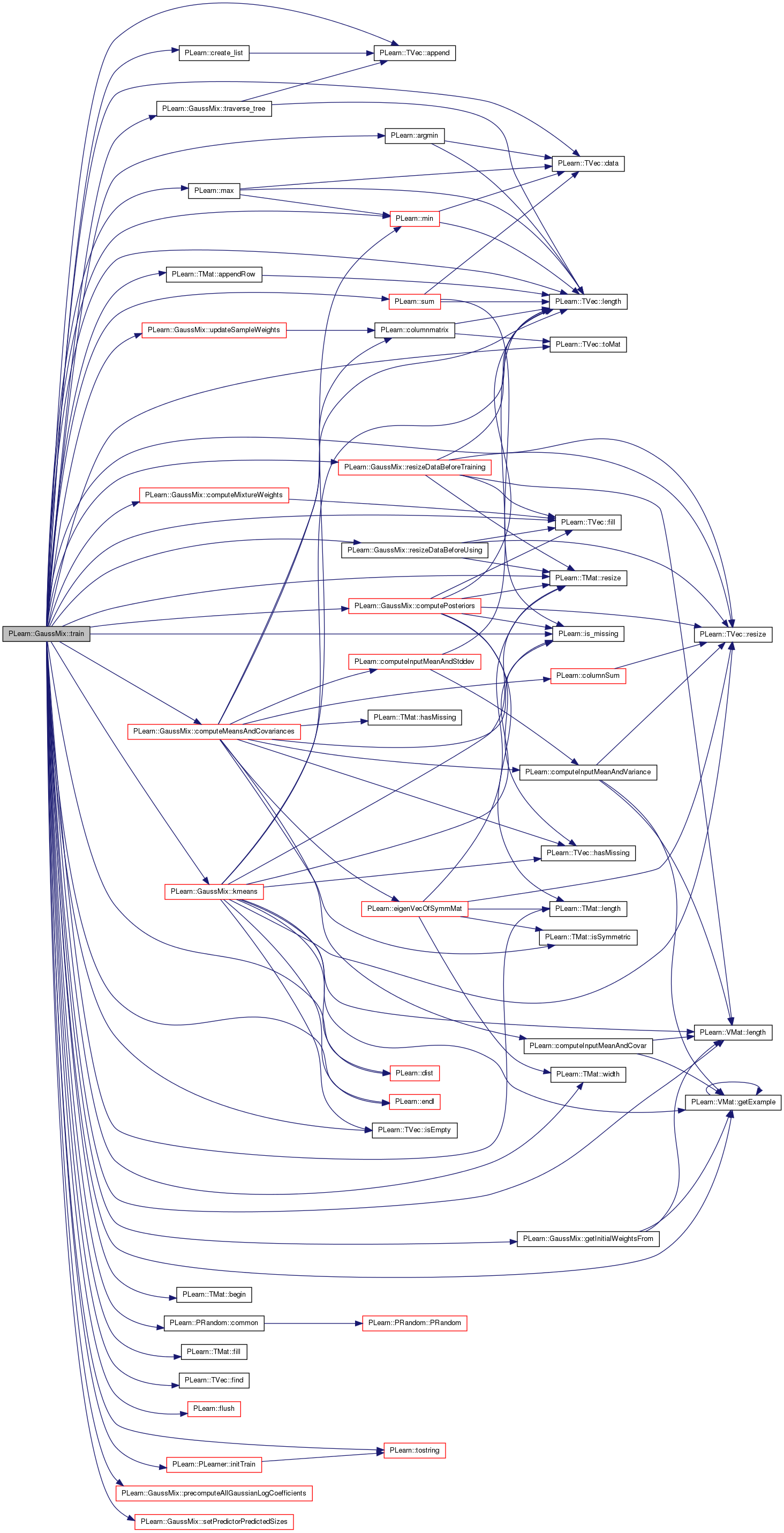
| void PLearn::GaussMix::traverse_tree | ( | TVec< int > & | path, |
| TVec< bool > & | span_can_free, | ||
| TVec< bool > & | span_use_previous, | ||
| bool | free_previous, | ||
| bool | use_previous, | ||
| int | index_node, | ||
| int | previous_node, | ||
| const TVec< int > & | parent, | ||
| const TVec< TVec< int > > & | children, | ||
| const TVec< int > & | message_up, | ||
| const TVec< int > & | message_down | ||
| ) | [static, protected] |
Recursive function to compute a spanning path from previously computed cost values (given by 'message_up' and 'message_down').
This function fills 'path' with the list of nodes to visit; it also fills 'span_can_free' and 'span_use_previous' with information about when to free memory and when to switch to another branch in the tree.
Definition at line 4300 of file GaussMix.cc.
References PLearn::TVec< T >::append(), i, j, PLearn::TVec< T >::length(), PLASSERT, and PLWARNING.
Referenced by train().
{
TVec<int> candidates;
TVec<int> messages;
TVec<int> child = children[index_node];
for (int i = 0; i < child.length(); i++)
if (child[i] != previous_node)
candidates.append(child[i]);
for (int i = 0; i < candidates.length(); i++)
messages.append(message_up[candidates[i]]);
if (parent[index_node] != index_node &&
parent[index_node] != previous_node)
{
candidates.append(parent[index_node]);
messages.append(message_down[parent[index_node]]);
}
if (child.length() > 1000)
PLWARNING("In GaussMix::traverse_tree - Should implement a faster "
"sorting algorithm");
path.append(index_node);
span_can_free.append(free_previous);
span_use_previous.append(use_previous);
for (int i = 0; i < candidates.length(); i++) {
int arg_min = i;
for (int j = i + 1; j < candidates.length(); j++)
if (messages[j] < messages[arg_min])
arg_min = j;
int tmp = messages[i];
messages[i] = messages[arg_min];
messages[arg_min] = tmp;
tmp = candidates[i];
candidates[i] = candidates[arg_min];
candidates[arg_min] = tmp;
int node = candidates[i];
PLASSERT( node != index_node && node != previous_node );
bool can_free = (i == candidates.length() - 1);
bool can_use_previous = (i == 0);
traverse_tree(path, span_can_free, span_use_previous, can_free,
can_use_previous, node, index_node, parent,
children, message_up, message_down);
}
}


| void PLearn::GaussMix::unknownOutput | ( | char | def, |
| const Vec & | input, | ||
| Vec & | output, | ||
| int & | k | ||
| ) | const [protected, virtual] |
Overridden so as to compute specific GaussMix outputs.
Reimplemented from PLearn::PDistribution.
Definition at line 4358 of file GaussMix.cc.
References j, L, log_density(), log_likelihood_dens, PLearn::PDistribution::predicted_part, PLearn::TVec< T >::resize(), and PLearn::PDistribution::unknownOutput().
{
switch(def) {
case 'p': // Log posteriors P(j | y).
{
output.resize(k + L);
// Compute p(y | x).
real log_p_y_x = log_density(predicted_part);
// This also fills the vector 'log_likelihood_dens' with likelihoods p(y,j | x),
// which is exactly what we need in order to compute the posteriors.
for (int j = 0; j < L; j++)
output[j + k] = log_likelihood_dens[j] - log_p_y_x;
k += L;
break;
}
default:
inherited::unknownOutput(def, input, output, k);
break;
}
}
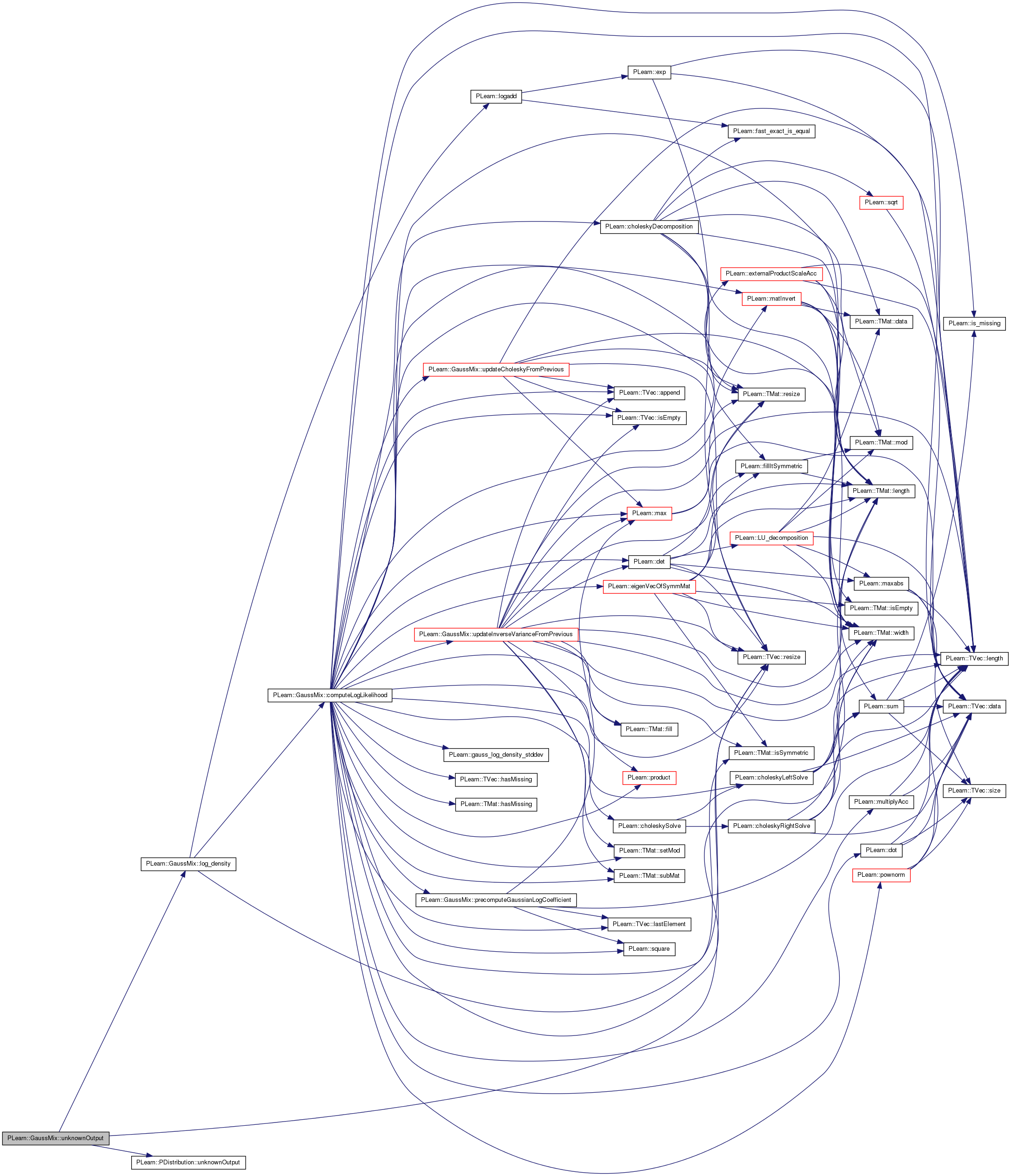
| void PLearn::GaussMix::updateCholeskyFromPrevious | ( | const Mat & | chol_previous, |
| Mat & | chol_updated, | ||
| const Mat & | full_matrix, | ||
| const TVec< int > & | indices_previous, | ||
| const TVec< int > & | indices_updated | ||
| ) | const [protected] |
Fill 'chol_updated' with the Cholesky decomposition of the submatrix of 'full_matrix' corresponding to the selection of dimensions given by 'indices_updated'.
This Cholesky decomposition is obtained from an existing previous Cholesky decomposition, given by 'chol_previous', and corresponding to another subset of dimensions of the full matrix, given by 'indices_previous'. Note that 'indices_updated' will be modified so that all dimensions common with 'indices_previous' will come first.
Definition at line 509 of file GaussMix.cc.
References PLearn::TVec< T >::append(), PLearn::choleskyAppendDimension(), PLearn::choleskyRemoveDimension(), PLearn::TVec< T >::fill(), i, PLearn::TVec< T >::isEmpty(), j, PLearn::TMat< T >::length(), PLearn::TVec< T >::length(), PLearn::max(), n, PLASSERT, PLearn::TMat< T >::resize(), PLearn::TVec< T >::resize(), and PLearn::TVec< T >::swap().
Referenced by computeLogLikelihood().
{
//Profiler::start("updateCholeskyFromPrevious");
static TVec<bool> is_previous;
static TVec<bool> is_updated;
static TVec<int> indices_new;
static Vec new_row;
PLASSERT( chol_previous.length() == indices_previous.length() );
if (indices_updated.isEmpty()) {
// All values are missing: the returned matrix should be empty.
chol_updated.resize(0, 0);
//Profiler::end("updateCholeskyFromPrevious");
return;
}
// Initialization.
int n = chol_previous.length();
int max_indice = -1;
if (!indices_previous.isEmpty())
max_indice = max(max_indice, max(indices_previous));
if (!indices_updated.isEmpty())
max_indice = max(max_indice, max(indices_updated));
PLASSERT( max_indice >= 0 );
is_updated.resize(max_indice + 1);
is_previous.resize(max_indice + 1);
is_updated.fill(false);
is_previous.fill(false);
indices_new.resize(0);
// Find which indices need to be kept or appended.
int p = indices_updated.length();
for (int i = 0; i < p; i++)
is_updated[indices_updated[i]] = true;
for (int i = 0; i < n; i++)
is_previous[indices_previous[i]] = true;
// Delete unused dimensions from the Cholesky decomposition.
//Profiler::start("updateCholeskyFromPrevious - Removing dimensions");
chol_updated.resize(n, n);
chol_updated << chol_previous;
for (int i = n - 1; i >= 0; i--) {
int dim_to_del = indices_previous[i];
if (is_updated[dim_to_del])
indices_new.append(dim_to_del);
else
choleskyRemoveDimension(chol_updated, i);
}
//Profiler::end("updateCholeskyFromPrevious - Removing dimensions");
// Need to swap 'indices_new' since these indices have been added in the
// opposite order.
indices_new.swap();
// Now add dimensions that were not here previously.
//Profiler::start("updateCholeskyFromPrevious - Adding dimensions");
for (int i = 0; i < p; i++)
if (!is_previous[indices_updated[i]]) {
int dim_to_add = indices_updated[i];
indices_new.append(dim_to_add);
int q = indices_new.length();
new_row.resize(q);
for (int j = 0; j < q; j++)
new_row[j] = full_matrix(dim_to_add, indices_new[j]);
choleskyAppendDimension(chol_updated, new_row);
}
//Profiler::end("updateCholeskyFromPrevious - Adding dimensions");
// Finally update the 'indices_updated' list.
indices_updated << indices_new;
//Profiler::end("updateCholeskyFromPrevious");
}
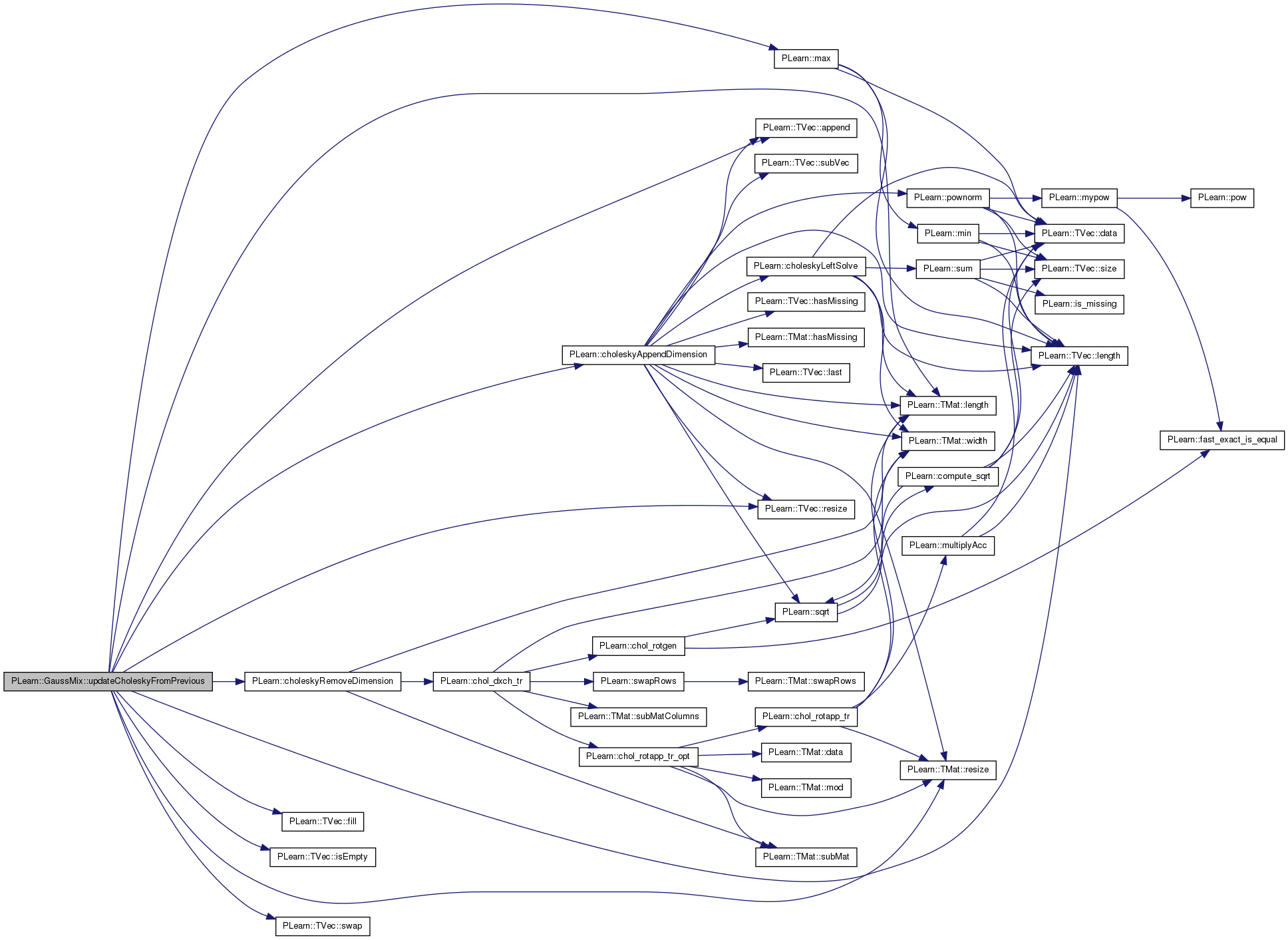

| void PLearn::GaussMix::updateInverseVarianceFromPrevious | ( | const Mat & | src, |
| Mat & | dst, | ||
| const Mat & | full, | ||
| const TVec< int > & | ind_src, | ||
| const TVec< int > & | ind_dst, | ||
| real * | src_log_det = 0, |
||
| real * | dst_log_det = 0 |
||
| ) | const [protected] |
Definition at line 585 of file GaussMix.cc.
References PLearn::TVec< T >::append(), PLearn::det(), PLearn::TVec< T >::fill(), PLearn::TMat< T >::fill(), PLearn::fillItSymmetric(), i, PLearn::TVec< T >::isEmpty(), PLearn::TMat< T >::isSymmetric(), j, PLearn::TMat< T >::length(), PLearn::TVec< T >::length(), PLearn::matInvert(), PLearn::max(), n, PLearn::negateElements(), PLearn::P(), PLASSERT, PLearn::product(), PLearn::productTranspose(), PLearn::TMat< T >::resize(), PLearn::TVec< T >::resize(), PLearn::selectColumns(), PLearn::selectRows(), PLearn::TMat< T >::setMod(), PLearn::TMat< T >::subMat(), PLearn::TVec< T >::subVec(), PLearn::transposeProduct(), and PLearn::TMat< T >::width().
Referenced by addToCovariance(), and computeLogLikelihood().
{
// The i-th element of 'is_src' ('is_dst') indicates whether the i-th
// dimension is in the 'ind_src'('ind_dst') vector.
static TVec<bool> is_src;
static TVec<bool> is_dst;
static TVec<int> dim_common; // List of common dimensions.
static TVec<int> dim_src_only; // List of dimensions only in 'src'.
static TVec<int> dim_dst_only; // List of dimensions only in 'dst'.
// List of dimensions in 'src' after it has been reordered so that the
// common dimensions are first.
static TVec<int> dim_reordered_src;
// A copy of the 'src' matrix, but whose dimensions have been swapped to
// match the order in 'dim_reordered_src'.
static Mat src_reordered;
// Temporary storage matrices.
static Mat tmp;
static Mat tmp2;
// This matrix will contain the inverse covariance corresponding to the
// removal of dimensions who do not appear in 'ind_dst' (thus, it is the
// final result if no dimension has to be added, otherwise it is just an
// intermediate result).
static Mat dst_only_removed;
// Matrix storing the bottom-right part of the reordered source matrix
// (corresponding to dimensions that need to be removed).
static Mat B3;
// Work matrices.
static Mat W;
static Mat P;
static Mat B;
// Safety checks.
PLASSERT( src.length() == ind_src.length() );
PLASSERT( (src_log_det && dst_log_det) ||
(!src_log_det && !dst_log_det) );
if (src_log_det)
// Initialize destination determinant to the source one.
*dst_log_det = *src_log_det;
int n = ind_src.length();
int p = ind_dst.length();
// int m = full.length();
dst.resize(p, p);
// Analyze the indices vectors.
int max_indice = -1;
if (!ind_src.isEmpty())
max_indice = max(max_indice, max(ind_src));
if (!ind_dst.isEmpty())
max_indice = max(max_indice, max(ind_dst));
// Note that 'max_indice' can be -1. This can currently happen if
// the first sample in a cluster has no missing value.
// In this case there is nothing to do: 'dst' will be empty.
is_dst.resize(max_indice + 1);
is_src.resize(max_indice + 1);
is_dst.fill(false);
is_src.fill(false);
for (int i = 0; i < p; i++)
is_dst[ind_dst[i]] = true;
for (int i = 0; i < n; i++)
is_src[ind_src[i]] = true;
// Build the source inverse covariance matrix where dimensions are
// reordered so that the first dimensions are those in common between
// source and destination.
dim_common.resize(0);
dim_src_only.resize(0);
dim_reordered_src.resize(n);
for (int i = 0; i < n; i++) {
if (is_dst[ind_src[i]])
dim_common.append(i);
else
dim_src_only.append(i);
}
dim_reordered_src.subVec(0, dim_common.length()) << dim_common;
dim_reordered_src.subVec(dim_common.length(), dim_src_only.length())
<< dim_src_only;
src_reordered.setMod(dim_reordered_src.length());
src_reordered.resize(dim_reordered_src.length(),
dim_reordered_src.length());
for (int i = 0; i < dim_reordered_src.length(); i++) {
int dim_reordered_src_i = dim_reordered_src[i];
src_reordered(i, i) = src(dim_reordered_src_i, dim_reordered_src_i);
for (int j = i + 1; j < dim_reordered_src.length(); j++) {
real elem_i_j = src(dim_reordered_src_i, dim_reordered_src[j]);
src_reordered(i, j) = elem_i_j;
src_reordered(j, i) = elem_i_j;
}
}
/* Old code doing the same thing.
tmp.resize(src.length(), dim_reordered_src.length());
// TODO Not efficient! Optimize!
selectColumns(src, dim_reordered_src, tmp);
src_reordered.resize(n, n);
selectRows(tmp, dim_reordered_src, src_reordered);
*/
// Remove the dimensions that are not present in the destination
// matrix.
int n_common = dim_common.length();
dst_only_removed.resize(n_common, n_common);
int n_src_only = dim_src_only.length();
if (n_src_only == 0) {
// Nothing to remove.
dst_only_removed << src_reordered;
} else {
// Compute the matrix corresponding to the removal of the dimensions
// that appear only in the source matrix.
PLASSERT( src_reordered.isSymmetric() );
Mat B1 = src_reordered.subMat(0, 0, n_common, n_common);
Mat B2 = src_reordered.subMat(0, n_common, n_common, n_src_only);
B3.setMod(n_src_only);
B3.resize(n_src_only, n_src_only);
B3 << src_reordered.subMat(n_common, n_common, n_src_only, n_src_only);
PLASSERT( B3.isSymmetric() );
dst_only_removed << B1;
tmp.resize(B3.length(), B3.width());
matInvert(B3, tmp);
// Another commented-out assert due to it possibly failing (numerical
// imprecisions).
// PLASSERT( tmp.isSymmetric(false) );
fillItSymmetric(tmp);
tmp2.resize(tmp.length(), B2.length());
productTranspose(tmp2, tmp, B2);
tmp.resize(B2.length(), tmp2.width());
product(tmp, B2, tmp2);
dst_only_removed -= tmp;
// Another commented-out assert due to it possibly failing (numerical
// imprecisions).
// PLASSERT( dst_only_removed.isSymmetric(false, true) );
fillItSymmetric(dst_only_removed);
// Update the log-determinant if needed.
if (src_log_det) {
//Profiler::start("det when removing");
*dst_log_det += det(src_reordered.subMat(n_common, n_common,
n_src_only, n_src_only),
true);
//Profiler::end("det when removing");
}
}
// At this point, the dimensions that are not present in the
// destination matrix have been removed. Now, we need to add the
// dimensions that need to be added (those that are present in the
// destination but not in the source).
dim_dst_only.resize(0);
for (int i = 0; i < p; i++)
if (!is_src[ind_dst[i]])
dim_dst_only.append(ind_dst[i]);
int n_dst_only = dim_dst_only.length();
// Reorder properly the indices in 'ind_dst': first the common indices,
// then those only in 'dst'.
for (int i = 0; i < n_common; i++)
ind_dst[i] = ind_src[dim_common[i]];
for (int i = 0; i < n_dst_only; i++)
ind_dst[i + n_common] = dim_dst_only[i];
// Replace dimensions in 'src' by dimensions in the full matrix.
for (int i = 0; i < dim_common.length(); i++)
dim_common[i] = ind_src[dim_common[i]];
if (n_dst_only == 0) {
// No dimension to add.
dst << dst_only_removed;
} else {
// TODO This is probably not very efficient, and could be optimized.
tmp.resize(full.length(), dim_dst_only.length());
selectColumns(full, dim_dst_only, tmp);
W.resize(dim_common.length(), tmp.width());
selectRows(tmp, dim_common, W);
P.resize(dim_dst_only.length(), tmp.width());
selectRows(tmp, dim_dst_only, P);
B.resize(W.width(), dst_only_removed.width());
transposeProduct(B, W, dst_only_removed);
tmp.setMod(W.width());
tmp.resize(B.length(), W.width());
// It can happen that n_common == 0, i.e. there are no common
// dimensions. In such a case, P contains the desired covariance.
if (n_common > 0) {
product(tmp, B, W);
negateElements(tmp);
} else
tmp.fill(0);
tmp += P;
tmp2.resize(tmp.length(), tmp.width());
// Commented-out as it may cause an unwanted crash.
// PLASSERT( tmp.isSymmetric(false, true) );
fillItSymmetric(tmp);
matInvert(tmp, tmp2);
// Commented-out as it may cause an unwanted crash.
// PLASSERT( tmp2.isSymmetric(false) );
fillItSymmetric(tmp2);
dst.subMat(n_common, n_common, n_dst_only, n_dst_only) << tmp2;
if (n_common > 0) {
tmp.resize(B.width(), tmp2.width());
transposeProduct(tmp, B, tmp2);
tmp2.resize(tmp.length(), B.width());
product(tmp2, tmp, B);
negateElements(tmp);
dst.subMat(0, n_common, n_common, n_dst_only) << tmp;
Mat dst_top_left = dst.subMat(0, 0, n_common, n_common);
dst_top_left << tmp2;
dst_top_left += dst_only_removed;
}
// Update the log-determinant if needed.
if (src_log_det) {
//Profiler::start("det when adding");
*dst_log_det -= det(dst.subMat(n_common, n_common,
n_dst_only, n_dst_only), true);
//Profiler::end("det when adding");
}
}
// Ensure 'dst' is symmetric, since we did not fill the bottom-left block.
fillItSymmetric(dst);
}
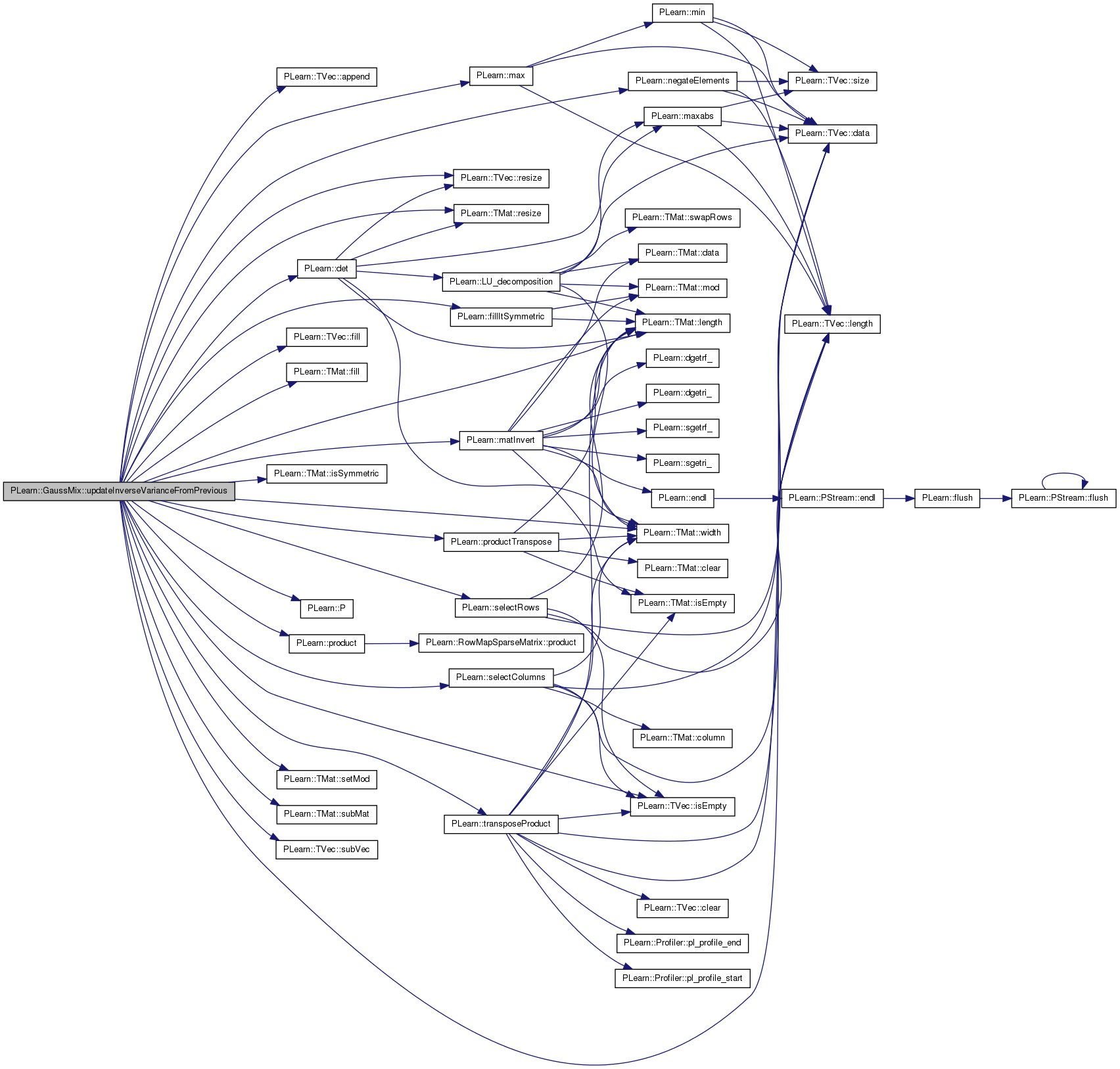

| void PLearn::GaussMix::updateSampleWeights | ( | ) | [protected] |
Update the sample weights according to their initial weights and the current posterior probabilities (see documentation of 'updated_weights' for the exact formula).
Definition at line 4381 of file GaussMix.cc.
References PLearn::TMat< T >::column(), PLearn::columnmatrix(), initial_weights, j, L, posteriors, and updated_weights.
Referenced by train().
{
for (int j = 0; j < L; j++) {
updated_weights(j) << initial_weights;
columnmatrix(updated_weights(j)) *= posteriors.column(j);
}
}


| void PLearn::GaussMix::variance | ( | Mat & | cov | ) | const [virtual] |
Compute Var[Y | x] (currently not implemented).
Reimplemented from PLearn::PDistribution.
Definition at line 4409 of file GaussMix.cc.
References PLERROR.
{
// TODO Variance could be at least implemented for L == 1.
PLERROR("variance not implemented for GaussMix");
}
Reimplemented from PLearn::PDistribution.
Reimplemented in PLearn::ManifoldParzen2, PLearn::ParzenWindow, and PLearn::RandomGaussMix.
Definition at line 457 of file GaussMix.h.
Definition at line 296 of file GaussMix.h.
Referenced by computeMixtureWeights(), computePosteriors(), declareOptions(), expectation(), generateFromGaussian(), log_density(), makeDeepCopyFromShallowCopy(), replaceGaussian(), resizeDataBeforeTraining(), setPredictor(), PLearn::ParzenWindow::train(), and PLearn::ManifoldParzen2::train().
Definition at line 278 of file GaussMix.h.
Referenced by computeMixtureWeights(), PLearn::ManifoldParzen2::declareOptions(), declareOptions(), and PLearn::RandomGaussMix::declareOptions().
Definition at line 297 of file GaussMix.h.
Referenced by build_(), computeLogLikelihood(), computeMeansAndCovariances(), PLearn::ManifoldParzen2::computeOutput(), declareOptions(), PLearn::ManifoldParzen2::evaluate_i_j(), expectation(), generateFromGaussian(), makeDeepCopyFromShallowCopy(), missingExpectation(), replaceGaussian(), resizeDataBeforeTraining(), setPredictor(), PLearn::ParzenWindow::train(), train(), and PLearn::ManifoldParzen2::train().
Mat PLearn::GaussMix::center_y_x [mutable, protected] |
Used to store the conditional expectation E[Y | X = x].
Definition at line 181 of file GaussMix.h.
Referenced by computeLogLikelihood(), expectation(), generateFromGaussian(), makeDeepCopyFromShallowCopy(), resizeDataBeforeUsing(), setPredictor(), and setPredictorPredictedSizes_const().
TVec<Mat> PLearn::GaussMix::chol_joint_cov [protected] |
The j-th element is the matrix L in the Cholesky decomposition S = L L' of the covariance matrix S of Gaussian j.
Definition at line 208 of file GaussMix.h.
Referenced by makeDeepCopyFromShallowCopy(), and resizeDataBeforeUsing().
TVec<Mat> PLearn::GaussMix::cholesky_queue [mutable, protected] |
The list of all cholesky decompositions (of covariance matrices) that need to be kept in memory during training.
Definition at line 113 of file GaussMix.h.
Referenced by computeLogLikelihood(), and makeDeepCopyFromShallowCopy().
TVec<Mat> PLearn::GaussMix::clust_imputed_missing [protected] |
TODO Document (the mats with the imputed missing values by each.
Definition at line 124 of file GaussMix.h.
Referenced by computeLogLikelihood(), computePosteriors(), makeDeepCopyFromShallowCopy(), and resizeDataBeforeTraining().
TVec< TVec<int> > PLearn::GaussMix::clusters_samp [protected] |
The k-th element is the list of samples in the k-th cluster.
Definition at line 109 of file GaussMix.h.
Referenced by makeDeepCopyFromShallowCopy(), and train().
TVec<Mat> PLearn::GaussMix::cond_var_inv_queue [mutable, protected] |
Definition at line 134 of file GaussMix.h.
Referenced by addToCovariance(), and makeDeepCopyFromShallowCopy().
Mat PLearn::GaussMix::covariance [protected] |
Storage for the (weighted) covariance matrix of the dataset.
It is only used with when type == "general".
Definition at line 248 of file GaussMix.h.
Referenced by computeMeansAndCovariances(), makeDeepCopyFromShallowCopy(), and resizeDataBeforeTraining().
int PLearn::GaussMix::current_cluster [protected] |
Index of the current cluster whose spanning path is being walked on during training.
Definition at line 76 of file GaussMix.h.
Referenced by addToCovariance(), computeLogLikelihood(), and computePosteriors().
int PLearn::GaussMix::current_training_sample [protected] |
Hack to know that we are compute likelihood on a training sample.
Definition at line 229 of file GaussMix.h.
Referenced by addToCovariance(), computeLogLikelihood(), computePosteriors(), and GaussMix().
int PLearn::GaussMix::D [protected] |
Definition at line 265 of file GaussMix.h.
Referenced by build_(), computeAllLogLikelihoods(), computeLogLikelihood(), computeMeansAndCovariances(), computePosteriors(), declareOptions(), forget(), precomputeAllGaussianLogCoefficients(), resizeDataBeforeTraining(), setPredictor(), setPredictorPredictedSizes_const(), and PLearn::ParzenWindow::train().
Mat PLearn::GaussMix::diags [protected] |
Definition at line 266 of file GaussMix.h.
Referenced by computeLogLikelihood(), computeMeansAndCovariances(), declareOptions(), generateFromGaussian(), makeDeepCopyFromShallowCopy(), replaceGaussian(), and resizeDataBeforeTraining().
Definition at line 279 of file GaussMix.h.
Referenced by declareOptions(), PLearn::RandomGaussMix::declareOptions(), and train().
Definition at line 280 of file GaussMix.h.
Referenced by declareOptions(), PLearn::RandomGaussMix::declareOptions(), and train().
Definition at line 281 of file GaussMix.h.
Referenced by computeLogLikelihood(), computePosteriors(), declareOptions(), PLearn::RandomGaussMix::declareOptions(), resizeDataBeforeTraining(), setTrainingSet(), and train().
Mat PLearn::GaussMix::eigenvalues [protected] |
Definition at line 267 of file GaussMix.h.
Referenced by build_(), computeLogLikelihood(), computeMeansAndCovariances(), declareOptions(), PLearn::ManifoldParzen2::evaluate(), PLearn::ManifoldParzen2::evaluate_i_j(), generateFromGaussian(), makeDeepCopyFromShallowCopy(), precomputeAllGaussianLogCoefficients(), replaceGaussian(), resizeDataBeforeTraining(), setPredictor(), setPredictorPredictedSizes_const(), and PLearn::ManifoldParzen2::train().
Mat PLearn::GaussMix::eigenvalues_x [mutable, protected] |
The eigenvalues of the covariance of X.
Definition at line 175 of file GaussMix.h.
Referenced by computeLogLikelihood(), makeDeepCopyFromShallowCopy(), resizeDataBeforeUsing(), and setPredictorPredictedSizes_const().
Mat PLearn::GaussMix::eigenvalues_y_x [mutable, protected] |
The eigenvalues of the covariance of Y|x.
Definition at line 178 of file GaussMix.h.
Referenced by computeLogLikelihood(), generateFromGaussian(), makeDeepCopyFromShallowCopy(), resizeDataBeforeUsing(), setPredictor(), and setPredictorPredictedSizes_const().
TVec<Mat> PLearn::GaussMix::eigenvectors [protected] |
Definition at line 268 of file GaussMix.h.
Referenced by computeLogLikelihood(), computeMeansAndCovariances(), PLearn::ManifoldParzen2::computeOutput(), declareOptions(), generateFromGaussian(), makeDeepCopyFromShallowCopy(), missingExpectation(), PLearn::ManifoldParzen2::outputsize(), replaceGaussian(), resizeDataBeforeTraining(), setPredictor(), setPredictorPredictedSizes_const(), and PLearn::ManifoldParzen2::train().
TVec<Mat> PLearn::GaussMix::eigenvectors_x [protected] |
The eigenvectors of the covariance of X.
Definition at line 174 of file GaussMix.h.
Referenced by computeLogLikelihood(), makeDeepCopyFromShallowCopy(), resizeDataBeforeUsing(), and setPredictorPredictedSizes_const().
TVec<Mat> PLearn::GaussMix::eigenvectors_y_x [protected] |
The eigenvectors of the covariance of Y|x.
Definition at line 177 of file GaussMix.h.
Referenced by computeLogLikelihood(), generateFromGaussian(), makeDeepCopyFromShallowCopy(), resizeDataBeforeUsing(), setPredictor(), and setPredictorPredictedSizes_const().
Definition at line 282 of file GaussMix.h.
Referenced by computeMeansAndCovariances(), PLearn::RandomGaussMix::declareOptions(), declareOptions(), and precomputeGaussianLogCoefficient().
TVec<Mat> PLearn::GaussMix::error_covariance [protected] |
Definition at line 159 of file GaussMix.h.
Referenced by computeMeansAndCovariances(), computePosteriors(), makeDeepCopyFromShallowCopy(), and resizeDataBeforeTraining().
Definition at line 283 of file GaussMix.h.
Referenced by build_(), declareOptions(), and resizeDataBeforeTraining().
TVec<Mat> PLearn::GaussMix::H3_inverse [protected] |
Definition at line 62 of file GaussMix.h.
Referenced by computeLogLikelihood(), computePosteriors(), makeDeepCopyFromShallowCopy(), and resizeDataBeforeTraining().
Definition at line 284 of file GaussMix.h.
Referenced by addToCovariance(), computeLogLikelihood(), computeMeansAndCovariances(), computePosteriors(), declareOptions(), PLearn::RandomGaussMix::declareOptions(), and resizeDataBeforeTraining().
TVec<VMat> PLearn::GaussMix::imputed_missing [protected] |
TODO Document (the VMats with the imputed missing values).
Definition at line 120 of file GaussMix.h.
Referenced by computeLogLikelihood(), computeMeansAndCovariances(), computePosteriors(), makeDeepCopyFromShallowCopy(), and resizeDataBeforeTraining().
TVec< TVec<int> > PLearn::GaussMix::indices_inv_queue [mutable, protected] |
Definition at line 146 of file GaussMix.h.
Referenced by addToCovariance(), and makeDeepCopyFromShallowCopy().
TVec< TVec<int> > PLearn::GaussMix::indices_queue [mutable, protected] |
The list of all lists of dimension indices (of covariance matrices) that need to be kept in memory during training.
More precisely, the i-th element is a vector that lists the indices of the dimensions in cholesky_queue[i] (since each Choleksy matrix is taken from a subset of all original dimensions - the ones for which the sample value is not missing).
Definition at line 142 of file GaussMix.h.
Referenced by computeLogLikelihood(), and makeDeepCopyFromShallowCopy().
Vec PLearn::GaussMix::initial_weights [protected] |
The initial weights of the samples s_i in the training set, copied for efficiency concerns.
Definition at line 167 of file GaussMix.h.
Referenced by getInitialWeightsFrom(), makeDeepCopyFromShallowCopy(), resizeDataBeforeTraining(), train(), and updateSampleWeights().
TVec<Mat> PLearn::GaussMix::joint_cov [mutable, protected] |
The j-th element is the full covariance matrix for Gaussian j.
It is needed only with the 'general' type, in presence of missing values.
Definition at line 201 of file GaussMix.h.
Referenced by computeLogLikelihood(), makeDeepCopyFromShallowCopy(), and resizeDataBeforeUsing().
TVec<Mat> PLearn::GaussMix::joint_inv_cov [mutable, protected] |
Definition at line 204 of file GaussMix.h.
Referenced by addToCovariance(), computeLogLikelihood(), makeDeepCopyFromShallowCopy(), and resizeDataBeforeUsing().
Definition at line 285 of file GaussMix.h.
Referenced by PLearn::ManifoldParzen2::declareOptions(), declareOptions(), PLearn::RandomGaussMix::declareOptions(), and train().
Definition at line 286 of file GaussMix.h.
Referenced by computeAllLogLikelihoods(), computeLogLikelihood(), computeMeansAndCovariances(), computeMixtureWeights(), computePosteriors(), PLearn::ManifoldParzen2::declareOptions(), declareOptions(), expectation(), generateFromGaussian(), log_density(), outputsize(), precomputeAllGaussianLogCoefficients(), resizeDataBeforeTraining(), resizeDataBeforeUsing(), setPredictor(), setPredictorPredictedSizes_const(), PLearn::ParzenWindow::train(), PLearn::ManifoldParzen2::train(), train(), unknownOutput(), and updateSampleWeights().
Vec PLearn::GaussMix::log_coeff [protected] |
The logarithm of the constant part in the joint Gaussian density: log(1/sqrt(2*pi^D * Det(C))).
This is a vector of length L (one coefficient for each Gaussian).
Definition at line 193 of file GaussMix.h.
Referenced by computeLogLikelihood(), makeDeepCopyFromShallowCopy(), precomputeAllGaussianLogCoefficients(), replaceGaussian(), and resizeDataBeforeUsing().
Vec PLearn::GaussMix::log_coeff_x [protected] |
The logarithm of the constant part in P(X) and P(Y | X = x), similar to what 'log_coeff' is for the joint distribution P(X,Y).
Definition at line 197 of file GaussMix.h.
Referenced by computeLogLikelihood(), makeDeepCopyFromShallowCopy(), resizeDataBeforeUsing(), and setPredictorPredictedSizes_const().
Vec PLearn::GaussMix::log_coeff_y_x [protected] |
Definition at line 197 of file GaussMix.h.
Referenced by computeLogLikelihood(), makeDeepCopyFromShallowCopy(), resizeDataBeforeUsing(), setPredictor(), and setPredictorPredictedSizes_const().
Vec PLearn::GaussMix::log_det_queue [mutable, protected] |
TODO Document (list of determinants of covariance matrices of the.
Definition at line 117 of file GaussMix.h.
Referenced by computeLogLikelihood(), and makeDeepCopyFromShallowCopy().
Vec PLearn::GaussMix::log_likelihood_dens [mutable, protected] |
Temporary storage vector.
Definition at line 251 of file GaussMix.h.
Referenced by log_density(), makeDeepCopyFromShallowCopy(), and unknownOutput().
Vec PLearn::GaussMix::log_likelihood_post [private] |
Temporary storage used when computing posteriors.
Definition at line 57 of file GaussMix.h.
Referenced by computePosteriors(), and makeDeepCopyFromShallowCopy().
Mat PLearn::GaussMix::log_likelihood_post_clust [protected] |
Used to store the likelihood given by all Gaussians for each sample in the current cluster.
Definition at line 106 of file GaussMix.h.
Referenced by computePosteriors(), and makeDeepCopyFromShallowCopy().
Vec PLearn::GaussMix::log_p_j_x [mutable, protected] |
The logarithm of P(j|x), where x is the predictor part.
Definition at line 184 of file GaussMix.h.
Referenced by forget(), log_density(), makeDeepCopyFromShallowCopy(), and setPredictor().
Definition at line 287 of file GaussMix.h.
Referenced by declareOptions(), and train().
Vec PLearn::GaussMix::mean_training [protected] |
Mean and standard deviation of the training set.
Definition at line 155 of file GaussMix.h.
Referenced by computeMeansAndCovariances(), kmeans(), makeDeepCopyFromShallowCopy(), and resizeDataBeforeTraining().
Definition at line 288 of file GaussMix.h.
Referenced by declareOptions(), and train().
TMat<bool> PLearn::GaussMix::missing_patterns [protected] |
All missing patterns found in the training set (stored in rows).
A boolean value of 'true' indicates that a feature is missing.
Definition at line 69 of file GaussMix.h.
Referenced by makeDeepCopyFromShallowCopy(), and train().
TMat<bool> PLearn::GaussMix::missing_template [protected] |
Missing patterns used as templates (obtained by k-median).
Definition at line 72 of file GaussMix.h.
Referenced by computePosteriors(), makeDeepCopyFromShallowCopy(), and train().
Definition at line 289 of file GaussMix.h.
Referenced by build_(), computeLogLikelihood(), PLearn::ManifoldParzen2::declareOptions(), declareOptions(), PLearn::RandomGaussMix::declareOptions(), resizeDataBeforeTraining(), and PLearn::ManifoldParzen2::train().
int PLearn::GaussMix::n_eigen_computed [protected] |
Definition at line 269 of file GaussMix.h.
Referenced by build_(), computeLogLikelihood(), computeMeansAndCovariances(), declareOptions(), forget(), generateFromGaussian(), resizeDataBeforeTraining(), setPredictor(), setPredictorPredictedSizes_const(), and PLearn::ManifoldParzen2::train().
TVec<bool> PLearn::GaussMix::need_recompute [protected] |
Definition at line 255 of file GaussMix.h.
Referenced by computeLogLikelihood(), makeDeepCopyFromShallowCopy(), and setTrainingSet().
TVec<bool> PLearn::GaussMix::no_missing_change [protected] |
TODO Document.
Definition at line 130 of file GaussMix.h.
Referenced by addToCovariance(), computeLogLikelihood(), makeDeepCopyFromShallowCopy(), and resizeDataBeforeTraining().
int PLearn::GaussMix::nsamples [protected] |
Definition at line 270 of file GaussMix.h.
Referenced by computeMeansAndCovariances(), computeMixtureWeights(), computePosteriors(), resizeDataBeforeTraining(), and train().
TVec<int> PLearn::GaussMix::original_to_reordered [protected] |
Definition at line 259 of file GaussMix.h.
Referenced by kmeans(), makeDeepCopyFromShallowCopy(), and setTrainingSet().
Vec PLearn::GaussMix::p_j_x [mutable, protected] |
The probability P(j|x), where x is the predictor part (it is computed by exp(log_p_j_x)).
Definition at line 188 of file GaussMix.h.
Referenced by expectation(), forget(), generateFromGaussian(), makeDeepCopyFromShallowCopy(), and setPredictor().
Mat PLearn::GaussMix::posteriors [protected] |
The posterior probabilities P(j | s_i), where j is the index of a Gaussian and i is the index of a sample.
Definition at line 163 of file GaussMix.h.
Referenced by computeMeansAndCovariances(), computeMixtureWeights(), computePosteriors(), makeDeepCopyFromShallowCopy(), train(), and updateSampleWeights().
bool PLearn::GaussMix::previous_predictor_part_had_missing [mutable, protected] |
A boolean indicating whether or not the last predictor part set through setPredictor(..) had a missing value.
Definition at line 241 of file GaussMix.h.
Referenced by setPredictor().
int PLearn::GaussMix::previous_training_sample [protected] |
Index of the previous training sample whose likelihood (and associated covariance matrix) has been computed.
If set to -1, there was no previous training sample (first sample in a cluster). If set to -2, we do not want to use the efficient missing algorithm at all.
Definition at line 237 of file GaussMix.h.
Referenced by addToCovariance(), computeLogLikelihood(), computePosteriors(), and GaussMix().
PP<PTimer> PLearn::GaussMix::ptimer [protected] |
Used to measure the total training time.
Definition at line 65 of file GaussMix.h.
Referenced by forget(), GaussMix(), makeDeepCopyFromShallowCopy(), and train().
Vec PLearn::GaussMix::sample_row [private] |
Definition at line 57 of file GaussMix.h.
Referenced by computePosteriors(), and makeDeepCopyFromShallowCopy().
TVec<int> PLearn::GaussMix::sample_to_path_index [protected] |
The i-th element is the index of the i-th training sample in the spanning path that contains it (i.e.
if sample_to_path_index[i] = k, then the i-th training sample is in k-th position in the spanning path that contains it).
Definition at line 82 of file GaussMix.h.
Referenced by addToCovariance(), computeLogLikelihood(), makeDeepCopyFromShallowCopy(), and train().
TVec<int> PLearn::GaussMix::sample_to_template [protected] |
The i-th element is the index of the missing template of sample i in the 'missing_template' matrix.
Definition at line 226 of file GaussMix.h.
Referenced by makeDeepCopyFromShallowCopy(), and train().
Definition at line 298 of file GaussMix.h.
Referenced by computeLogLikelihood(), computeMeansAndCovariances(), declareOptions(), generateFromGaussian(), makeDeepCopyFromShallowCopy(), replaceGaussian(), resizeDataBeforeTraining(), and PLearn::ParzenWindow::train().
Definition at line 290 of file GaussMix.h.
Referenced by computeLogLikelihood(), declareOptions(), PLearn::RandomGaussMix::declareOptions(), generateFromGaussian(), precomputeGaussianLogCoefficient(), setPredictor(), and setPredictorPredictedSizes_const().
TVec< TVec<bool> > PLearn::GaussMix::spanning_can_free [protected] |
The k-th element is a vector that indicates whether at each step in the spanning path of the k-th cluster, we should free the memory used by the previous covariance matrix (true), or we should instead keep this matrix for further use (false).
Here, the 'previous' covariance matrix will be either the one just before (if the boolean given by 'spanning_use_previous' is also true), or the one before it (if it is false).
Definition at line 102 of file GaussMix.h.
Referenced by addToCovariance(), computeLogLikelihood(), makeDeepCopyFromShallowCopy(), and train().
TVec< TVec<int> > PLearn::GaussMix::spanning_path [protected] |
The k-th element is the list of ordered samples in the spanning path for the k-th cluster.
Definition at line 86 of file GaussMix.h.
Referenced by computePosteriors(), makeDeepCopyFromShallowCopy(), and train().
TVec< TVec<bool> > PLearn::GaussMix::spanning_use_previous [protected] |
The k-th element is a vector that indicates whether at each step in the spanning path of the k-th cluster, a sample should use the previous covariance matrix computed in the path (true), or the one stored one step before it (false).
Intuitively, a value of false means we are switching to another branch in the spanning tree.
Definition at line 93 of file GaussMix.h.
Referenced by addToCovariance(), computeLogLikelihood(), makeDeepCopyFromShallowCopy(), and train().
TVec<int> PLearn::GaussMix::stage_joint_cov_computed [protected] |
The (i,j)-th element is the matrix L in the Cholesky decomposition of the covariance for the pattern of missing values of the i-th template for the j-th Gaussian.
Indicates at which stage the full joint covariance was computed in 'joint_cov' (so that we know there is no need to compute it again).
Definition at line 218 of file GaussMix.h.
Referenced by computeLogLikelihood(), makeDeepCopyFromShallowCopy(), replaceGaussian(), and resizeDataBeforeUsing().
TVec<int> PLearn::GaussMix::stage_replaced [protected] |
Indicates at which stage the j-th Gaussian has been replaced (due to having a too low coefficient alpha[j] < alpha_min).
Definition at line 222 of file GaussMix.h.
Referenced by computeMixtureWeights(), forget(), makeDeepCopyFromShallowCopy(), and resizeDataBeforeTraining().
Vec PLearn::GaussMix::stddev_training [protected] |
Definition at line 155 of file GaussMix.h.
Referenced by computeMeansAndCovariances(), kmeans(), makeDeepCopyFromShallowCopy(), and resizeDataBeforeTraining().
Vec PLearn::GaussMix::sum_of_posteriors [protected] |
TODO Document (sum of all posteriors in computePosteriors()).
Definition at line 127 of file GaussMix.h.
Referenced by computeMeansAndCovariances(), computePosteriors(), and makeDeepCopyFromShallowCopy().
| string PLearn::GaussMix::type |
Definition at line 291 of file GaussMix.h.
Referenced by build_(), PLearn::RandomGaussMix::declareOptions(), PLearn::ManifoldParzen2::declareOptions(), declareOptions(), PLearn::ManifoldParzen2::ManifoldParzen2(), and PLearn::ParzenWindow::train().
int PLearn::GaussMix::type_id [protected] |
Set at build time, this integer value depends uniquely on the 'type' option.
It is meant to avoid too many useless string comparisons.
Definition at line 150 of file GaussMix.h.
Referenced by build_(), computeLogLikelihood(), computeMeansAndCovariances(), expectation(), generateFromGaussian(), missingExpectation(), precomputeAllGaussianLogCoefficients(), replaceGaussian(), resizeDataBeforeTraining(), resizeDataBeforeUsing(), setPredictor(), and setPredictorPredictedSizes_const().
Mat PLearn::GaussMix::updated_weights [protected] |
A matrix whose j-th line is a Vec with the weights of each sample s_i for Gaussian j, i.e.
the initial weight of s_i multiplied by the posterior P(j | s_i).
Definition at line 172 of file GaussMix.h.
Referenced by computeMeansAndCovariances(), makeDeepCopyFromShallowCopy(), and updateSampleWeights().
Vec PLearn::GaussMix::y_centered [mutable, protected] |
Storage vector to save some memory allocations.
Definition at line 244 of file GaussMix.h.
Referenced by computeLogLikelihood(), and makeDeepCopyFromShallowCopy().
TVec<Mat> PLearn::GaussMix::y_x_mat [protected] |
The product K2 * K1^-1 to compute E[Y|x].
Definition at line 176 of file GaussMix.h.
Referenced by makeDeepCopyFromShallowCopy(), resizeDataBeforeUsing(), setPredictor(), and setPredictorPredictedSizes_const().
 1.7.4
1.7.4